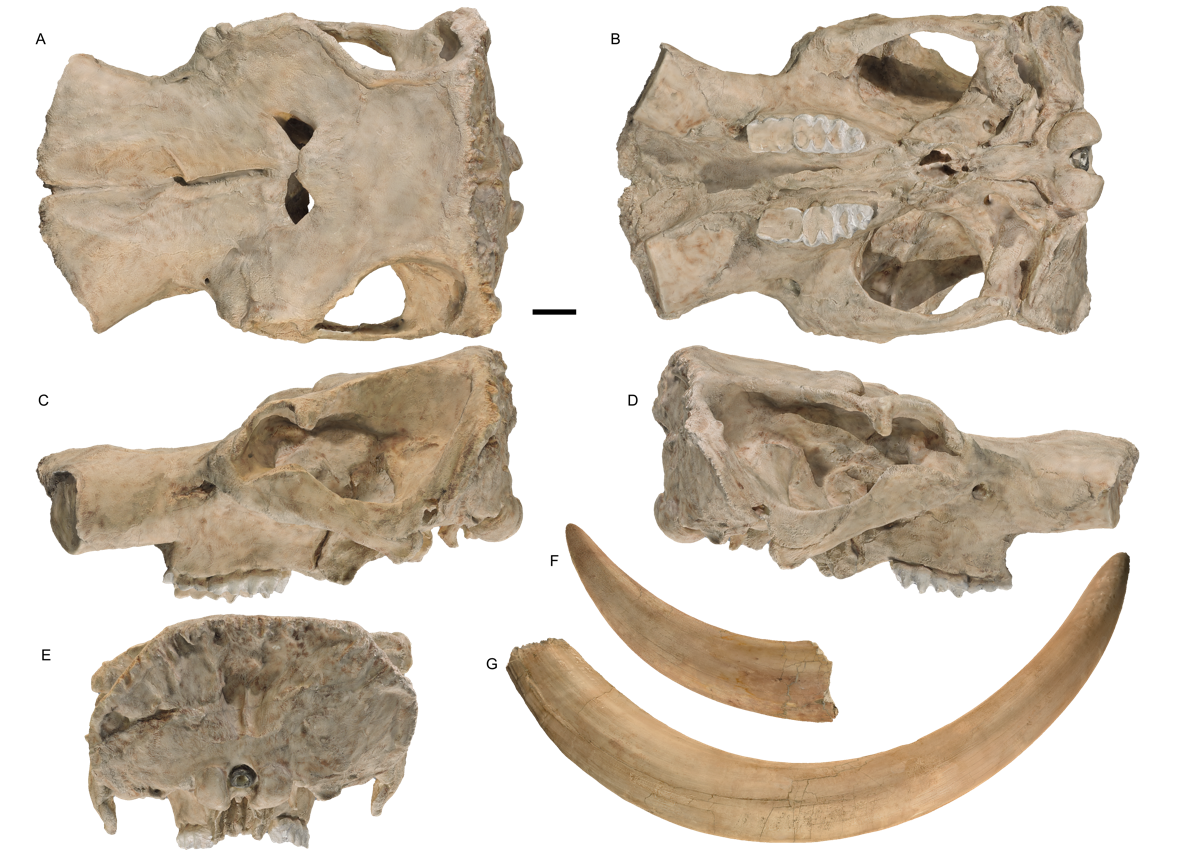 The big news this week for Western Science Center was the naming of a new species of mastodon, Mammut pacificus.For decades, the consensus on Pleistocene mastodons (which I shared) was that in North America there was only a single, widespread species, Mammut americanum. Four years ago, I stumbled across the fact that California mastodons have different tooth proportions than other mastodons. A group of us started exploring that issue, trying to determine what was going on. To that end, in 2016 we launched a crowdfunding campaign on experiment.com to allow us to gather mastodon measurements from other parts of the continent. Exploring this problem continued through the Valley of the Mastodons symposium in 2017. Sometime in late 2017, we started to consider the possibility that we were seeing these differences because we were dealing with two different species, and by mid-2018 we started working on a manuscript. It was finally published last Wednesday.So, what makes the Pacific mastodon different from the American mastodon? Here are the major characters:-- Mammut pacificus has narrower teeth than M. americanum, especially the 3rd molars. On the left below is a lower third molar from Max, and on the right is the same tooth from an American mastodon from Ohio (from the Cincinnati Museum of Natural History and Science).
The big news this week for Western Science Center was the naming of a new species of mastodon, Mammut pacificus.For decades, the consensus on Pleistocene mastodons (which I shared) was that in North America there was only a single, widespread species, Mammut americanum. Four years ago, I stumbled across the fact that California mastodons have different tooth proportions than other mastodons. A group of us started exploring that issue, trying to determine what was going on. To that end, in 2016 we launched a crowdfunding campaign on experiment.com to allow us to gather mastodon measurements from other parts of the continent. Exploring this problem continued through the Valley of the Mastodons symposium in 2017. Sometime in late 2017, we started to consider the possibility that we were seeing these differences because we were dealing with two different species, and by mid-2018 we started working on a manuscript. It was finally published last Wednesday.So, what makes the Pacific mastodon different from the American mastodon? Here are the major characters:-- Mammut pacificus has narrower teeth than M. americanum, especially the 3rd molars. On the left below is a lower third molar from Max, and on the right is the same tooth from an American mastodon from Ohio (from the Cincinnati Museum of Natural History and Science).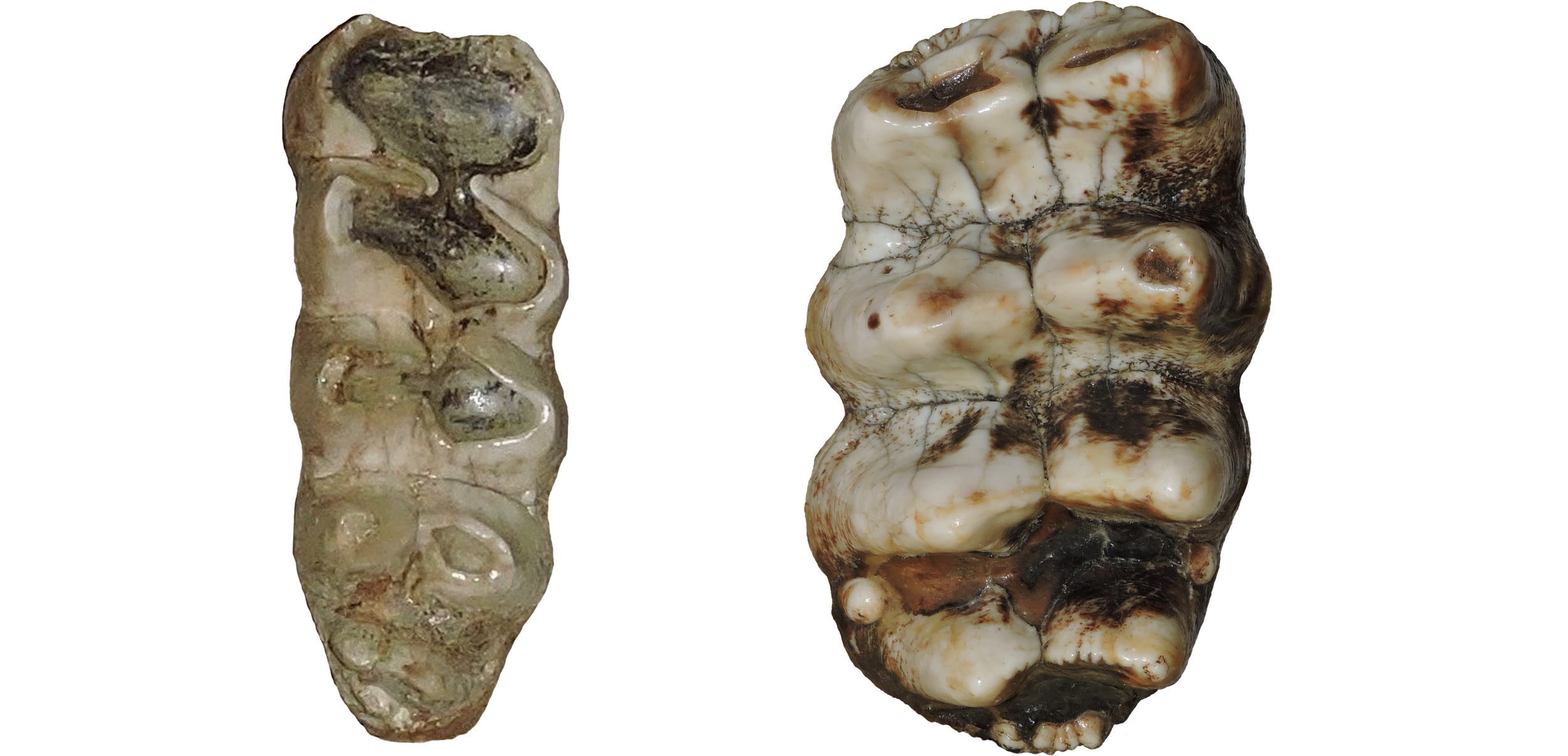 This trend is present in every tooth position except the upper 2nd molars, although we had the best statistical support for the 3rd molars.-- Mammut pacificus has six sacral vertebrae, while M. americanum usually has five. There has been one American mastodon reported with six sacrals, and another reported with four (although I have not personally seen either of these specimens), but all the other specimens for which we could get data (five of them) have five sacrals. All three known M. pacificus sacrals, including the one below from Diamond Valley Lake, have six.
This trend is present in every tooth position except the upper 2nd molars, although we had the best statistical support for the 3rd molars.-- Mammut pacificus has six sacral vertebrae, while M. americanum usually has five. There has been one American mastodon reported with six sacrals, and another reported with four (although I have not personally seen either of these specimens), but all the other specimens for which we could get data (five of them) have five sacrals. All three known M. pacificus sacrals, including the one below from Diamond Valley Lake, have six.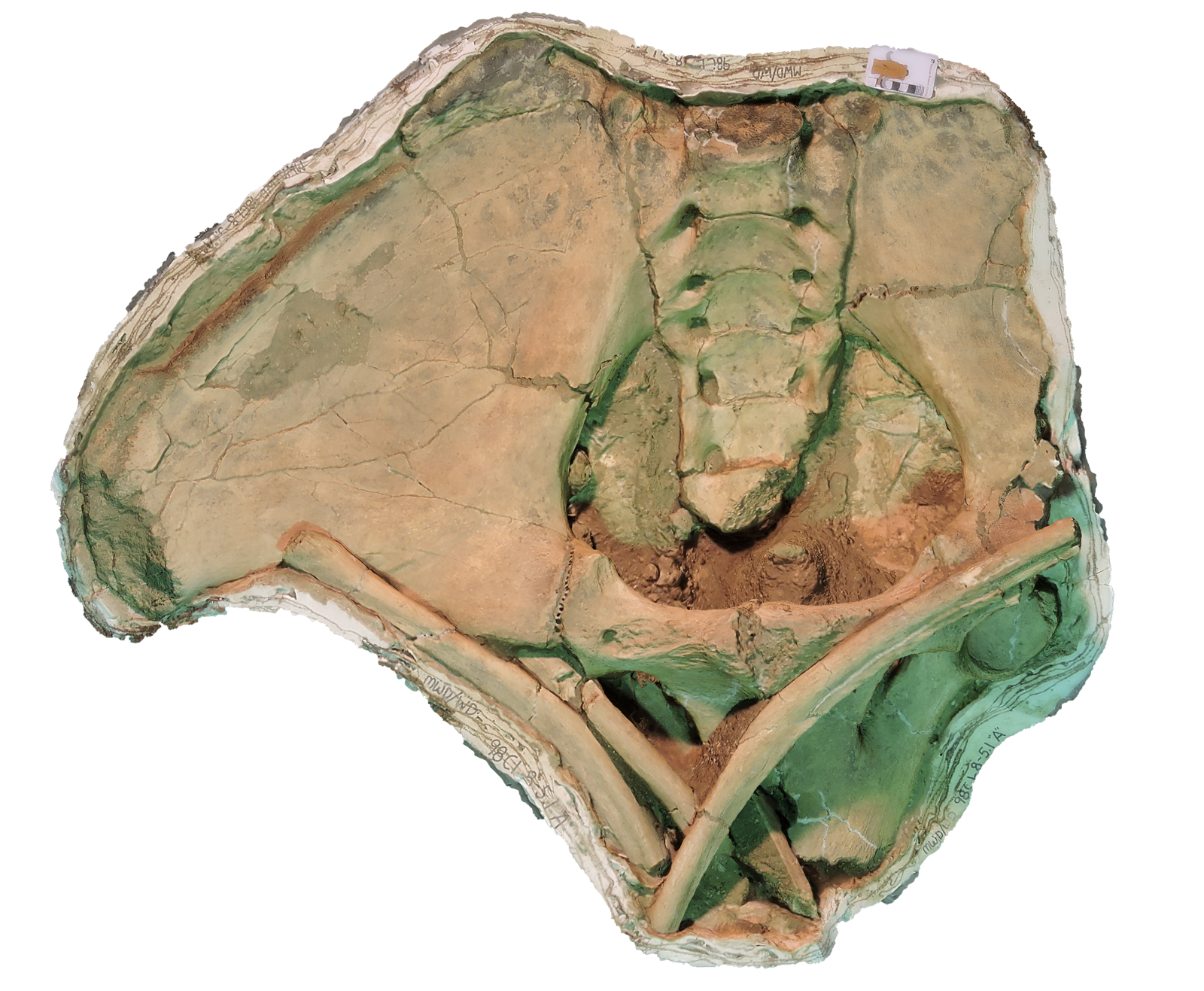 -- Mammut pacificus has a thicker femur for a given length. This is a feature we need to explore further, but our data is a bit limited. The trends we see suggest that not only do Pacific mastodons have thicker femora, but that the difference becomes more pronounced with larger body size. However, we don't have any really big M. pacificus femora to confirm this (Max's femur is incomplete). Below, "Little Stevie's" femur from DVL is on the left, compared to an American mastodon specimen from Ohio (again, from the Cincinnati Museum).
-- Mammut pacificus has a thicker femur for a given length. This is a feature we need to explore further, but our data is a bit limited. The trends we see suggest that not only do Pacific mastodons have thicker femora, but that the difference becomes more pronounced with larger body size. However, we don't have any really big M. pacificus femora to confirm this (Max's femur is incomplete). Below, "Little Stevie's" femur from DVL is on the left, compared to an American mastodon specimen from Ohio (again, from the Cincinnati Museum).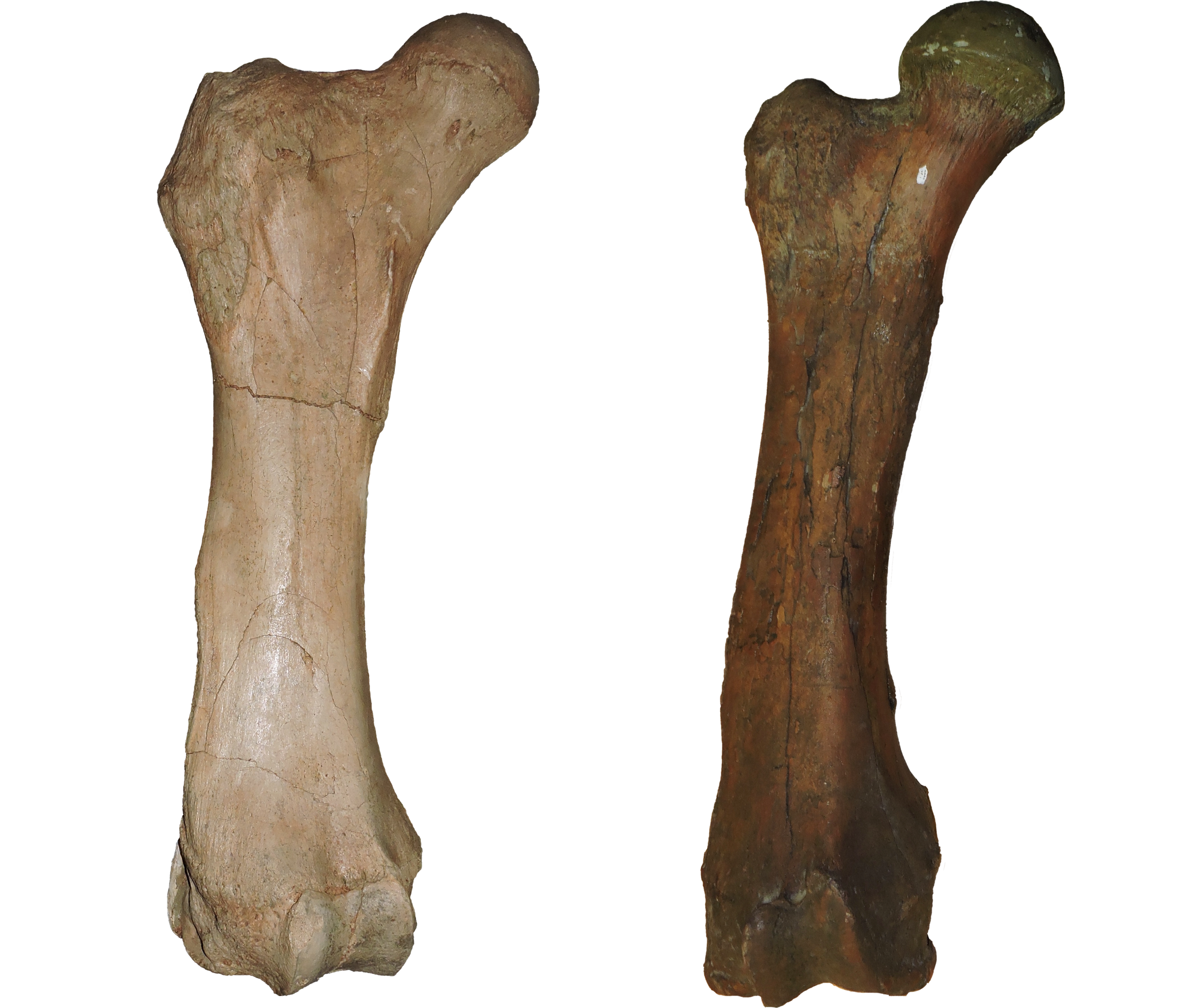 -- Mammut pacificus has no mandibular tusks, while they still occurred in about 25% of the M. americanum population. This is a tricky character, because both taxa seem to have been losing their chin tusks (the presence of chin tusks is the primitive condition for mastodons). But it seems that Pacific mastodons got there first. Below, at the top is Max's lower jaw, and below is a lower jaw from Colorado (from the Denver Museum of Nature and Science).Below is a map from our paper showing all the known Mammut pacificus localities, as well as the Mammut americanum localities we used in this study (there are many, many additional American mastodon sites we didn't examine):
-- Mammut pacificus has no mandibular tusks, while they still occurred in about 25% of the M. americanum population. This is a tricky character, because both taxa seem to have been losing their chin tusks (the presence of chin tusks is the primitive condition for mastodons). But it seems that Pacific mastodons got there first. Below, at the top is Max's lower jaw, and below is a lower jaw from Colorado (from the Denver Museum of Nature and Science).Below is a map from our paper showing all the known Mammut pacificus localities, as well as the Mammut americanum localities we used in this study (there are many, many additional American mastodon sites we didn't examine):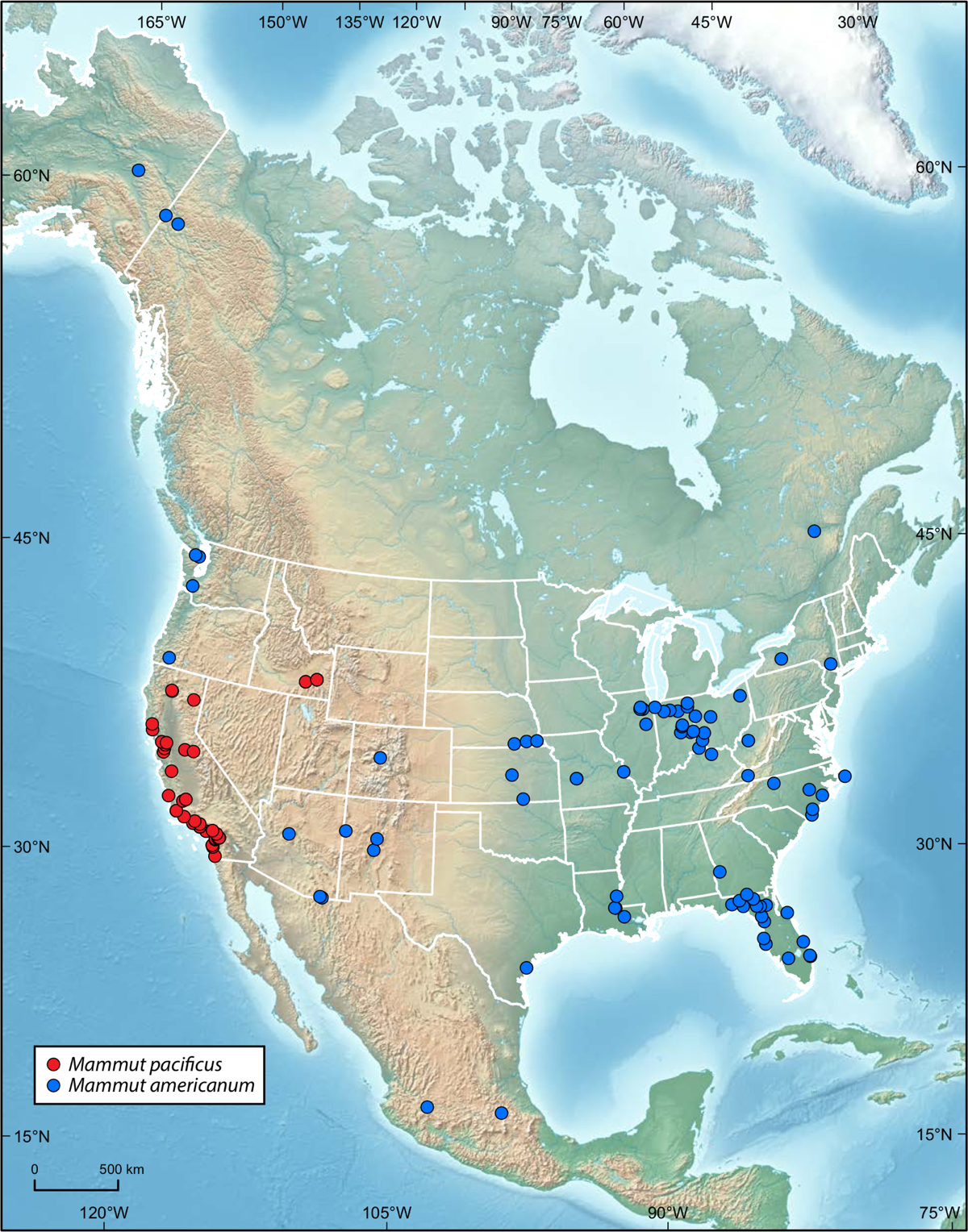 Note that, with the Oregon sample, we did not find any of the diagnostic bones (m3, femur, sacrum, lower jaw), so we conservatively coded the data as M. americanum, but it could actually be M. pacificus.We are committed to making our discovery as widely known as possible. To that end, we published our paper in the open access journal PeerJ, where it is available as a free download. We have also made 3D scans of 24 of the key DVL specimens available on MorphoSource and Sketchfab.I'll be writing more about the Pacific mastodon, but this is a quick summary of the highlights of the paper. If you really want to get into the details, our data is all available at the PeerJ link. Enjoy!
Note that, with the Oregon sample, we did not find any of the diagnostic bones (m3, femur, sacrum, lower jaw), so we conservatively coded the data as M. americanum, but it could actually be M. pacificus.We are committed to making our discovery as widely known as possible. To that end, we published our paper in the open access journal PeerJ, where it is available as a free download. We have also made 3D scans of 24 of the key DVL specimens available on MorphoSource and Sketchfab.I'll be writing more about the Pacific mastodon, but this is a quick summary of the highlights of the paper. If you really want to get into the details, our data is all available at the PeerJ link. Enjoy!
Fossil Friday - mammoth molar
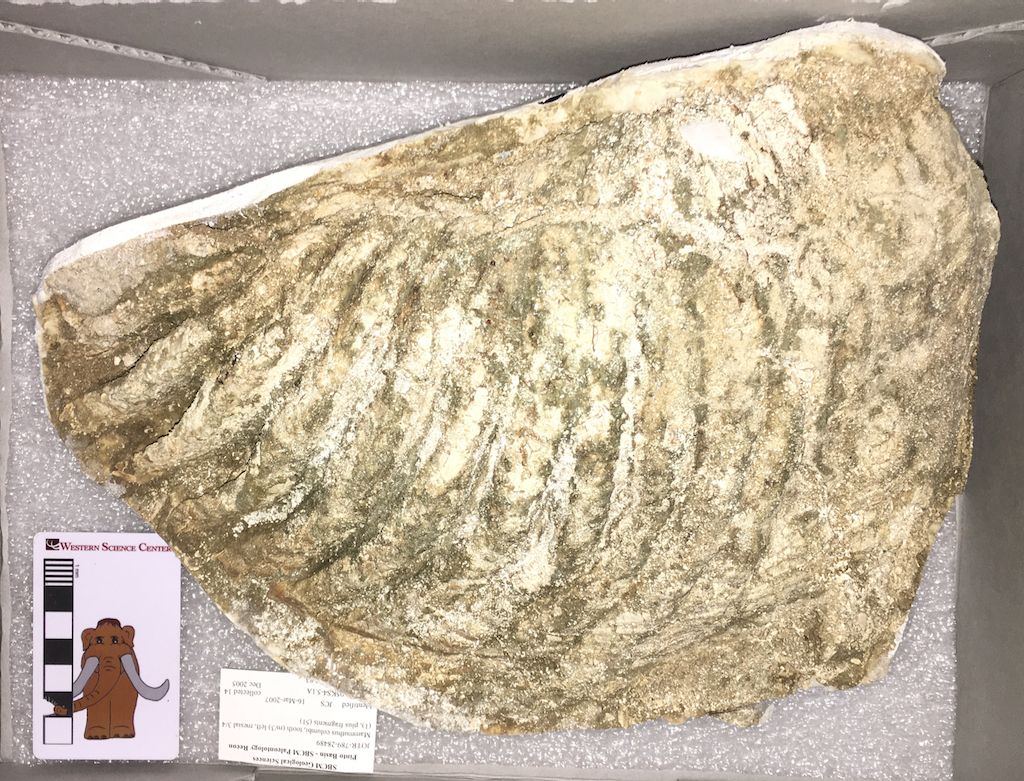 Today's Fossil Friday specimen comes from a location we've never before featured on this blog, Joshua Tree National Park.Joshua Tree is most famous for its eponymous trees and its spectacular granite formations, but there are also significant Pleistocene fossil deposits within the park. Over a period of several years Kathleen Springer and Eric Scott (then at the San Bernardino County Museum) collected some of these remains under a NPS permit. Earlier this week Joshua Tree designated Western Science Center as the repository for that collection and transferred the specimens here.The Joshua Tree fauna is an contrast with other Southern California sites such as Diamond Valley Lake in that, like today, during the Pleistocene it was more mountainous and more arid than the inland valleys. While the fossils from Joshua Tree are almost all fragmentary and poorly preserved, studying the fauna from this site will help give us a more complete understanding of how California ecosystems worked during the Pleistocene.The particular fossil shown here is a Columbian mammoth lower left third molar, one of several mammoth remains in the collection. Mammoths seem to be one taxon that had a great deal of ecological flexibility, as they are found in almost every imaginable Pleistocene deposit.Thanks to Melanie Spoo of Joshua Tree National Park and Vincent Santucci of the National Park Service for arranging the move of the Joshua Tree fossils to WSC.
Today's Fossil Friday specimen comes from a location we've never before featured on this blog, Joshua Tree National Park.Joshua Tree is most famous for its eponymous trees and its spectacular granite formations, but there are also significant Pleistocene fossil deposits within the park. Over a period of several years Kathleen Springer and Eric Scott (then at the San Bernardino County Museum) collected some of these remains under a NPS permit. Earlier this week Joshua Tree designated Western Science Center as the repository for that collection and transferred the specimens here.The Joshua Tree fauna is an contrast with other Southern California sites such as Diamond Valley Lake in that, like today, during the Pleistocene it was more mountainous and more arid than the inland valleys. While the fossils from Joshua Tree are almost all fragmentary and poorly preserved, studying the fauna from this site will help give us a more complete understanding of how California ecosystems worked during the Pleistocene.The particular fossil shown here is a Columbian mammoth lower left third molar, one of several mammoth remains in the collection. Mammoths seem to be one taxon that had a great deal of ecological flexibility, as they are found in almost every imaginable Pleistocene deposit.Thanks to Melanie Spoo of Joshua Tree National Park and Vincent Santucci of the National Park Service for arranging the move of the Joshua Tree fossils to WSC.
Fossil Friday - dinosaur tibia
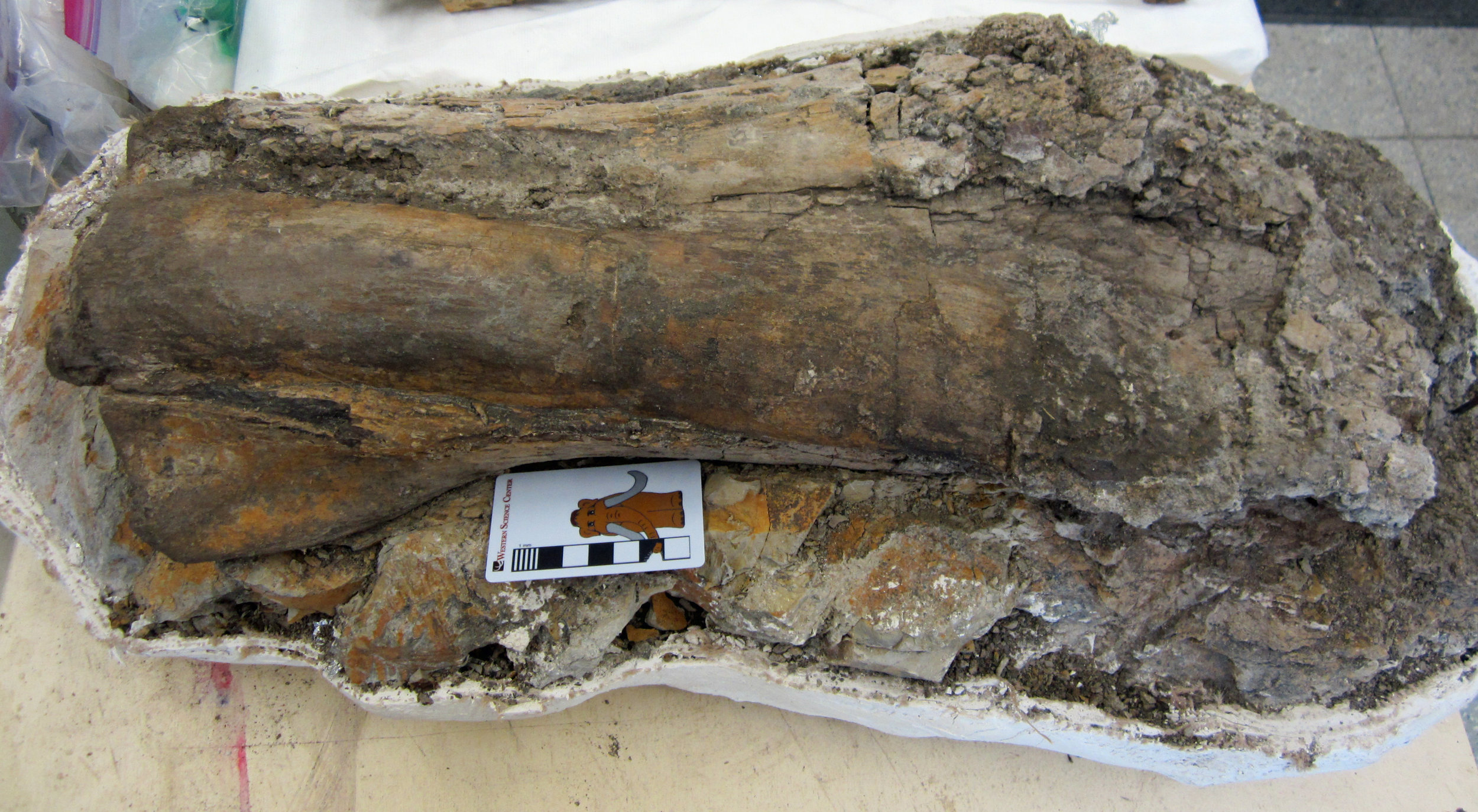 We have discovered many isolated dinosaur limb bones in the Upper Cretaceous Menefee Formation of New Mexico. Although it's difficult to infer the full appearance of a dinosaur from a single bone, even isolated bones can tell us a great deal about what kinds of dinosaurs were roaming around 80 million years ago, and can be very surprising!This bone was collected by my colleagues at the Zuni Dinosaur Institute for Geosciences and volunteers with the Southwest Paleontological Society in 2015. We have been thinking that it was possibly two dinosaur limb bones next to each other. However, Western Science Center volunteer Joe Reavis opened up the plaster jacket this week, and it turns out that it contains a single massive shin bone, a tibia. The bone is still partially encased in mudstone, but we'll keep working on it to determine what sort of dinosaur walked around on this immensely thick bone.Post by Curator Dr. Andrew McDonald.
We have discovered many isolated dinosaur limb bones in the Upper Cretaceous Menefee Formation of New Mexico. Although it's difficult to infer the full appearance of a dinosaur from a single bone, even isolated bones can tell us a great deal about what kinds of dinosaurs were roaming around 80 million years ago, and can be very surprising!This bone was collected by my colleagues at the Zuni Dinosaur Institute for Geosciences and volunteers with the Southwest Paleontological Society in 2015. We have been thinking that it was possibly two dinosaur limb bones next to each other. However, Western Science Center volunteer Joe Reavis opened up the plaster jacket this week, and it turns out that it contains a single massive shin bone, a tibia. The bone is still partially encased in mudstone, but we'll keep working on it to determine what sort of dinosaur walked around on this immensely thick bone.Post by Curator Dr. Andrew McDonald.
Fossil Friday - dinosaur limb bone
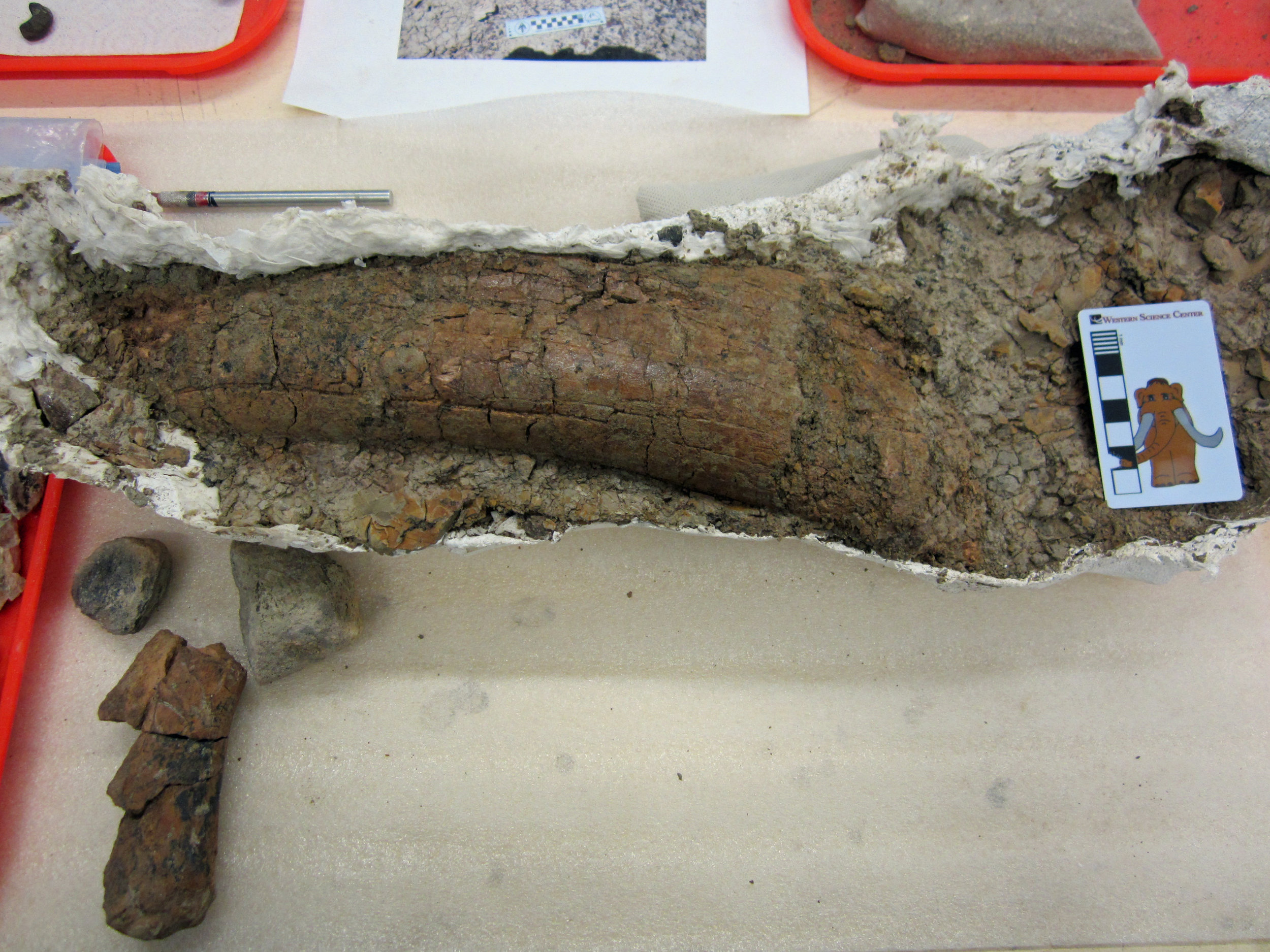 In the Western Science Center lab, we're making steady progress through several field seasons' worth of fossils from the Menefee Formation in New Mexico. We're working on fossils of dinosaurs, crocodiles, turtles, and plants, all dating to around 80 million years ago.This week, WSC volunteer Joe Reavis began prepping a fairly hefty dinosaur limb bone that was collected in 2016 by me and colleagues from the Zuni Dinosaur Institute for Geosciences and Southwest Paleontological Society. We're not yet certain what type of dinosaur this is from, or even which bone in the skeleton this is. One of the ends of the bone had eroded out onto the hillside prior to discovery, so we need to see if we can piece it back together and reattach it to the rest of the bone. There's always more to learn!Post by Curator Dr. Andrew McDonald.
In the Western Science Center lab, we're making steady progress through several field seasons' worth of fossils from the Menefee Formation in New Mexico. We're working on fossils of dinosaurs, crocodiles, turtles, and plants, all dating to around 80 million years ago.This week, WSC volunteer Joe Reavis began prepping a fairly hefty dinosaur limb bone that was collected in 2016 by me and colleagues from the Zuni Dinosaur Institute for Geosciences and Southwest Paleontological Society. We're not yet certain what type of dinosaur this is from, or even which bone in the skeleton this is. One of the ends of the bone had eroded out onto the hillside prior to discovery, so we need to see if we can piece it back together and reattach it to the rest of the bone. There's always more to learn!Post by Curator Dr. Andrew McDonald.
Fossil Friday - ceratopsian vertebra
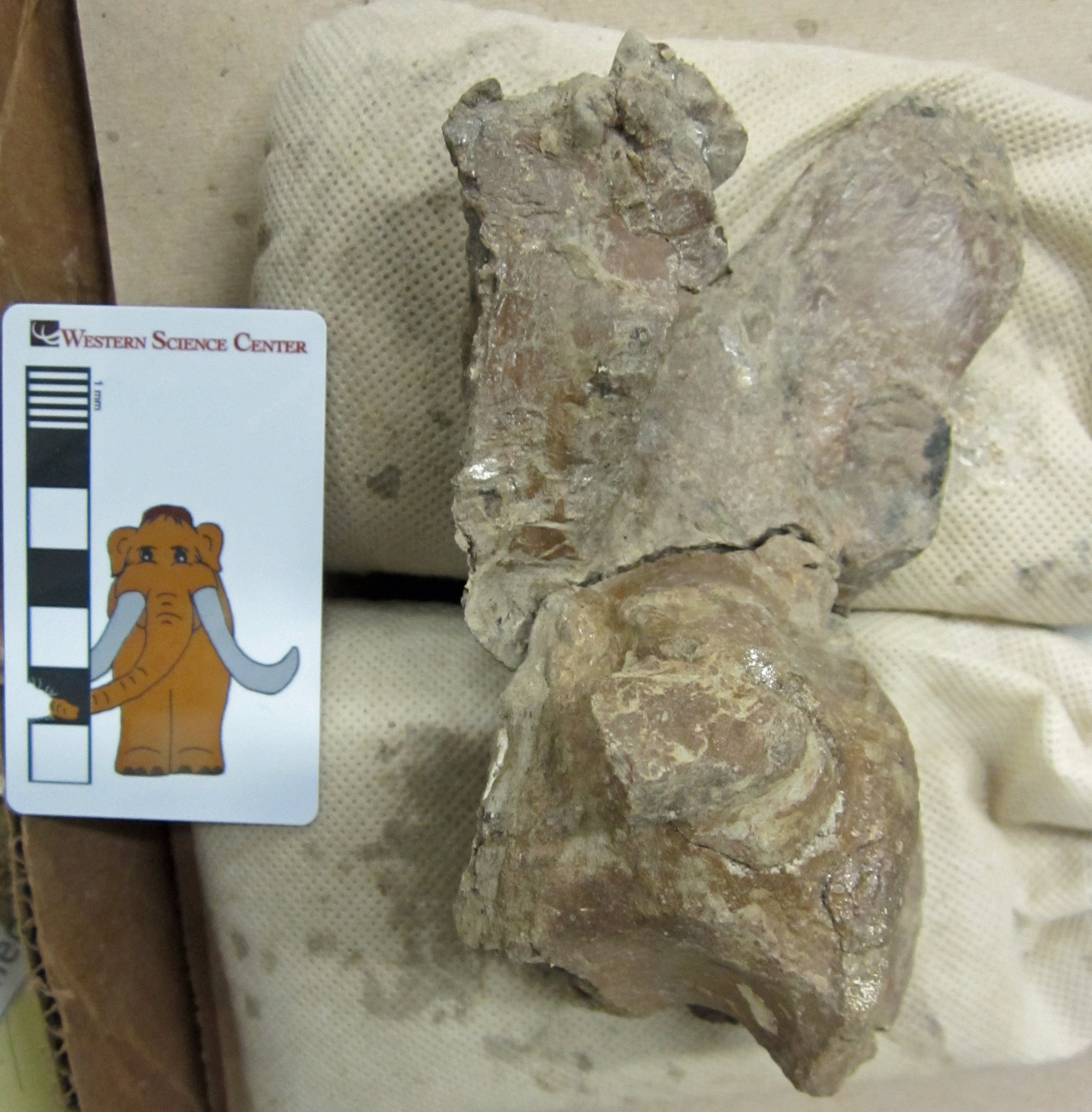 On January 25, I showed you a horned dinosaur vertebra that was still partially encased in its plaster field jacket. Western Science Center volunteer John Deleon has been working hard on this vertebra for the last several weeks and has made great progress. The vertebra is now completely freed from its jacket, and is awaiting a bit more matrix removal and gluing before it is finished.This vertebra is part of a partial ceratopsian skeleton excavated in New Mexico in 2018 by the Western Science Center, Zuni Dinosaur Institute for Geosciences, and Southwest Paleontological Society. At between 80 and 79 million years old, this skeleton is among the oldest specimens of large horned dinosaurs from North America. We are not yet certain what kind of horned dinosaur this is, but there are numerous more bones from the same animal waiting to be prepared in the WSC lab.Post by Curator Dr. Andrew McDonald.
On January 25, I showed you a horned dinosaur vertebra that was still partially encased in its plaster field jacket. Western Science Center volunteer John Deleon has been working hard on this vertebra for the last several weeks and has made great progress. The vertebra is now completely freed from its jacket, and is awaiting a bit more matrix removal and gluing before it is finished.This vertebra is part of a partial ceratopsian skeleton excavated in New Mexico in 2018 by the Western Science Center, Zuni Dinosaur Institute for Geosciences, and Southwest Paleontological Society. At between 80 and 79 million years old, this skeleton is among the oldest specimens of large horned dinosaurs from North America. We are not yet certain what kind of horned dinosaur this is, but there are numerous more bones from the same animal waiting to be prepared in the WSC lab.Post by Curator Dr. Andrew McDonald.
Fossil Friday -crocodile skull
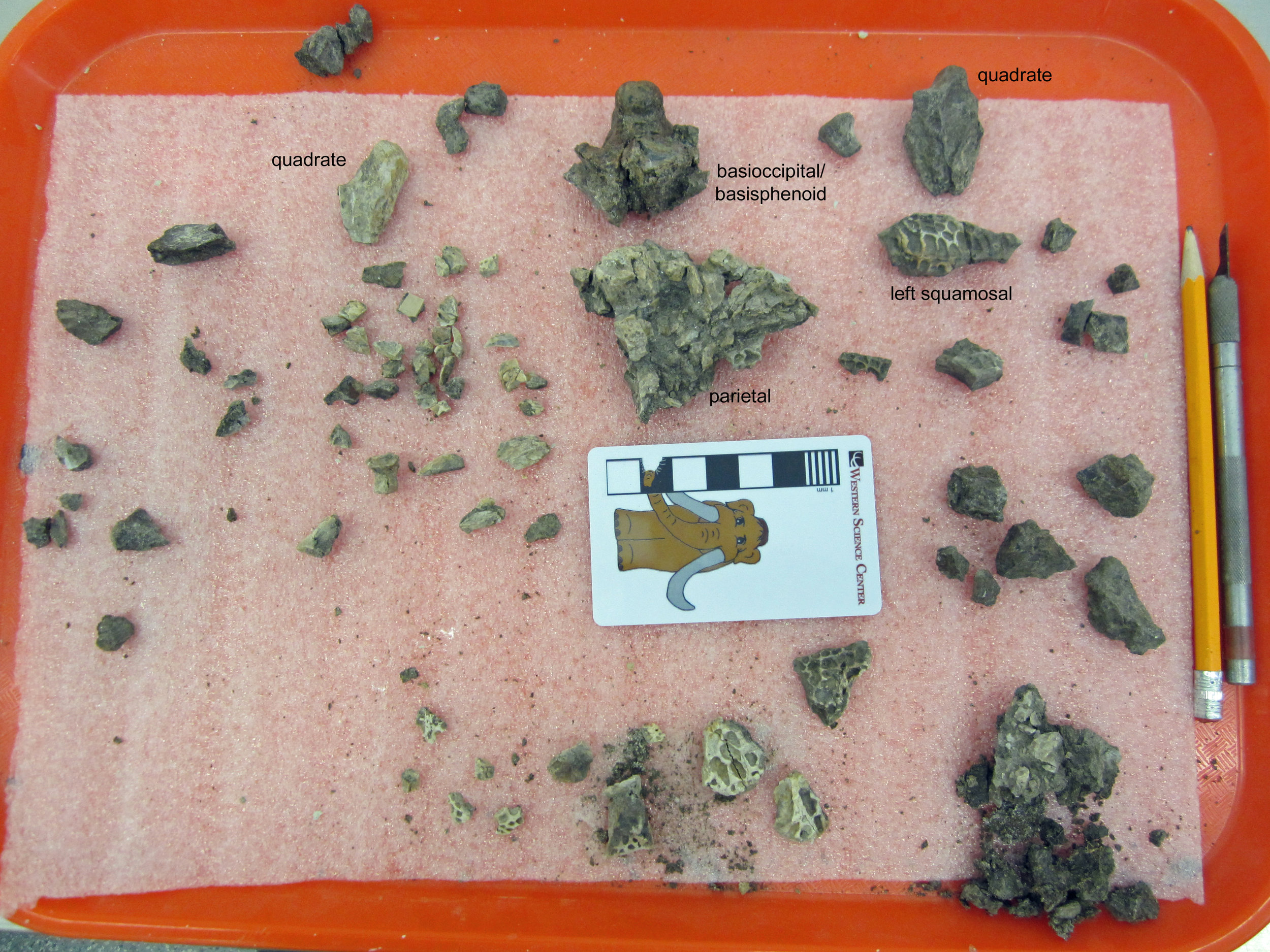 For Fossil Friday today, I want to give you an update on one of the fossils we collected in New Mexico last year. On December 14, 2018, I posted the smashed up skull of a small crocodile from the Menefee Formation, around 79 million years old.At the time, we had just removed this little skull from its plaster jacket. Although broken apart by erosion, from the deeply pitted texture of the bones and presence of the occipital condyle (the ball at the back of the skull that articulates with the first neck vertebra), it was clear that this is indeed a small crocodile skull. In order to piece it back together, the bone fragments would need to be removed from the surrounding rock. However, it appeared that none of the fragments had moved too far from their original positions. Therefore, it was important to have a record of the condition of the fossil before preparation began.To that end, WSC Educator Brett Dooley scanned the fossil with our NextEngine laser scanner, and Director Alton Dooley created a digital 3D model. We then printed it on one of the museum's 3D printers. We also took photographs of the fossil. Using the printed replica and photos as a guide, WSC lab volunteer Joe Reavis has been teasing the bone fragments from the rock in order to clean them and fit them together. As of now, the mass of bone fragments has been disassembled, and Joe and I have been able to start fitting pieces together and identifying the bones.The bones represent much of the back end of the skull, including bones that surrounded the brain (parietal, basisphenoid, and basioccipital with the occipital condyle), bones from the adjacent skull roof (left squamosal), and the bones with which the lower jaw would have articulated (the left and right quadrates). There is much work still to do, but once finished, this little skull will be a nice addition to our knowledge of the Menefee Formation's crocodiles. We hope to be able to reconstruct this region of the skull and determine to which species this specimen belongs.Post by Curator Dr. Andrew McDonald
For Fossil Friday today, I want to give you an update on one of the fossils we collected in New Mexico last year. On December 14, 2018, I posted the smashed up skull of a small crocodile from the Menefee Formation, around 79 million years old.At the time, we had just removed this little skull from its plaster jacket. Although broken apart by erosion, from the deeply pitted texture of the bones and presence of the occipital condyle (the ball at the back of the skull that articulates with the first neck vertebra), it was clear that this is indeed a small crocodile skull. In order to piece it back together, the bone fragments would need to be removed from the surrounding rock. However, it appeared that none of the fragments had moved too far from their original positions. Therefore, it was important to have a record of the condition of the fossil before preparation began.To that end, WSC Educator Brett Dooley scanned the fossil with our NextEngine laser scanner, and Director Alton Dooley created a digital 3D model. We then printed it on one of the museum's 3D printers. We also took photographs of the fossil. Using the printed replica and photos as a guide, WSC lab volunteer Joe Reavis has been teasing the bone fragments from the rock in order to clean them and fit them together. As of now, the mass of bone fragments has been disassembled, and Joe and I have been able to start fitting pieces together and identifying the bones.The bones represent much of the back end of the skull, including bones that surrounded the brain (parietal, basisphenoid, and basioccipital with the occipital condyle), bones from the adjacent skull roof (left squamosal), and the bones with which the lower jaw would have articulated (the left and right quadrates). There is much work still to do, but once finished, this little skull will be a nice addition to our knowledge of the Menefee Formation's crocodiles. We hope to be able to reconstruct this region of the skull and determine to which species this specimen belongs.Post by Curator Dr. Andrew McDonald
Fossil Friday - more on Mystic the whale
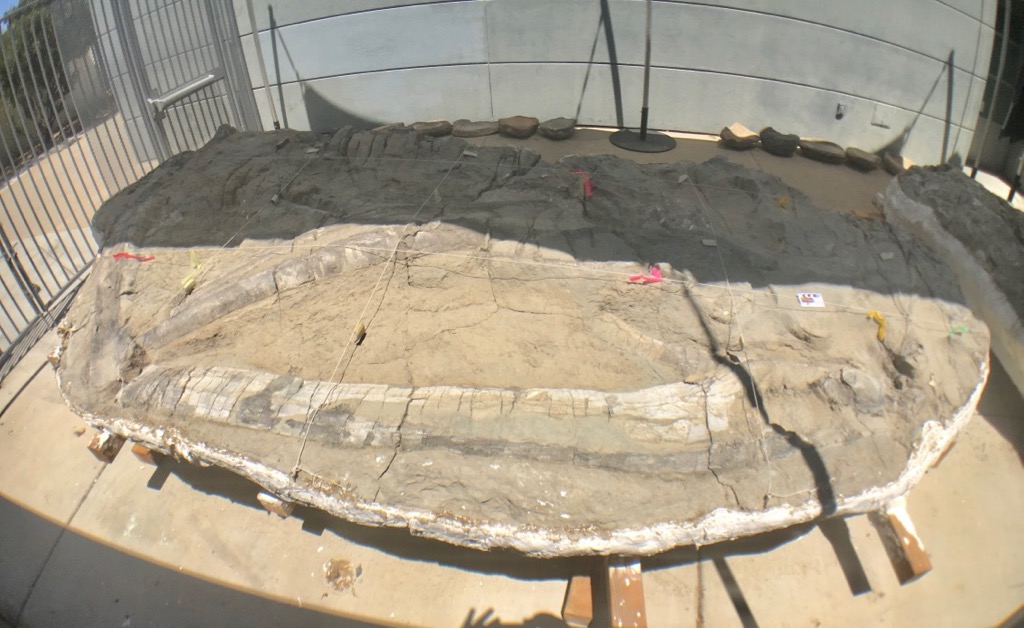 Last summer we took delivery of Mystic, a Pliocene baleen whale from Santa Cruz County. It will take us years to fully prepare Mystic, but we have started working on it, and we've made some interesting progress.Back in July, I tentatively identified Mystic as a possible member of the right whale family (the Balaenidae), based on its large size, the arched rostrum (upper jaw), and the lack of a coronoid process on the mandible. Below is a skeleton of the modern bowhead whale, Balaena mysticetus, showing those features (photo from the Royal Belgian Institute of Natural Sciences, taken by Nick Fraser):
Last summer we took delivery of Mystic, a Pliocene baleen whale from Santa Cruz County. It will take us years to fully prepare Mystic, but we have started working on it, and we've made some interesting progress.Back in July, I tentatively identified Mystic as a possible member of the right whale family (the Balaenidae), based on its large size, the arched rostrum (upper jaw), and the lack of a coronoid process on the mandible. Below is a skeleton of the modern bowhead whale, Balaena mysticetus, showing those features (photo from the Royal Belgian Institute of Natural Sciences, taken by Nick Fraser):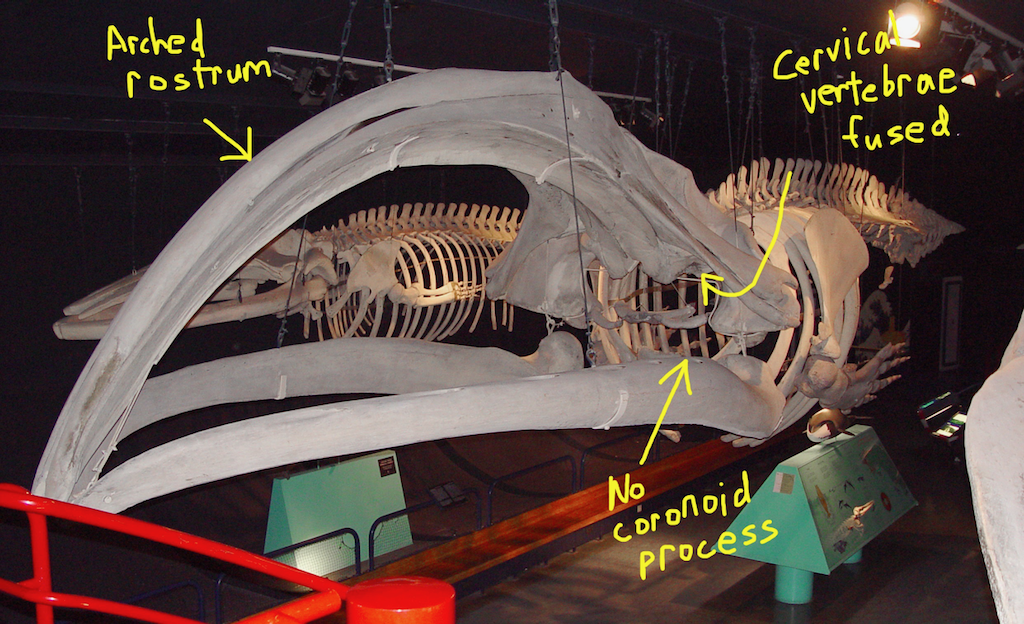 The fused cervical vertebrae are not visible in the photo above, but an interesting feature of balaenids is that all seven neck vertebrae are fused in both modern genera at a very young age, and the first six are fused in the only fossil genus with a known vertebral column, Balaenula (example below from the Pliocene of Virginia, at the North Carolina Museum of Natural Sciences):
The fused cervical vertebrae are not visible in the photo above, but an interesting feature of balaenids is that all seven neck vertebrae are fused in both modern genera at a very young age, and the first six are fused in the only fossil genus with a known vertebral column, Balaenula (example below from the Pliocene of Virginia, at the North Carolina Museum of Natural Sciences):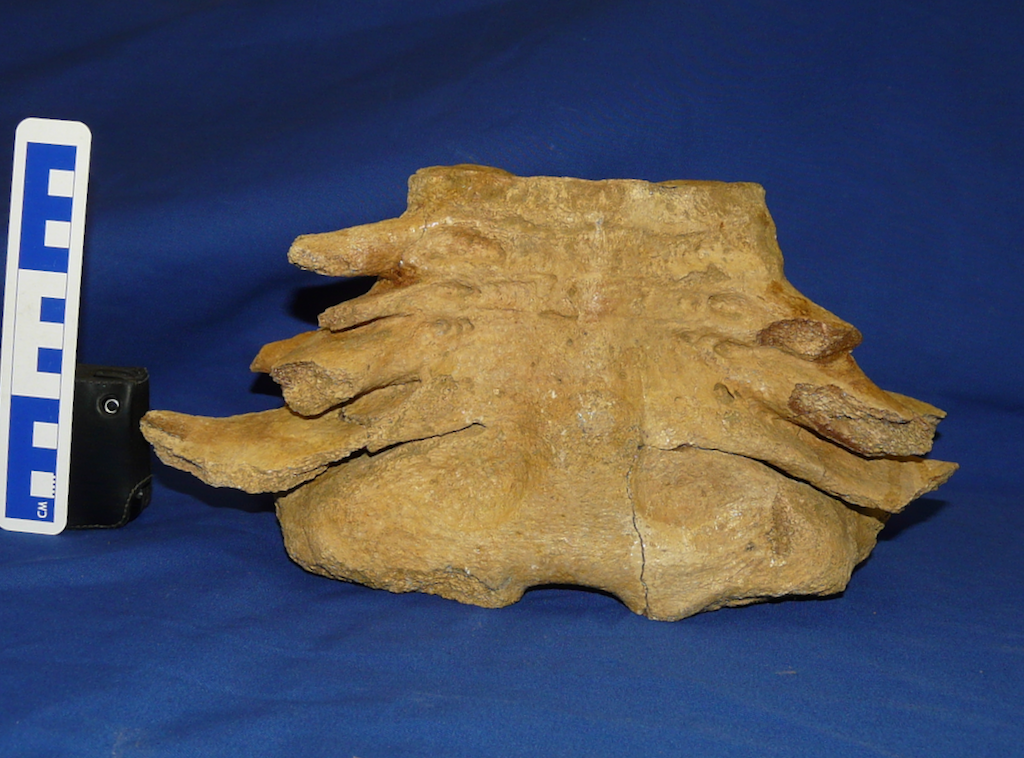 In recent weeks, we've been working around the back of Mystic's head, and noticed a series of vertebrae (after the photo is a version with the vertebrae circled):
In recent weeks, we've been working around the back of Mystic's head, and noticed a series of vertebrae (after the photo is a version with the vertebrae circled):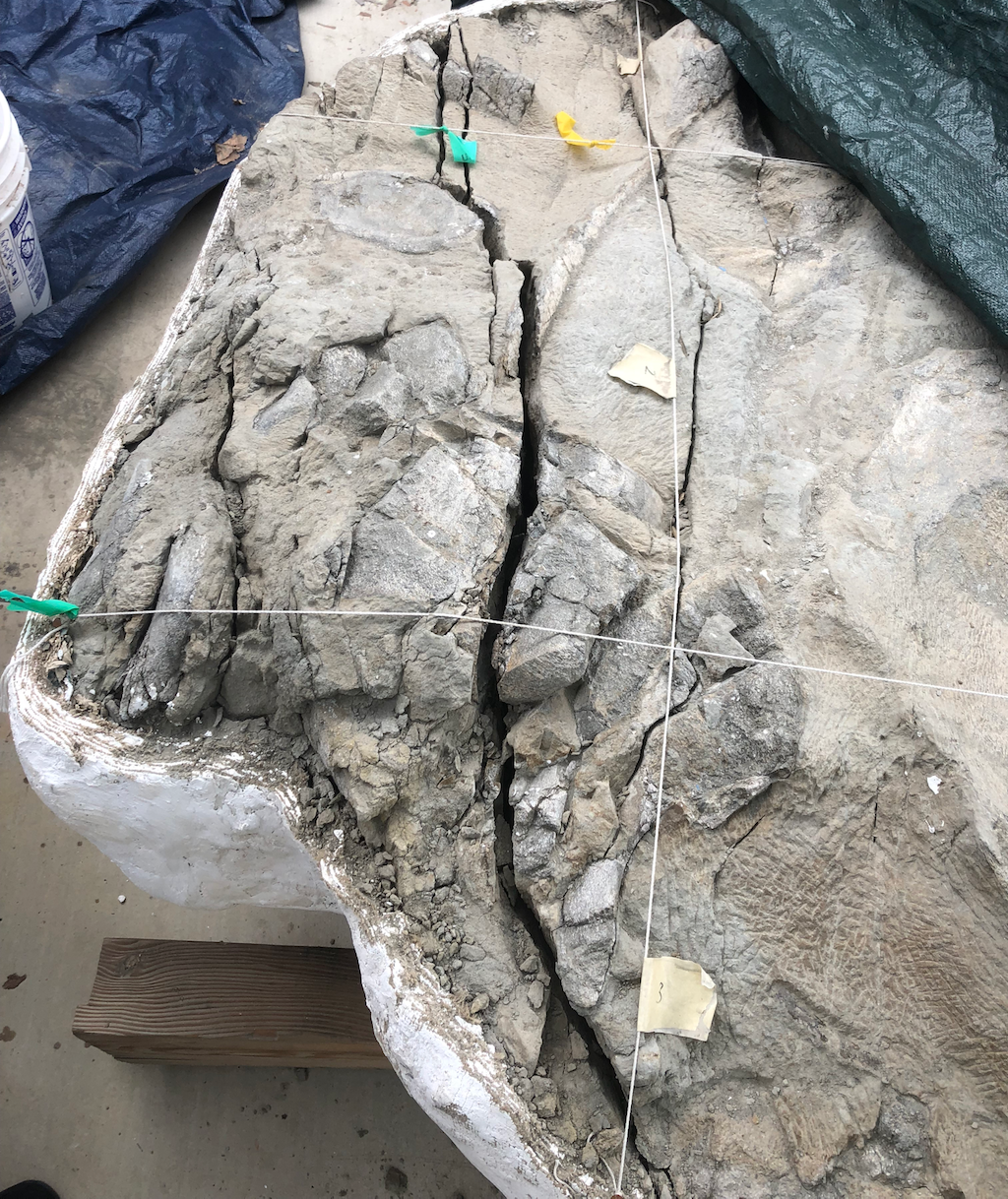
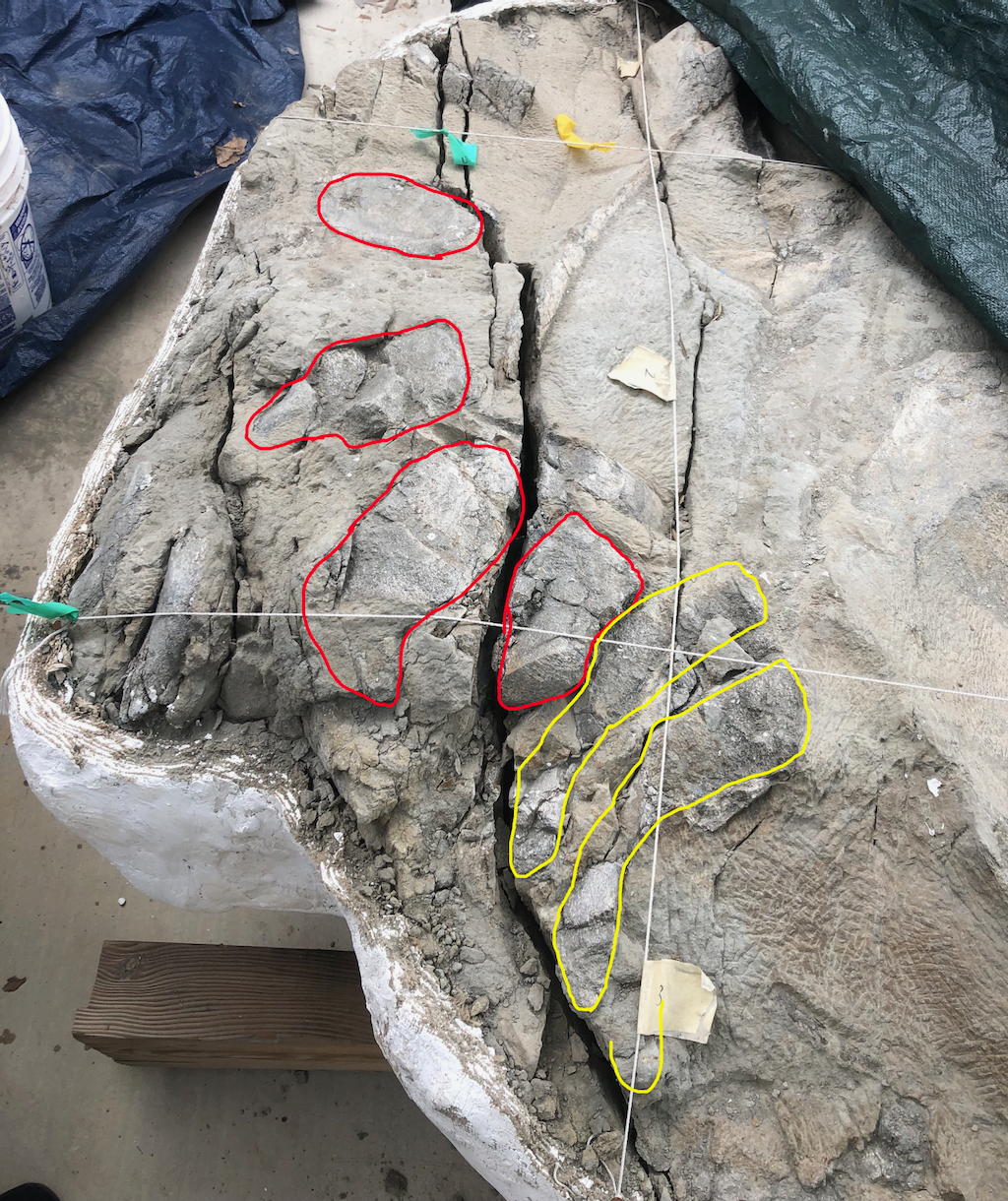 Most of these vertebrae are articulated, or nearly so. But the ones in yellow are of particular interest. They have transverse processes with no obvious rib articulations, and the vertebral centra are very short. That makes them look like cervical vertebrae, but they aren't fused. As mentioned above, all known members of the right whale family have fused cervicals. So, do we have other options?Balaenopterids (blue whales, humpback whales, and their relatives) have unfused cervical vertebrae, but their rostra are only slightly arched, and, more significantly, they all have very large, prominent coronoid processes (fin whale Balaenoptera physalis below from the Los Angeles County Museum):
Most of these vertebrae are articulated, or nearly so. But the ones in yellow are of particular interest. They have transverse processes with no obvious rib articulations, and the vertebral centra are very short. That makes them look like cervical vertebrae, but they aren't fused. As mentioned above, all known members of the right whale family have fused cervicals. So, do we have other options?Balaenopterids (blue whales, humpback whales, and their relatives) have unfused cervical vertebrae, but their rostra are only slightly arched, and, more significantly, they all have very large, prominent coronoid processes (fin whale Balaenoptera physalis below from the Los Angeles County Museum):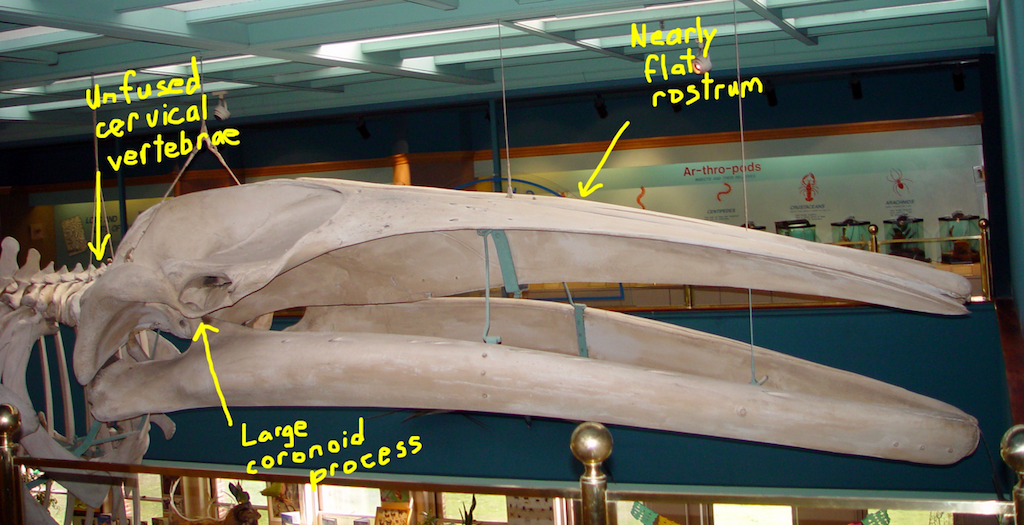 However, there are also gray whales (example below from the Monterey Bay Aquarium):
However, there are also gray whales (example below from the Monterey Bay Aquarium):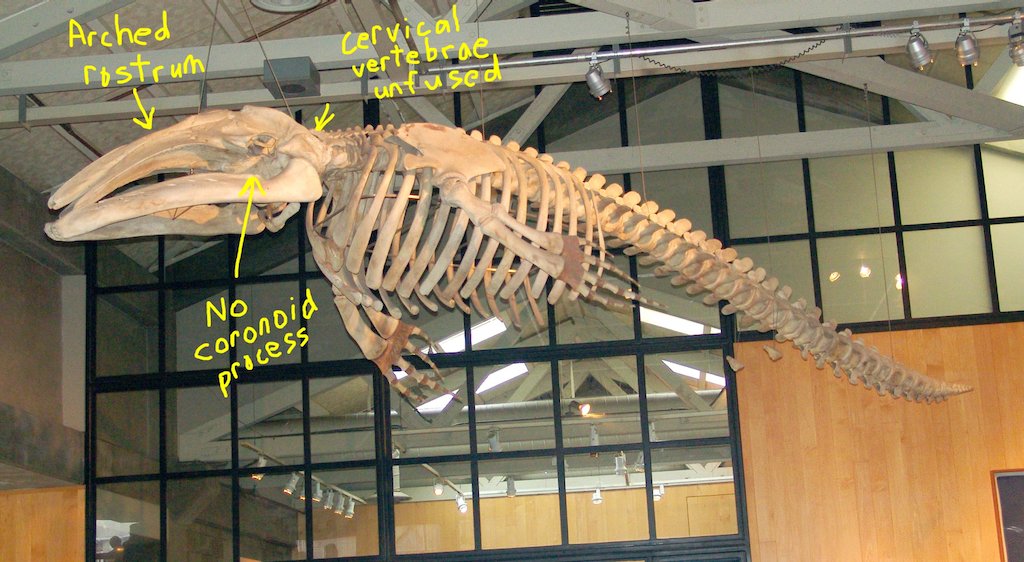 Like balaenopterids (and, in fact, all mysticetes except the right whales), gray whales have unfused cervical vertebrae. But, like right whales, they have an arched rostrum (although not as arched as in the right whales) and lack a coronoid process.If we're interpreting Mystic's features correctly, I now think there's a good chance it could be a gray whale instead of a right whale. There have been other fossil gray whales found in Pliocene deposits from California, especially from the San Diego Formation, but they don't seem to be terribly common, so this would still be a great find.Stay tuned for more over the next five years or so!
Like balaenopterids (and, in fact, all mysticetes except the right whales), gray whales have unfused cervical vertebrae. But, like right whales, they have an arched rostrum (although not as arched as in the right whales) and lack a coronoid process.If we're interpreting Mystic's features correctly, I now think there's a good chance it could be a gray whale instead of a right whale. There have been other fossil gray whales found in Pliocene deposits from California, especially from the San Diego Formation, but they don't seem to be terribly common, so this would still be a great find.Stay tuned for more over the next five years or so!
Fossil Friday - ceratopsian vertebra
 Identifying fossil bones can be quite the challenge. Fossils might be broken, scattered, or distorted from the weight of the rock encasing them. This dinosaur bone was collected in June 2018 by the Western Science Center, Zuni Dinosaur Institute for Geosciences, and Southwest Paleontological Society in the Menefee Formation of New Mexico. We know from other bones collected in the same spot that we are dealing with the 79-million-year-old partial skeleton of a ceratopsid, one of the large horned dinosaurs related to Triceratops.In the field, all we could see was a flat but somewhat intricate surface that we thought might be a skull bone. WSC volunteer John Deleon recently started prepping this fossil out of its small plaster jacket, so we can see more of its shape and features for the first time. Turns out this bone is actually a highly distorted vertebra that has been flattened side to side. Right now it is visible only from the left side. Many characteristics of a typical vertebra are observable, including the centrum (the main body of the vertebra), the neural spine, and the left prezygapophysis and postzygapophysis (along with the centrum, these structures are where the vertebra would articulate with the vertebra in front of it and the one behind it).We have many more vertebrae, ribs, and a large hip bone to prepare from this ceratopsid, so we will have much more to say about this dinosaur in the near future.
Identifying fossil bones can be quite the challenge. Fossils might be broken, scattered, or distorted from the weight of the rock encasing them. This dinosaur bone was collected in June 2018 by the Western Science Center, Zuni Dinosaur Institute for Geosciences, and Southwest Paleontological Society in the Menefee Formation of New Mexico. We know from other bones collected in the same spot that we are dealing with the 79-million-year-old partial skeleton of a ceratopsid, one of the large horned dinosaurs related to Triceratops.In the field, all we could see was a flat but somewhat intricate surface that we thought might be a skull bone. WSC volunteer John Deleon recently started prepping this fossil out of its small plaster jacket, so we can see more of its shape and features for the first time. Turns out this bone is actually a highly distorted vertebra that has been flattened side to side. Right now it is visible only from the left side. Many characteristics of a typical vertebra are observable, including the centrum (the main body of the vertebra), the neural spine, and the left prezygapophysis and postzygapophysis (along with the centrum, these structures are where the vertebra would articulate with the vertebra in front of it and the one behind it).We have many more vertebrae, ribs, and a large hip bone to prepare from this ceratopsid, so we will have much more to say about this dinosaur in the near future.
Fossil Friday - fox squirrels and vampire's disease
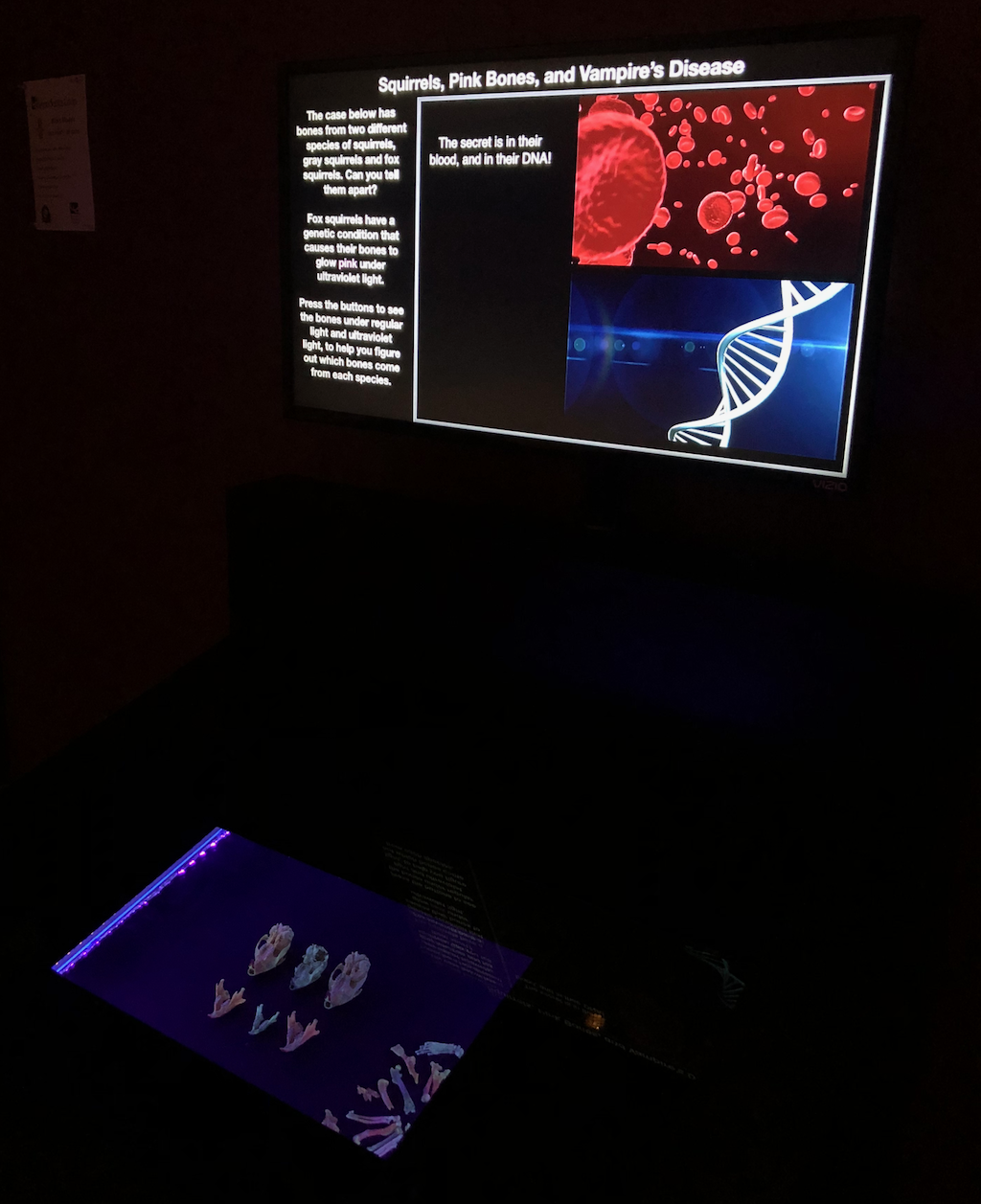 This week we opened a new permanent exhibit at Western Science Center on eastern fox squirrels. This is based on research that I did in 2011-2013 in collaboration with Dr. Nancy Moncrief, Curator of Mammalogy at the Virginia Museum of Natural History (at that time I was Curator of Paleontology at VMNH). Much of the following is taken from a post I wrote for my old blog, Updates from the Paleontology Lab, on 29 February 2012.
This week we opened a new permanent exhibit at Western Science Center on eastern fox squirrels. This is based on research that I did in 2011-2013 in collaboration with Dr. Nancy Moncrief, Curator of Mammalogy at the Virginia Museum of Natural History (at that time I was Curator of Paleontology at VMNH). Much of the following is taken from a post I wrote for my old blog, Updates from the Paleontology Lab, on 29 February 2012.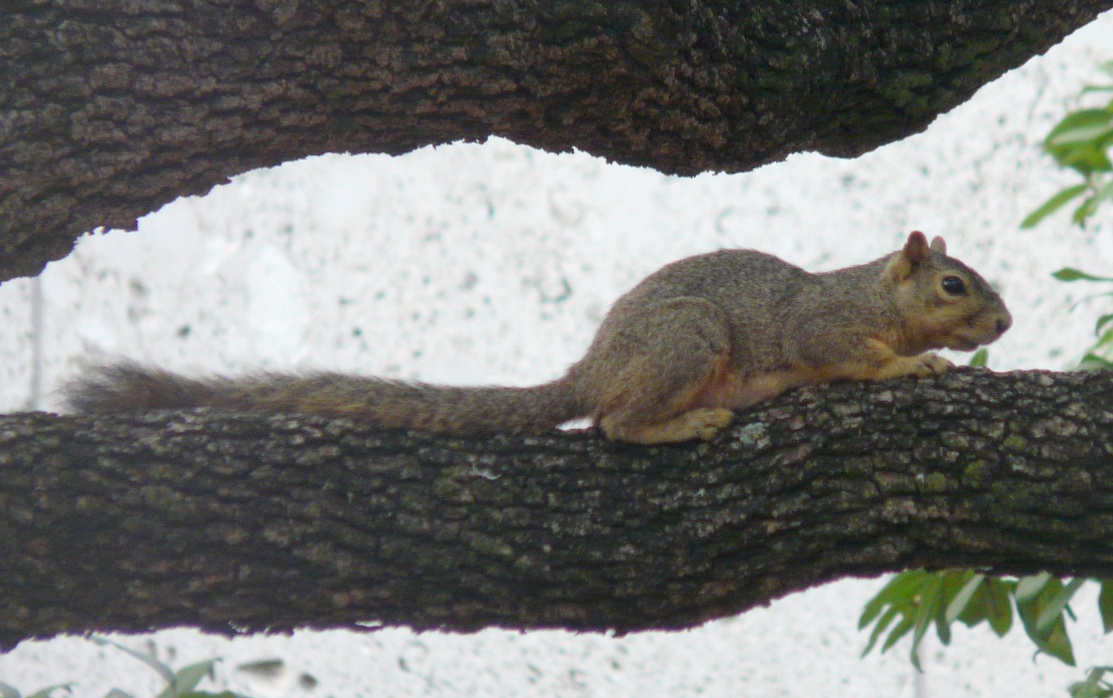 For many years, Nancy worked on the biogeographic patterns in the eastern fox squirrel, Sciurus niger (above), mostly by looking at marker genes. S. niger is an interesting species for this work because there are numerous subspecies that vary greatly in body size and coat color, as you can see in these specimens from the VMNH collections:
For many years, Nancy worked on the biogeographic patterns in the eastern fox squirrel, Sciurus niger (above), mostly by looking at marker genes. S. niger is an interesting species for this work because there are numerous subspecies that vary greatly in body size and coat color, as you can see in these specimens from the VMNH collections: That’s a lot of variation! What makes it really interesting is that S. niger is a temperate species that doesn’t tolerate cold weather very well (they don’t hibernate). That means that their range was probably very restricted in the Pleistocene during the last glacial maximum, suggesting that all that phenotypic diversity may have arisen in less than 10,000 years.I was not involved in Nancy’s research, but because I do some biogeographic work Nancy would occasionally ask me to read her manuscripts or listen to her lectures to provide feedback from a paleontologist’s perspective. As a result I was somewhat familiar with her work.Then, in 2009 I was asked to write a book chapter reviewing the published record of vertebrate fossils in Virginia (which was finally published in 2016). While tabulating these species I noticed that, while the genus Sciurus had been reported from the Virginia Pleistocene, there were no reports of S. niger. Almost all the records were listed as Sciurus sp.Realizing that being able to tell when fox squirrels show up in different places could be useful for Nancy’s work, I asked her about the lack of definitive species-level identifications. The problem, she explained, is that it’s really difficult to distinguish S. niger from the closely related, sympatric, eastern gray squirrel (Sciurus carolinensis, below) when only the skeleton is available.
That’s a lot of variation! What makes it really interesting is that S. niger is a temperate species that doesn’t tolerate cold weather very well (they don’t hibernate). That means that their range was probably very restricted in the Pleistocene during the last glacial maximum, suggesting that all that phenotypic diversity may have arisen in less than 10,000 years.I was not involved in Nancy’s research, but because I do some biogeographic work Nancy would occasionally ask me to read her manuscripts or listen to her lectures to provide feedback from a paleontologist’s perspective. As a result I was somewhat familiar with her work.Then, in 2009 I was asked to write a book chapter reviewing the published record of vertebrate fossils in Virginia (which was finally published in 2016). While tabulating these species I noticed that, while the genus Sciurus had been reported from the Virginia Pleistocene, there were no reports of S. niger. Almost all the records were listed as Sciurus sp.Realizing that being able to tell when fox squirrels show up in different places could be useful for Nancy’s work, I asked her about the lack of definitive species-level identifications. The problem, she explained, is that it’s really difficult to distinguish S. niger from the closely related, sympatric, eastern gray squirrel (Sciurus carolinensis, below) when only the skeleton is available.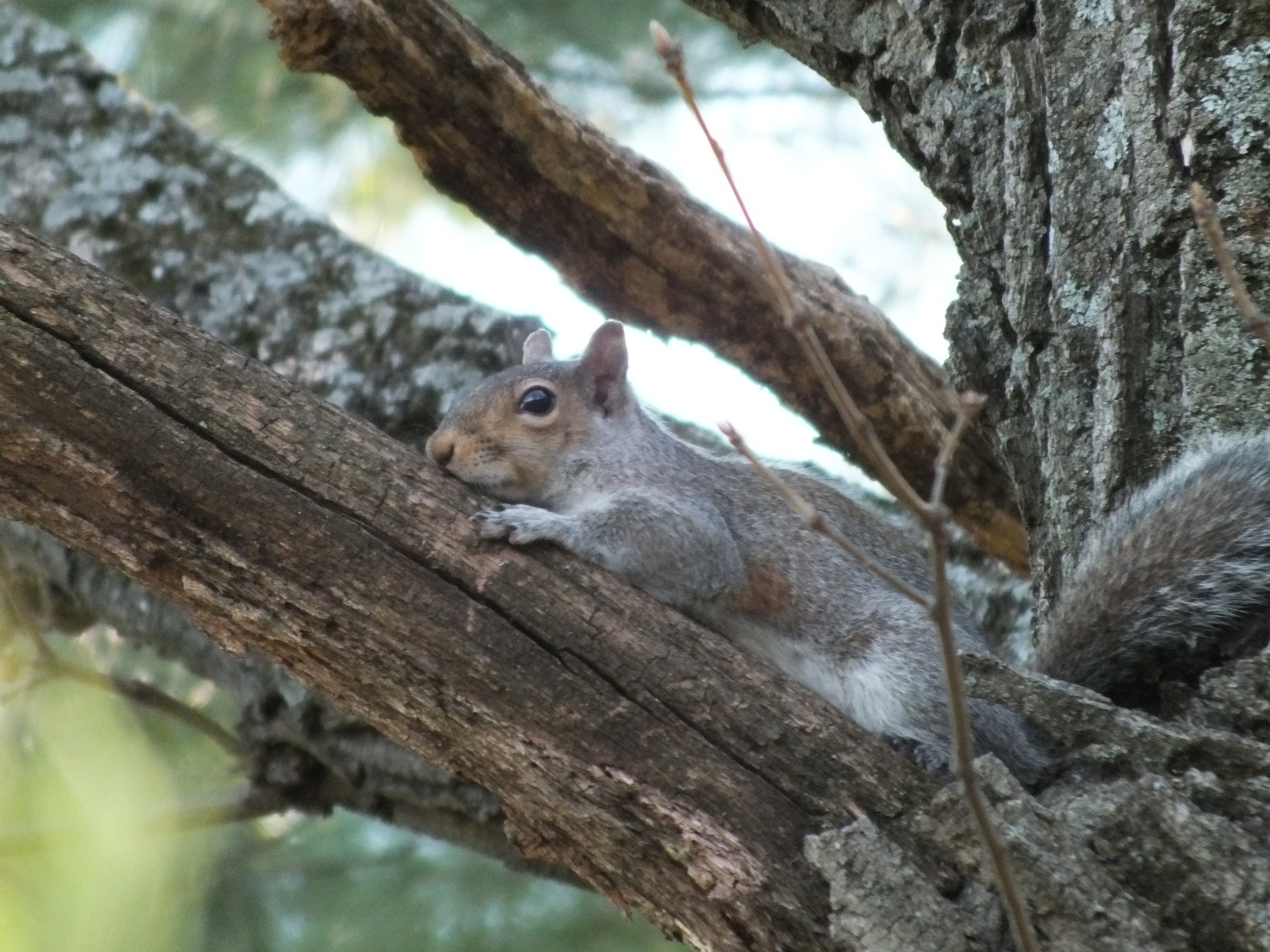 The problem is that tree squirrels are pretty conservative in their skeletal morphology, especially in the postcranial skeleton, with few changes since the Miocene at least. The average size and maximum size of fox squirrels are greater than in gray squirrels. However, there is considerable overlap; the largest gray squirrels are bigger than the smallest fox squirrels. So using body size for identification only works for really big specimens.There are also some detail differences in the skull and mandible, but they tend to be somewhat inconsistent. Easily the most reliable feature is the presence of a rudimentary upper 3rd premolar in S. carolinensis, which is absent in S. niger. Below is the upper right tooth row of S. carolinensis, top, and S. niger, bottom. In each specimen anterior is to the right. Note the tiny, peg-like premolar at the front of the tooth row in S. carolinensis only:
The problem is that tree squirrels are pretty conservative in their skeletal morphology, especially in the postcranial skeleton, with few changes since the Miocene at least. The average size and maximum size of fox squirrels are greater than in gray squirrels. However, there is considerable overlap; the largest gray squirrels are bigger than the smallest fox squirrels. So using body size for identification only works for really big specimens.There are also some detail differences in the skull and mandible, but they tend to be somewhat inconsistent. Easily the most reliable feature is the presence of a rudimentary upper 3rd premolar in S. carolinensis, which is absent in S. niger. Below is the upper right tooth row of S. carolinensis, top, and S. niger, bottom. In each specimen anterior is to the right. Note the tiny, peg-like premolar at the front of the tooth row in S. carolinensis only: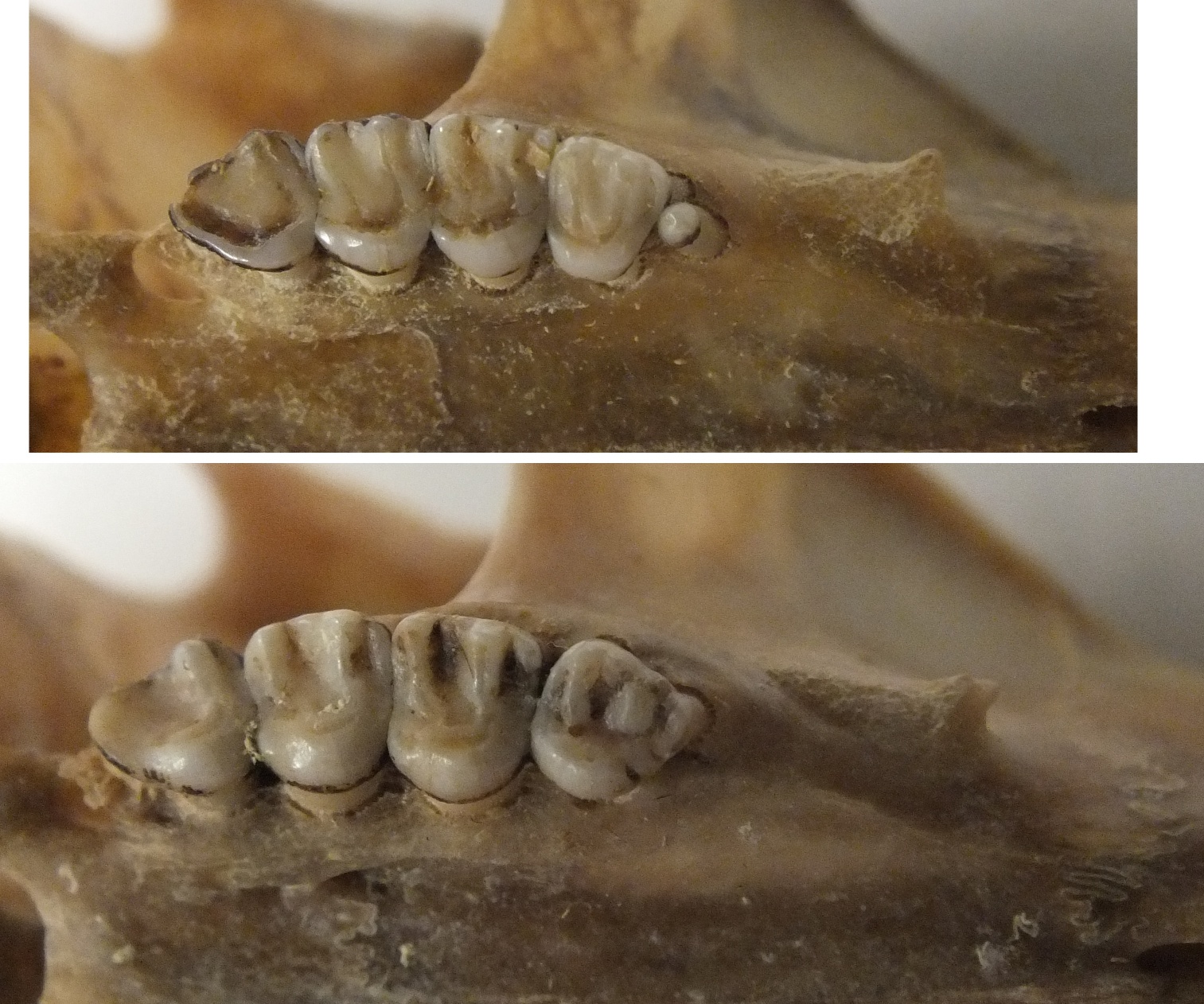 Unfortunately, it’s pretty rare to preserve that particular part of the maxilla, so the extra premolar is of limited use in identifying isolated bone fragments in Pleistocene deposits. In an irrational fit of optimism, I suggested to Nancy that I might be able to come up with features for distinguishing between the two species based on isolated material, especially since the VMNH collections include hundreds of modern squirrel skeletons to use as references.After several frustrating days looking at squirrel bones, I was ready to give up. There simply don’t seem to be any consistent features for distinguishing postcranial remains other than size, which is unreliable. Then, as Nancy and I sat together discussing squirrel trivia, she asked if I knew that fox squirrel bones glow pink under ultraviolet light. It hit us both at the same time; only fox squirrel bones fluoresce under UV light! Here’s an S. niger skull under visible light (left), and the same skull under UV light (right):
Unfortunately, it’s pretty rare to preserve that particular part of the maxilla, so the extra premolar is of limited use in identifying isolated bone fragments in Pleistocene deposits. In an irrational fit of optimism, I suggested to Nancy that I might be able to come up with features for distinguishing between the two species based on isolated material, especially since the VMNH collections include hundreds of modern squirrel skeletons to use as references.After several frustrating days looking at squirrel bones, I was ready to give up. There simply don’t seem to be any consistent features for distinguishing postcranial remains other than size, which is unreliable. Then, as Nancy and I sat together discussing squirrel trivia, she asked if I knew that fox squirrel bones glow pink under ultraviolet light. It hit us both at the same time; only fox squirrel bones fluoresce under UV light! Here’s an S. niger skull under visible light (left), and the same skull under UV light (right):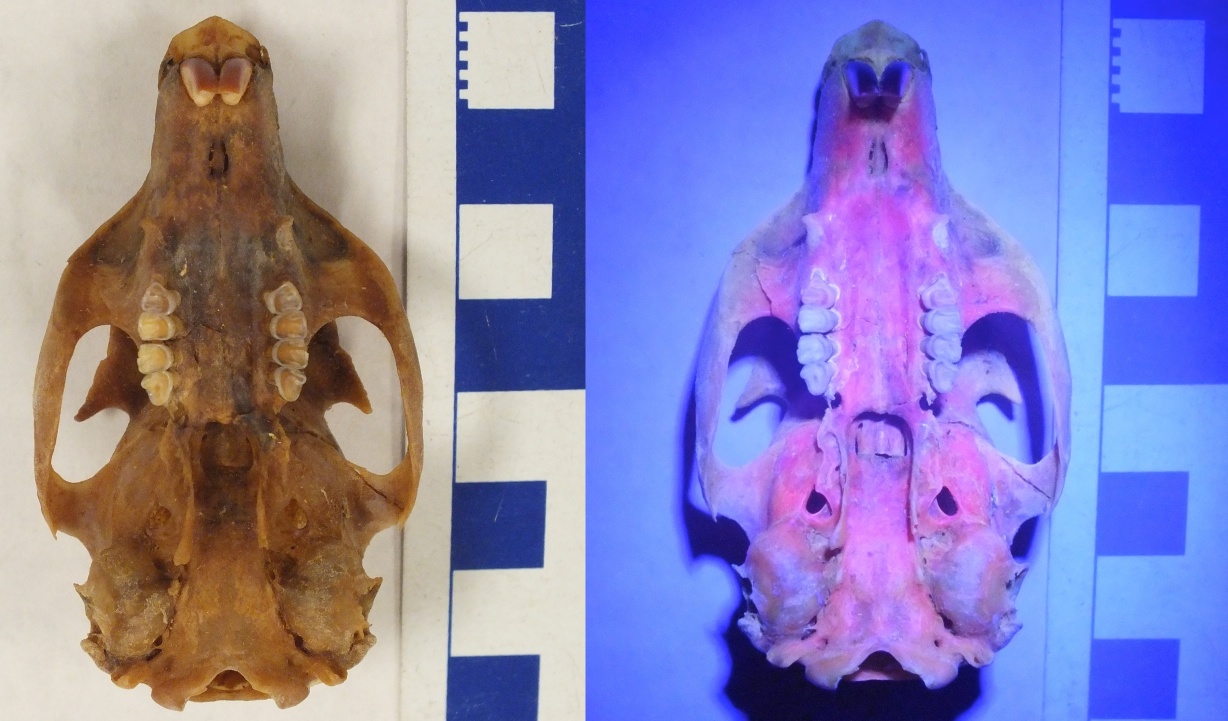 So here’s the deal: eastern fox squirrels almost universally have a genetic condition called congenital erythropoietic porphyria (CEP). This is caused by a mutation in one of the genes involved in the heme chain (heme is a key component of hemoglobin). Specifically, animals with CEP can’t properly metabolize the enzyme uroporphyrin, which as a result starts to build up in the urine, bones, and teeth. Uroporphyrin fluoresces pink when exposed to ultraviolet light.As I mentioned above, CEP is normally not present in gray squirrels, so we can potentially use the presence of fluorescence to distinguish between fox and gray squirrels, even when there’s a size overlap. For example, the skulls below are organized by increasing size from left to right. Which ones are S. niger, and which ones are S. carolinensis?
So here’s the deal: eastern fox squirrels almost universally have a genetic condition called congenital erythropoietic porphyria (CEP). This is caused by a mutation in one of the genes involved in the heme chain (heme is a key component of hemoglobin). Specifically, animals with CEP can’t properly metabolize the enzyme uroporphyrin, which as a result starts to build up in the urine, bones, and teeth. Uroporphyrin fluoresces pink when exposed to ultraviolet light.As I mentioned above, CEP is normally not present in gray squirrels, so we can potentially use the presence of fluorescence to distinguish between fox and gray squirrels, even when there’s a size overlap. For example, the skulls below are organized by increasing size from left to right. Which ones are S. niger, and which ones are S. carolinensis?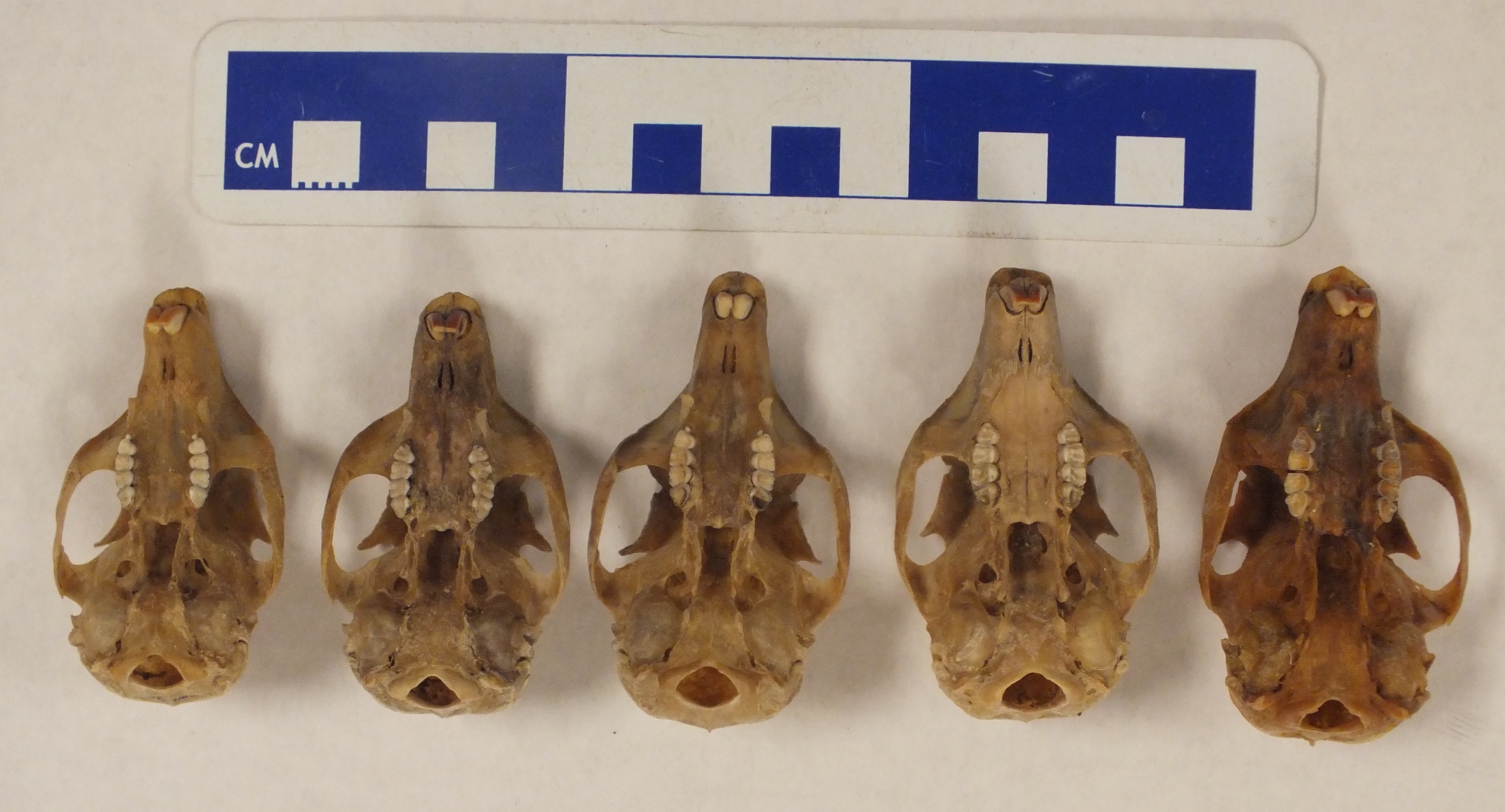 Here are the same skulls under UV light:
Here are the same skulls under UV light: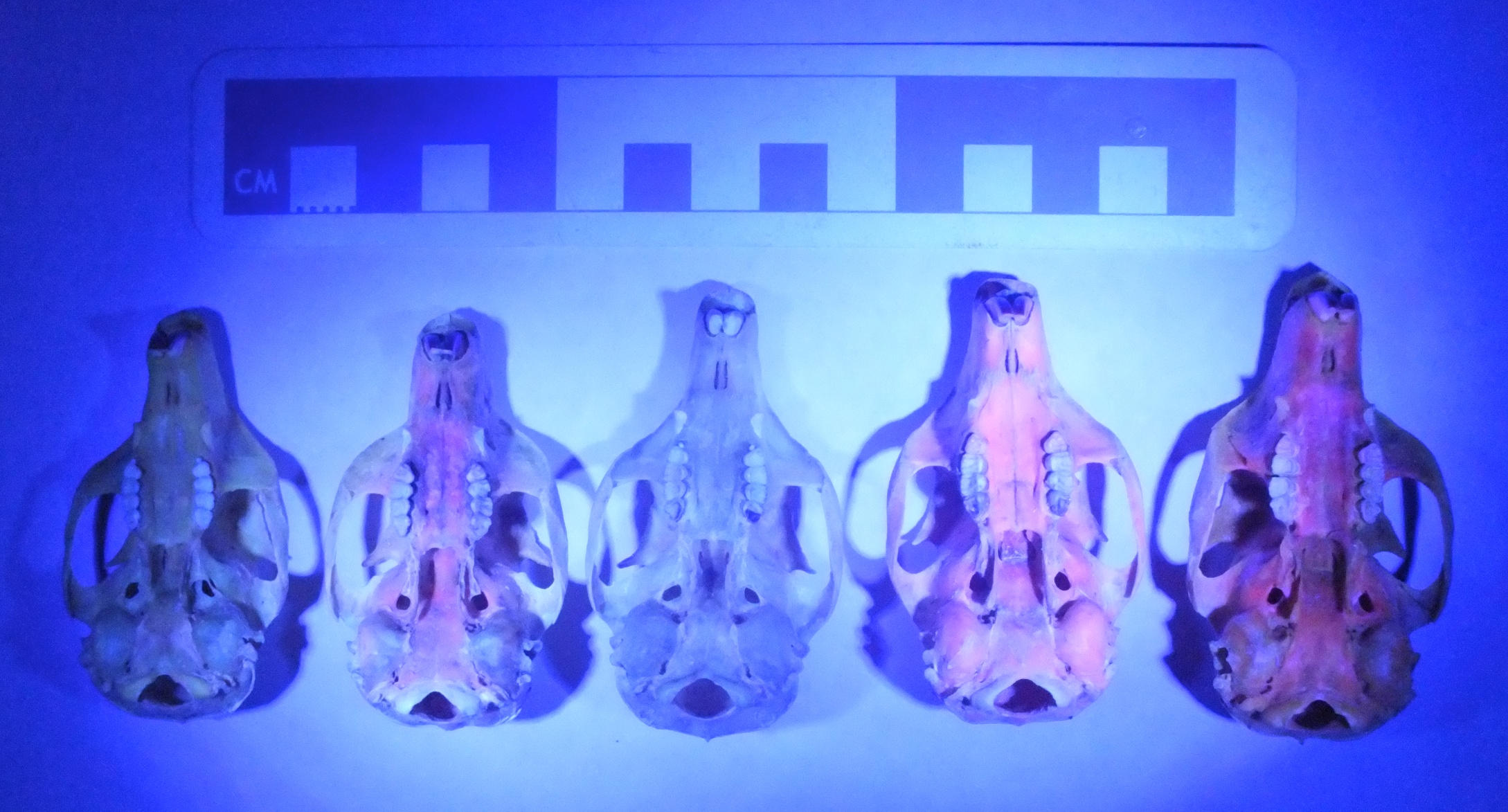 The 2nd, 4th, and 5th skulls all fluoresce, and are all fox squirrels.CEP has been reported as a rare condition in several different mammal species, including humans. It’s typically a pretty dreadful condition that results in photosensitivity, skin lesions, and anemia among other problems. The combination of sensitivity to sunlight and anemia (requiring blood transfusions) has led to CEP sometimes being called "Vampire's disease". For some unknown reason, eastern fox squirrels don’t seem to suffer from the adverse effects of CEP even though they have elevated uroporphyrin levels.Biologists have known since the 1930’s that fox squirrels have fluorescent bones (Turner, 1937), and that sometimes they’re even pink under visible light. There were a few studies in the 1970’s looking at the condition in some detail (Levin and Flyger 1971, for example), but somehow this knowledge was never applied to fossil remains. The question, of course, is that since a particular protein is responsible for the fluorescence, would it still be detectable in ancient specimens?The Florida Museum of Natural History lists several specimens of S. niger among their Pleistocene/early Holocene collections, and they happened to be the host for the 2011 SeAVP meeting. The day before the meeting I spent a few hours in their collection with a tray of squirrel bones from Devil’s Den Sinkhole and a UV light. Sure enough, even though these bones have been sitting at the bottom of a sinkhole (that’s currently flooded) for at least 7,000 years*, several of the bones still fluoresce. The best example was this partial skull:
The 2nd, 4th, and 5th skulls all fluoresce, and are all fox squirrels.CEP has been reported as a rare condition in several different mammal species, including humans. It’s typically a pretty dreadful condition that results in photosensitivity, skin lesions, and anemia among other problems. The combination of sensitivity to sunlight and anemia (requiring blood transfusions) has led to CEP sometimes being called "Vampire's disease". For some unknown reason, eastern fox squirrels don’t seem to suffer from the adverse effects of CEP even though they have elevated uroporphyrin levels.Biologists have known since the 1930’s that fox squirrels have fluorescent bones (Turner, 1937), and that sometimes they’re even pink under visible light. There were a few studies in the 1970’s looking at the condition in some detail (Levin and Flyger 1971, for example), but somehow this knowledge was never applied to fossil remains. The question, of course, is that since a particular protein is responsible for the fluorescence, would it still be detectable in ancient specimens?The Florida Museum of Natural History lists several specimens of S. niger among their Pleistocene/early Holocene collections, and they happened to be the host for the 2011 SeAVP meeting. The day before the meeting I spent a few hours in their collection with a tray of squirrel bones from Devil’s Den Sinkhole and a UV light. Sure enough, even though these bones have been sitting at the bottom of a sinkhole (that’s currently flooded) for at least 7,000 years*, several of the bones still fluoresce. The best example was this partial skull: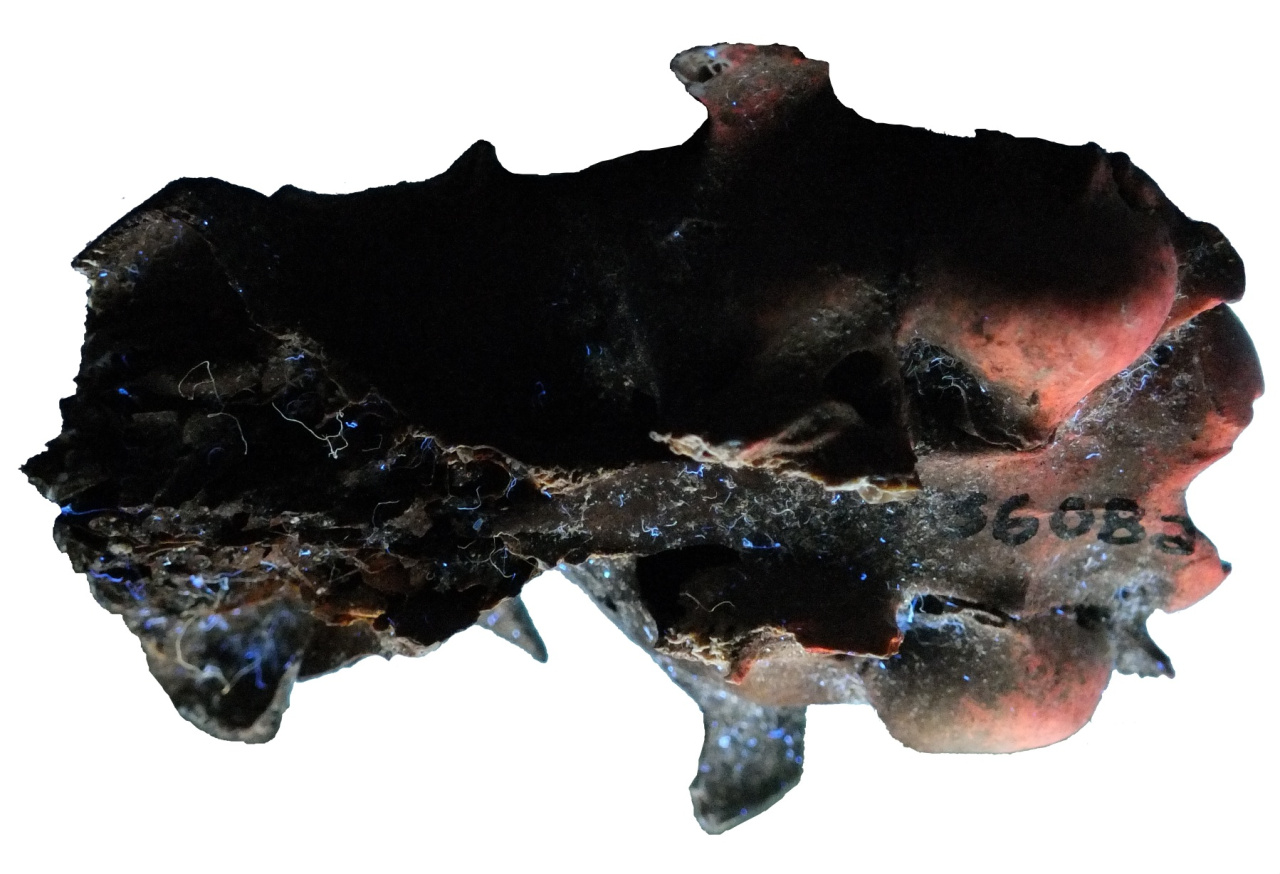 There’s definitely a high “coolness” factor here; we diagnosed a genetic condition in a late Pleistocene/early Holocene squirrel! But in addition to that, we’ve given ourselves a pretty powerful tool for examining ancient squirrels. To be sure, there are limitations: the fluorescence seems to disappear if the bones have been mineralized, and the condition may not be truly universal in S. niger. Therefore, this only works as a positive test for the presence of S. niger; the absence of fluorescence doesn’t definitively tell us anything. But on the other hand, this allows us to identify even fragmentary postcranial remains, the test is non-destructive and inexpensive, and the results are immediate. And it’s spectacularly easy to use on mixed bone deposits, including samples obtained by screening. Here’s a sample of bones from multiple taxa obtained by screening a sediment sample from a late Holocene site:
There’s definitely a high “coolness” factor here; we diagnosed a genetic condition in a late Pleistocene/early Holocene squirrel! But in addition to that, we’ve given ourselves a pretty powerful tool for examining ancient squirrels. To be sure, there are limitations: the fluorescence seems to disappear if the bones have been mineralized, and the condition may not be truly universal in S. niger. Therefore, this only works as a positive test for the presence of S. niger; the absence of fluorescence doesn’t definitively tell us anything. But on the other hand, this allows us to identify even fragmentary postcranial remains, the test is non-destructive and inexpensive, and the results are immediate. And it’s spectacularly easy to use on mixed bone deposits, including samples obtained by screening. Here’s a sample of bones from multiple taxa obtained by screening a sediment sample from a late Holocene site: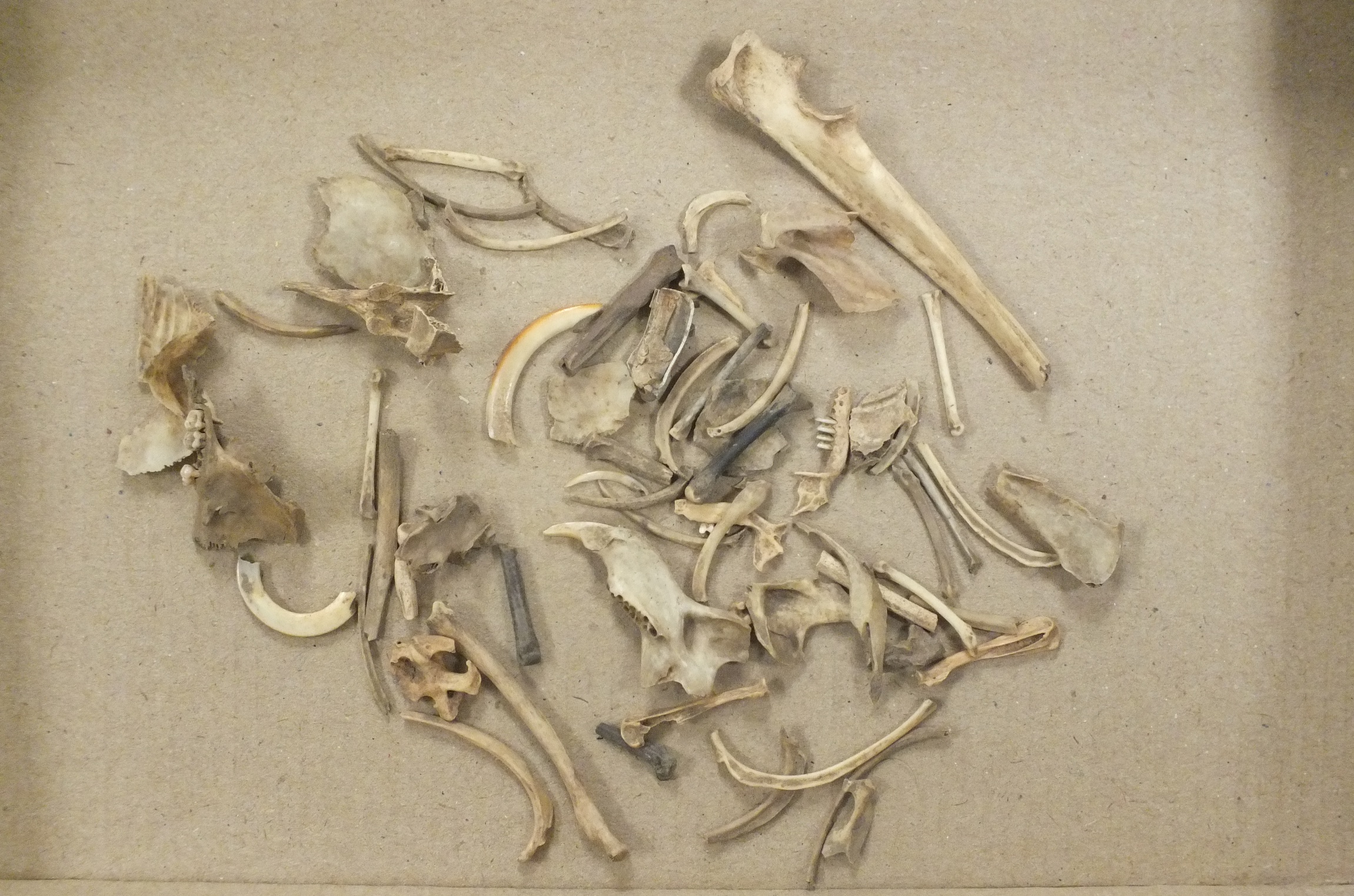 And here’s the same sample under UV:
And here’s the same sample under UV: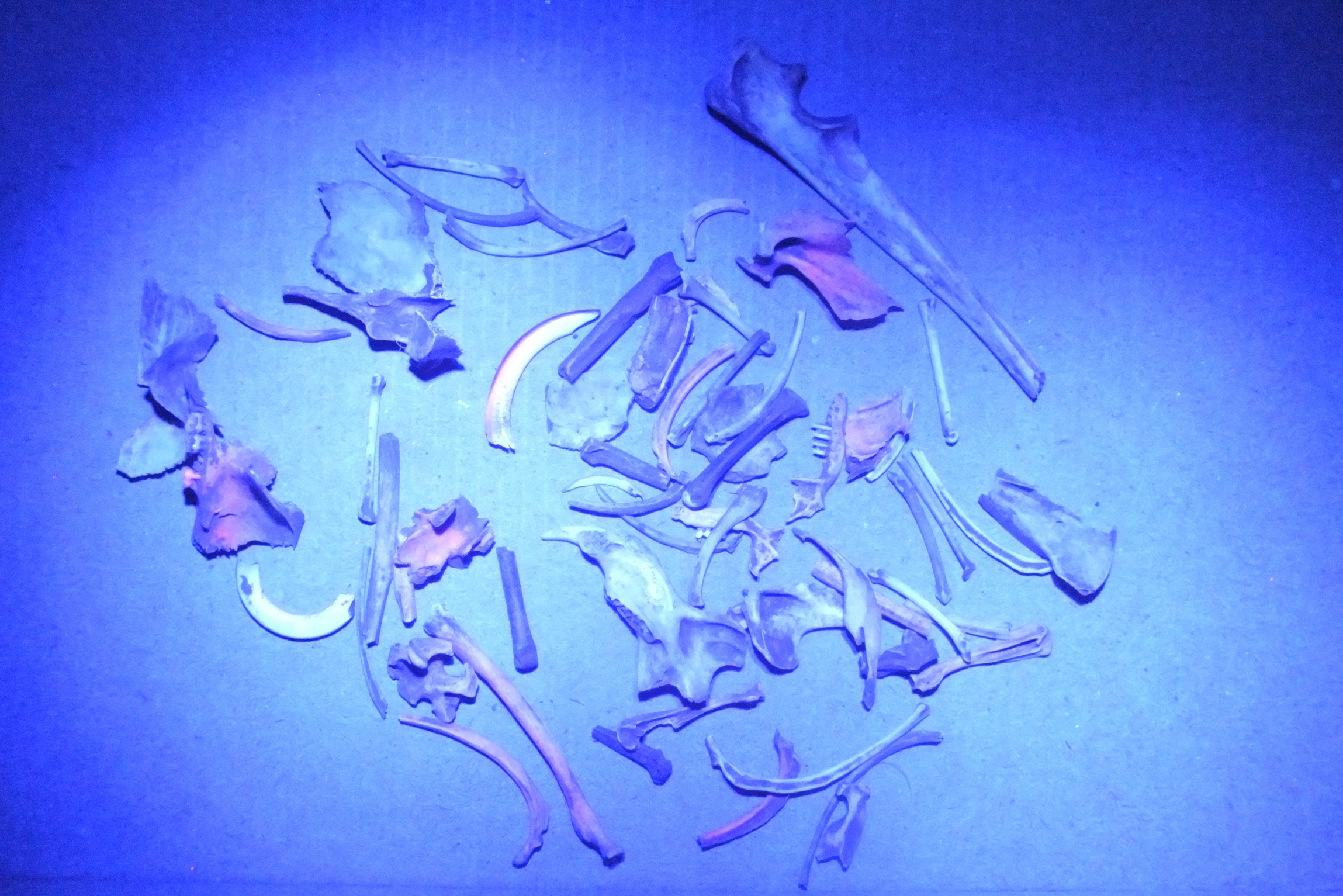 A dozen of these bones turned out to be fox squirrel (some of them are hard to spot in a photograph). They include difficult-to-identify elements like ribs; notice the two at the bottom center of the photo.Nancy and I published the results of our study of the Devil's Den fossil squirrels in 2012. In a follow-up paper in 2013, we examined squirrel remains from Native American archaeological sites in Virginia that were roughly 1,000 years old. Even though these specimens had in most cases been burned, they still fluoresced, as with this tibia:
A dozen of these bones turned out to be fox squirrel (some of them are hard to spot in a photograph). They include difficult-to-identify elements like ribs; notice the two at the bottom center of the photo.Nancy and I published the results of our study of the Devil's Den fossil squirrels in 2012. In a follow-up paper in 2013, we examined squirrel remains from Native American archaeological sites in Virginia that were roughly 1,000 years old. Even though these specimens had in most cases been burned, they still fluoresced, as with this tibia: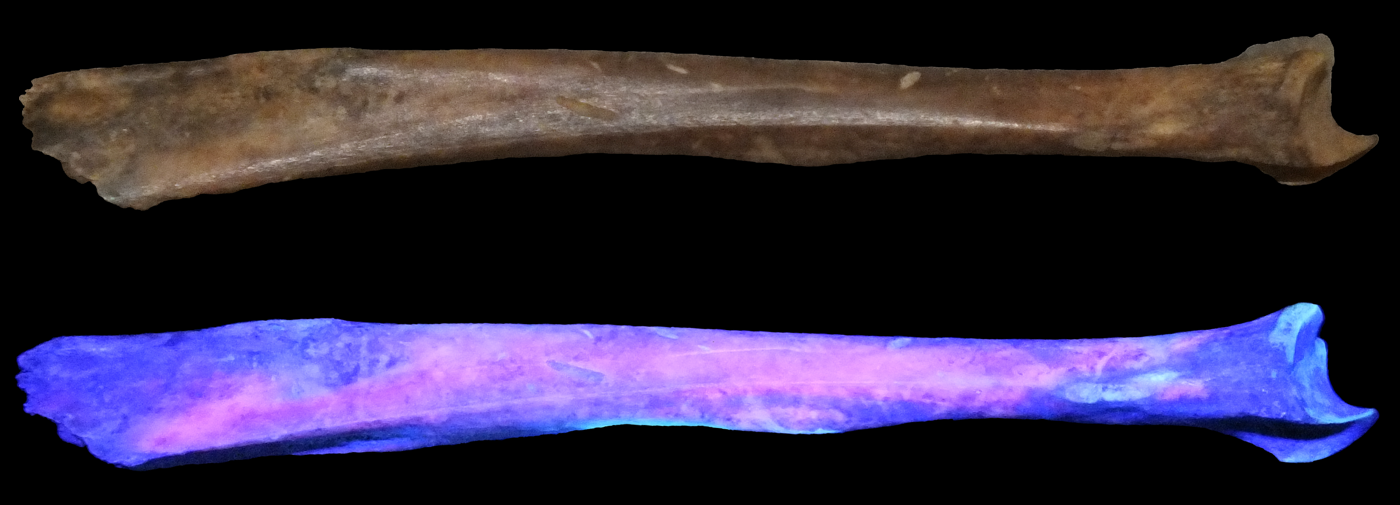 This research brought up a lot of additional questions that we never fully addressed. We found, both in the literature and from our own observations, that not all fox squirrels fluoresce equally, and a minority don’t seem to fluoresce at all. Why? Are some populations more prone to CEP, is there an ontogenetic component to uroporphyrin levels, or is there just a significant amount of individual variation? Moreover, certain elements seem to fluoresce particularly well (for example, the maxillae, the dentaries, the incisors, and the 4th upper premolars) while others often don’t fluoresce at all (like the nasals and the molars). Since moving to California, I've also learned that there is an introduced population of Eastern fox squirrels in Los Angeles County, which have been isolated from other S. niger populations now for toughly 100 years. I've not yet had the chance to examine one of these squirrels, but I wonder if their bones still fluoresce?*There’s some uncertainty about the age of the Devil’s Den deposits. They were published as being approximately 7,000 years old, but the presence of extinct animals such as mastodonts in the same deposit indicates that it is more likely late Pleistocene (Martin and Webb, 1974).References:
This research brought up a lot of additional questions that we never fully addressed. We found, both in the literature and from our own observations, that not all fox squirrels fluoresce equally, and a minority don’t seem to fluoresce at all. Why? Are some populations more prone to CEP, is there an ontogenetic component to uroporphyrin levels, or is there just a significant amount of individual variation? Moreover, certain elements seem to fluoresce particularly well (for example, the maxillae, the dentaries, the incisors, and the 4th upper premolars) while others often don’t fluoresce at all (like the nasals and the molars). Since moving to California, I've also learned that there is an introduced population of Eastern fox squirrels in Los Angeles County, which have been isolated from other S. niger populations now for toughly 100 years. I've not yet had the chance to examine one of these squirrels, but I wonder if their bones still fluoresce?*There’s some uncertainty about the age of the Devil’s Den deposits. They were published as being approximately 7,000 years old, but the presence of extinct animals such as mastodonts in the same deposit indicates that it is more likely late Pleistocene (Martin and Webb, 1974).References:
Fossil Friday - hadrosaur metatarsal
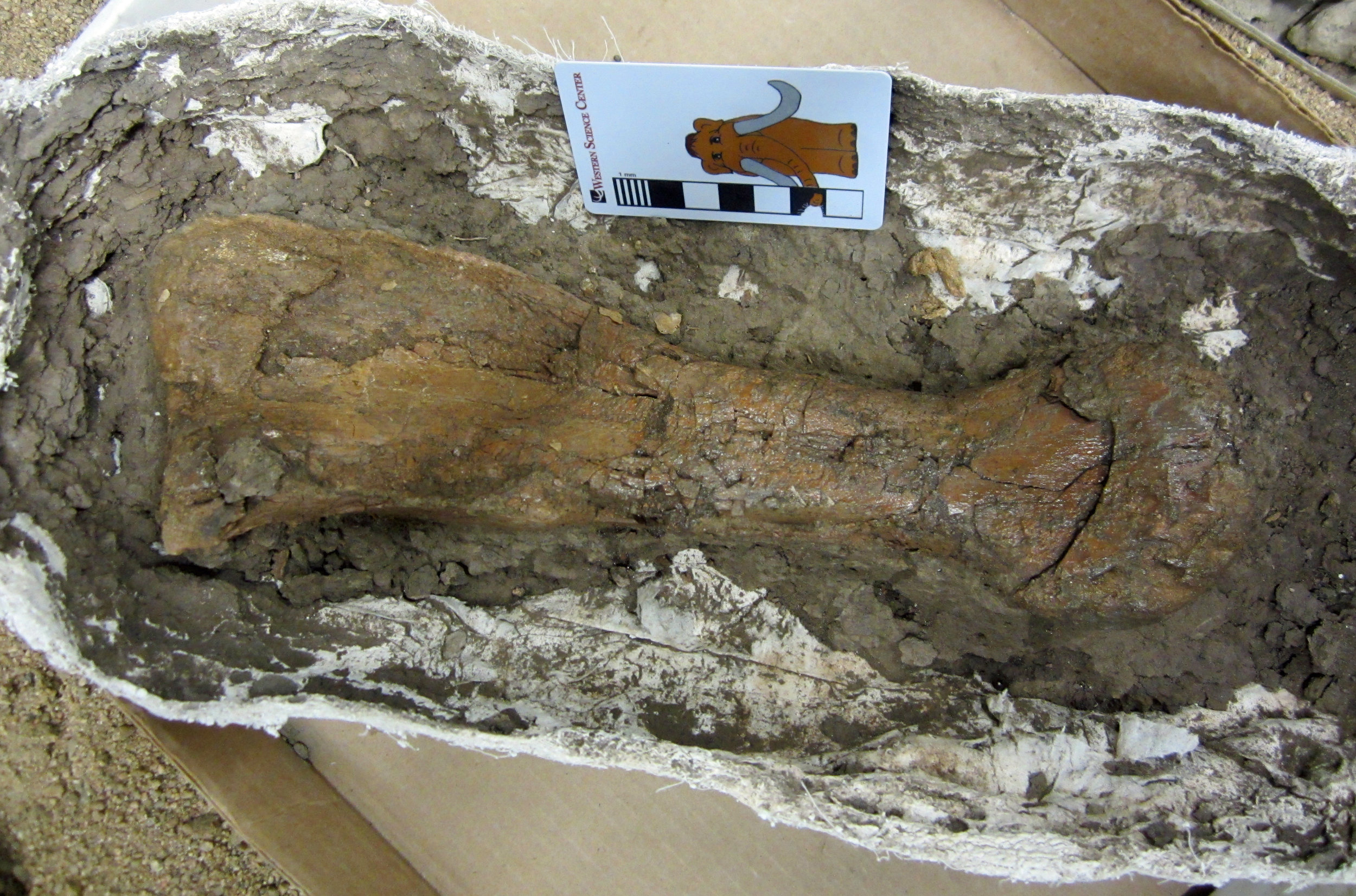 Discovering a dinosaur skeleton is a rare and special event.Most often, when out exploring in the badlands of New Mexico, we find isolated bones. However, even an isolated bone offers a wealth of information, about what kinds of animals were living in the area 79 million years ago, the depositional environment, and any unusual anatomical features or pathologies. Every summer, we collect numerous isolated bones of dinosaurs, crocodiles, and other animals from the Menefee Formation.Western Science Center prep lab volunteer John Deleon recently began preparing this dinosaur bone, which was collected by Southwest Paleontological Society volunteers Ben Mohler and Jake Kudlinski during our expedition last June. No other bones were found nearby, but this bone itself is well preserved and certainly worthy of the effort and study. It is a metatarsal, one of the large foot bones situated between the ankle and the toes, and probably belonged to a duck-billed plant-eating hadrosaur. Isolated hadrosaur bones, mostly limb bones and vertebrae, are the most commonly found dinosaur fossils in the Menefee Formation, suggesting that hadrosaurs probably were quite abundant in the ancient ecosystem. We'll be able to compare this bone to other limb bones we have collected over the years.Post by Curator Dr. Andrew McDonald.
Discovering a dinosaur skeleton is a rare and special event.Most often, when out exploring in the badlands of New Mexico, we find isolated bones. However, even an isolated bone offers a wealth of information, about what kinds of animals were living in the area 79 million years ago, the depositional environment, and any unusual anatomical features or pathologies. Every summer, we collect numerous isolated bones of dinosaurs, crocodiles, and other animals from the Menefee Formation.Western Science Center prep lab volunteer John Deleon recently began preparing this dinosaur bone, which was collected by Southwest Paleontological Society volunteers Ben Mohler and Jake Kudlinski during our expedition last June. No other bones were found nearby, but this bone itself is well preserved and certainly worthy of the effort and study. It is a metatarsal, one of the large foot bones situated between the ankle and the toes, and probably belonged to a duck-billed plant-eating hadrosaur. Isolated hadrosaur bones, mostly limb bones and vertebrae, are the most commonly found dinosaur fossils in the Menefee Formation, suggesting that hadrosaurs probably were quite abundant in the ancient ecosystem. We'll be able to compare this bone to other limb bones we have collected over the years.Post by Curator Dr. Andrew McDonald.
Fossil Friday - Zygolophodon tooth
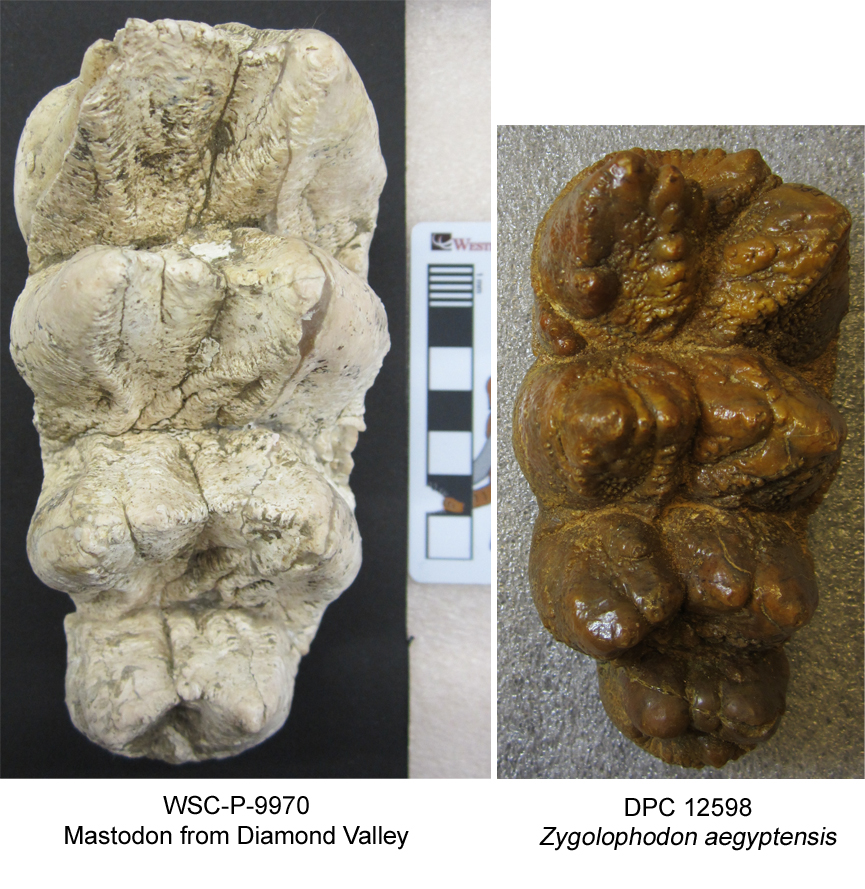 Last week, I visited the Division of Fossil Primates at the Duke Lemur Center in Durham, North Carolina. They have a great collection of fossil proboscideans from Egypt, including early forms like Moeritherium and Paleomastodon, as well as later, larger species such as Gomphotherium angustidens.I was there especially to see four teeth, the only known fossils of Zygolophodon aegyptensis. The genus Zygolophodon is long-lived and widespread, including many other species from Europe, Asia, and North America. At about 18 million years old, Z. aegyptensis is among the oldest. Zygolophodon is a member of the group Mammutidae, making it a close relative of North America's mastodons, including those found at Diamond Valley and housed at Western Science Center.The image here is DPC 12598, an upper molar (right M3) of Zygolophodon aegyptensis, and a left M3 of a mastodon from Diamond Valley (WSC-P-9970) set to the same scale. My Western Science Center colleagues and I are working with paleontologists at several other institutions to explore the whole evolutionary history of Mammutidae. Visiting other museums to examine fossils of other species and comparing them to the bounty of mastodons from Diamond Valley is one of the first steps on this journey.My thanks to Catherine Riddle of the Division of Fossil Primates for her assistance during my visit.Post by Curator Dr. Andrew McDonald.
Last week, I visited the Division of Fossil Primates at the Duke Lemur Center in Durham, North Carolina. They have a great collection of fossil proboscideans from Egypt, including early forms like Moeritherium and Paleomastodon, as well as later, larger species such as Gomphotherium angustidens.I was there especially to see four teeth, the only known fossils of Zygolophodon aegyptensis. The genus Zygolophodon is long-lived and widespread, including many other species from Europe, Asia, and North America. At about 18 million years old, Z. aegyptensis is among the oldest. Zygolophodon is a member of the group Mammutidae, making it a close relative of North America's mastodons, including those found at Diamond Valley and housed at Western Science Center.The image here is DPC 12598, an upper molar (right M3) of Zygolophodon aegyptensis, and a left M3 of a mastodon from Diamond Valley (WSC-P-9970) set to the same scale. My Western Science Center colleagues and I are working with paleontologists at several other institutions to explore the whole evolutionary history of Mammutidae. Visiting other museums to examine fossils of other species and comparing them to the bounty of mastodons from Diamond Valley is one of the first steps on this journey.My thanks to Catherine Riddle of the Division of Fossil Primates for her assistance during my visit.Post by Curator Dr. Andrew McDonald.
Fossil Friday - grasshopper mouse
 Abstract deadlines are coming up for conferences taking place in the first 6 months of 2019, so we're trying to collect as much data as possible for our submissions. One of these is a follow-up to our abstracts from last year on the Harveston locality in Temecula, but this time looking at the small animals ("microvertebrates"). One of our high school volunteers (or "Max's Minions", as we call them), Charlotte Hohman, is taking the lead on this project, sorting vials of tiny rodent, lizard, and bird bones and trying to identify them. This week we may have found a bone from a relatively uncommon mouse, the most metal mouse in Southern California.The bone in question is a left calcaneus (heel bone). The image isn't the greatest because it was taken by holding an iPhone up to a microscope eyepiece; we just wanted a quick reference image. The total length is about 5 mm.After comparing this to references, we're pretty sure this calcaneus comes from a southern grasshopper mouse, Onychomys torridus. If correct, this is our first grasshopper mouse from Harveston. Onychomys is known from the Diamond Valley Lake fauna, but is quite rare compared to the other rodents (in fact, I think we have more mastodons than grasshopper mice!).So this is just a mouse; what makes it metal? Unlike their close relatives such as deer mice, which are omnivores leaning toward herbivory, grasshopper mice are voracious predators. They primarily eat insects and other arthropods, but will eat other mice on occasion.They are known especially for eating bark scorpions. Apparently, when stung by a scorpion, the mouse's pain receptors shut down; even though they may get stung multiple times, they don't feel the pain. Northern grasshopper mice will attack centipedes, which are also venomous; the mouse is just fast and sting (I haven't been able to confirm if southern grasshopper mice also eat centipedes).And, if all that isn't enough, grasshopper mice are territorial. But their territories can be over 20 acres (!), and they'll warn away interlopers by howling with a high-pitched scream. Presumably if that doesn't work they just eat the invader.
Abstract deadlines are coming up for conferences taking place in the first 6 months of 2019, so we're trying to collect as much data as possible for our submissions. One of these is a follow-up to our abstracts from last year on the Harveston locality in Temecula, but this time looking at the small animals ("microvertebrates"). One of our high school volunteers (or "Max's Minions", as we call them), Charlotte Hohman, is taking the lead on this project, sorting vials of tiny rodent, lizard, and bird bones and trying to identify them. This week we may have found a bone from a relatively uncommon mouse, the most metal mouse in Southern California.The bone in question is a left calcaneus (heel bone). The image isn't the greatest because it was taken by holding an iPhone up to a microscope eyepiece; we just wanted a quick reference image. The total length is about 5 mm.After comparing this to references, we're pretty sure this calcaneus comes from a southern grasshopper mouse, Onychomys torridus. If correct, this is our first grasshopper mouse from Harveston. Onychomys is known from the Diamond Valley Lake fauna, but is quite rare compared to the other rodents (in fact, I think we have more mastodons than grasshopper mice!).So this is just a mouse; what makes it metal? Unlike their close relatives such as deer mice, which are omnivores leaning toward herbivory, grasshopper mice are voracious predators. They primarily eat insects and other arthropods, but will eat other mice on occasion.They are known especially for eating bark scorpions. Apparently, when stung by a scorpion, the mouse's pain receptors shut down; even though they may get stung multiple times, they don't feel the pain. Northern grasshopper mice will attack centipedes, which are also venomous; the mouse is just fast and sting (I haven't been able to confirm if southern grasshopper mice also eat centipedes).And, if all that isn't enough, grasshopper mice are territorial. But their territories can be over 20 acres (!), and they'll warn away interlopers by howling with a high-pitched scream. Presumably if that doesn't work they just eat the invader.
Fossil Friday - crocodile skull
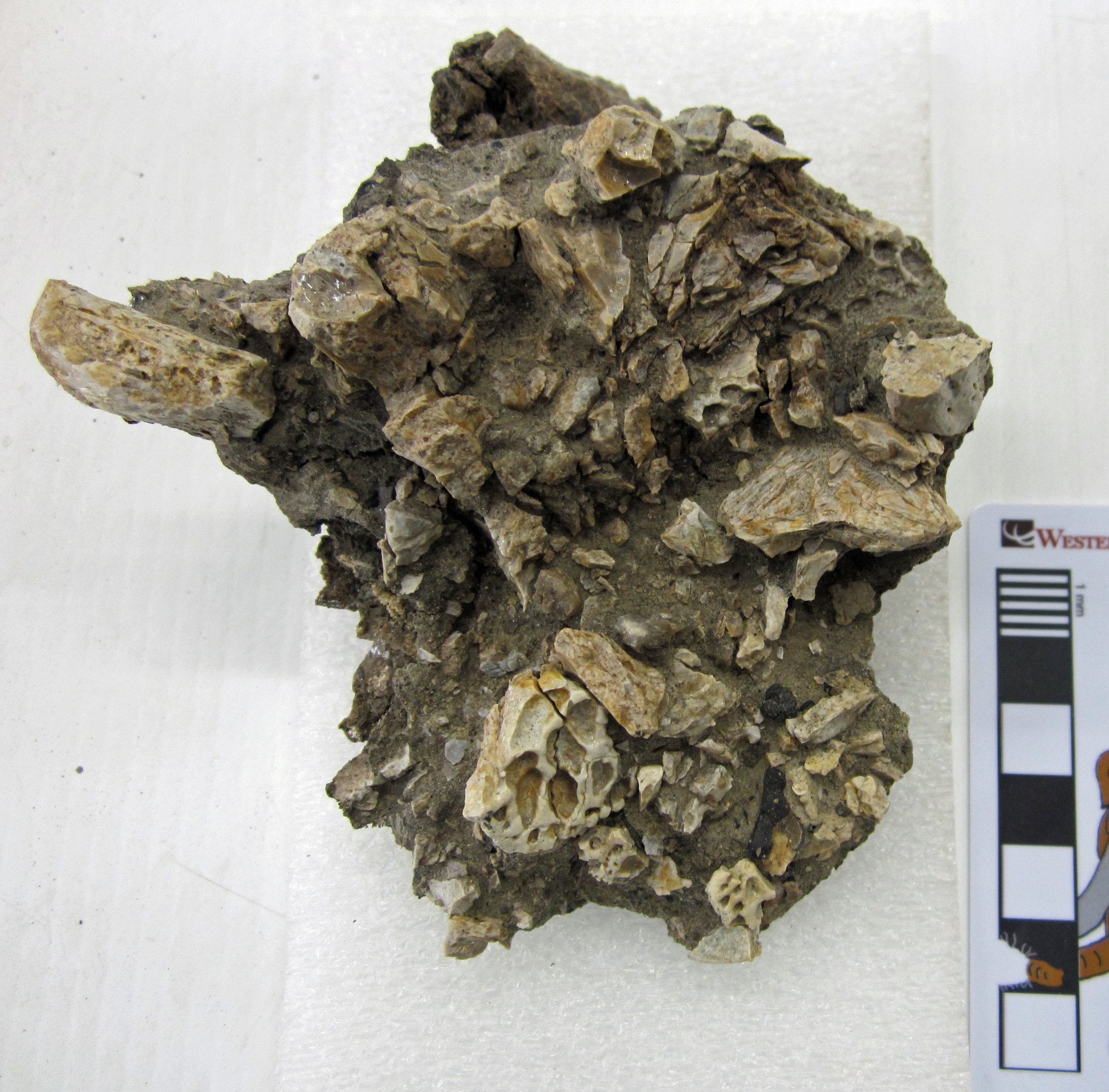 Giant reptiles abound in our field area in New Mexico. Big dinosaurs like Invictarx, Dynamoterror, and the hadrosaur we're working on now; hefty crocodiles; and even sizable turtles are the most commonly found animals in the 79-million-year-old rocks of the Menefee Formation. Fossils of small creatures are comparatively rare, and skull material for any animal is pretty thin on the ground as well.During the expedition in May with our partners at Zuni Dinosaur Institute for Geosciences, three volunteers from the Southwest Paleontological Society collected a small mass of bone with a distinctive heavily pitted texture that resembles modern crocodilian skulls. In the field, we tentatively identified it as part of a crocodilian skull. We opened up the little plaster jacket here at Western Science Center this week, and confirmed that it is indeed the partial skull of a small crocodilian. The dorsal surface of the skull is badly fragmented, but clearly shows that pitted texture. The ventral side is also highly weathered, but we can see the base of the braincase and the occipital condyle, the ball at the back of the skull that articulates with the first neck vertebra.
Giant reptiles abound in our field area in New Mexico. Big dinosaurs like Invictarx, Dynamoterror, and the hadrosaur we're working on now; hefty crocodiles; and even sizable turtles are the most commonly found animals in the 79-million-year-old rocks of the Menefee Formation. Fossils of small creatures are comparatively rare, and skull material for any animal is pretty thin on the ground as well.During the expedition in May with our partners at Zuni Dinosaur Institute for Geosciences, three volunteers from the Southwest Paleontological Society collected a small mass of bone with a distinctive heavily pitted texture that resembles modern crocodilian skulls. In the field, we tentatively identified it as part of a crocodilian skull. We opened up the little plaster jacket here at Western Science Center this week, and confirmed that it is indeed the partial skull of a small crocodilian. The dorsal surface of the skull is badly fragmented, but clearly shows that pitted texture. The ventral side is also highly weathered, but we can see the base of the braincase and the occipital condyle, the ball at the back of the skull that articulates with the first neck vertebra.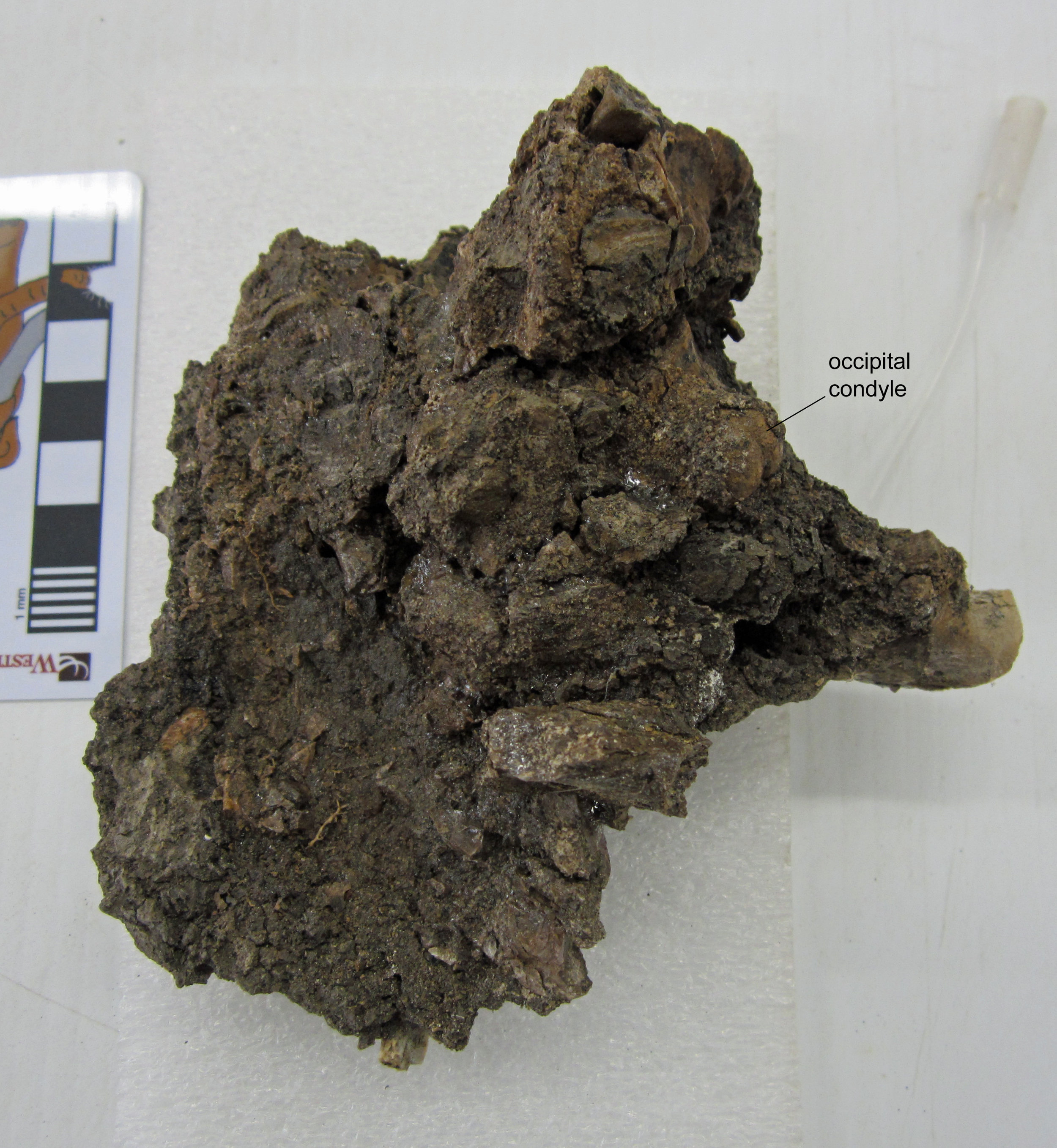 We're just beginning to prep this fossil. Right now, based on the size and skull texture, it might belong to an ancient alligator relative called Brachychampsa. Brachychampsa is known from many Upper Cretaceous formations in western North America, and was first identified in the Menefee Formation of New Mexico by paleontologist Tom Williamson (New Mexico Museum of Natural History and Science) in 1996. It's a small animal, just about six feet long, with a broad, blunt snout, as you can see on this mounted skeleton that I photographed at the Natural History Museum of Utah in Salt Lake City. We'll have much more to say about our little skull and the other Menefee crocodilians in the not too distant future.
We're just beginning to prep this fossil. Right now, based on the size and skull texture, it might belong to an ancient alligator relative called Brachychampsa. Brachychampsa is known from many Upper Cretaceous formations in western North America, and was first identified in the Menefee Formation of New Mexico by paleontologist Tom Williamson (New Mexico Museum of Natural History and Science) in 1996. It's a small animal, just about six feet long, with a broad, blunt snout, as you can see on this mounted skeleton that I photographed at the Natural History Museum of Utah in Salt Lake City. We'll have much more to say about our little skull and the other Menefee crocodilians in the not too distant future.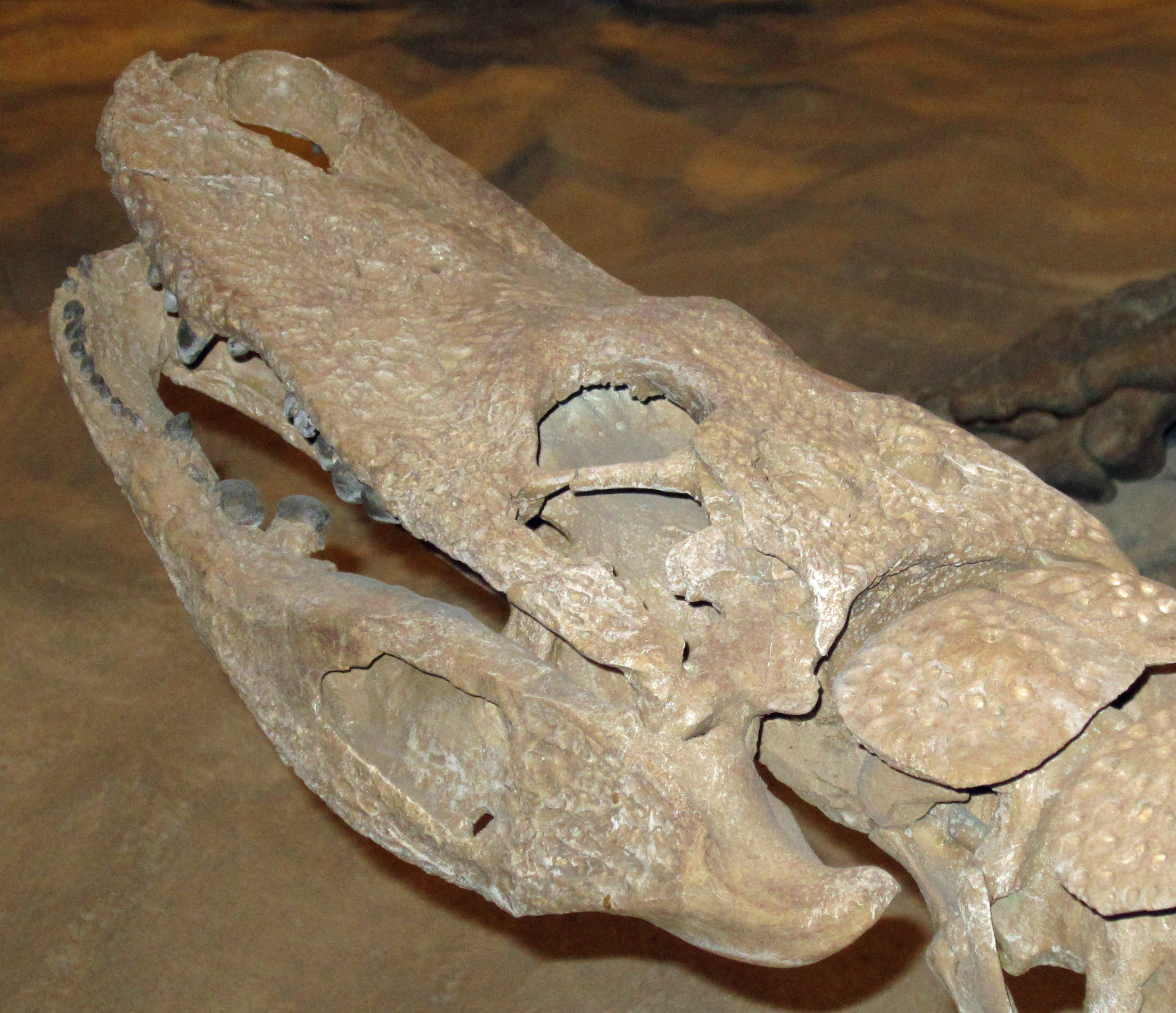 Post by Curator Dr. Andrew McDonald
Post by Curator Dr. Andrew McDonald
Fossil Friday - community on a half-shell
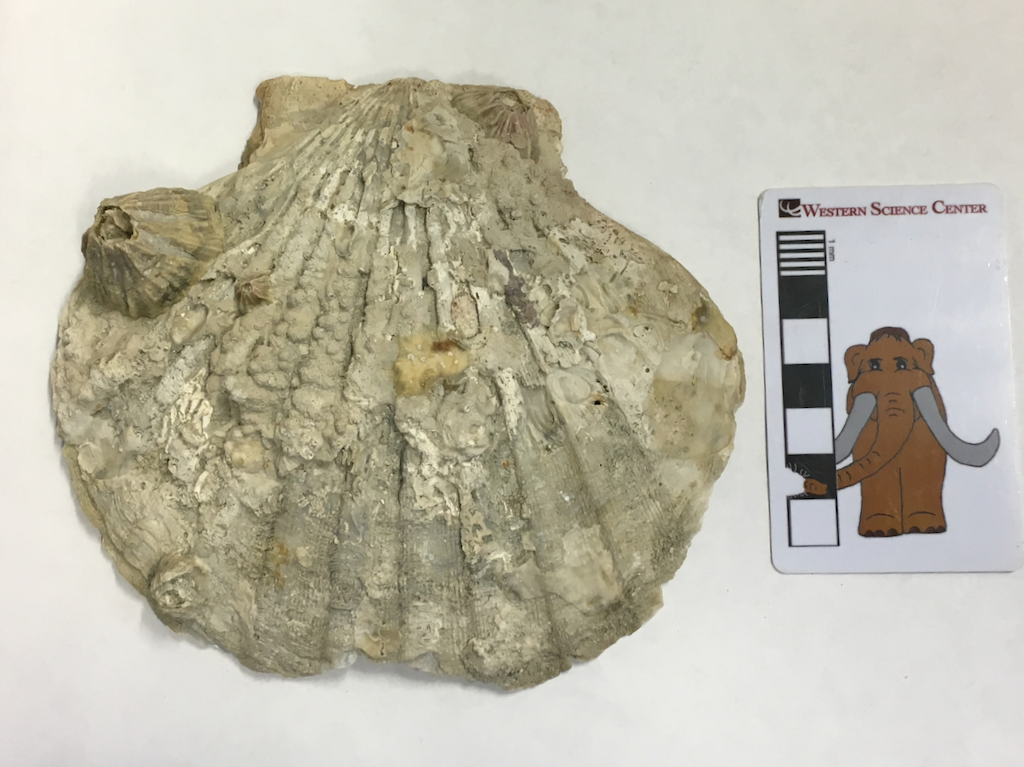 Life as a suspension feeder is a mixed blessing. Most suspension feeders are sessile, staying in one place for practically their entire life. They feed by extracting food particles from water, using a bewildering variety of suction tubes, mucus nets, feathery appendages, and various other anatomical variations. Almost every phylum of animals and many protists include examples of suspension feeders. It's a lifestyle that could be regarded almost as idyllic, as you sway back and forth in the current, waiting on food to blunder into your mouth (for those suspension feeders that actually have mouths; not all do). But it can be treacherous, too. Those same currents that bring you your food can also rip you from your anchor point, carrying you off, where you may ironically end up as food for some other suspension feeder. Attaching to a solid, stable substrate is critical to survival for a suspension feeder, and in some environments there is a lot of competition for good spots.Above is a shell of the extinct scallop Chesapecten madisonius, a species that was abundant in warm-temperate waters of the western Atlantic during the Pliocene. This example came from a quarry near Chuckatuck, Virginia, from the 3-million-year-old Yorktown Formation. Scallops are suspension feeders, although they are capable of moving around. When they died, their large (up to the size of a dinner plate!) calcium carbonate shells would end up lying on the seafloor.At this particular location, the sediment is almost all sand, with huge numbers of broken seashells. Both the sediment and types and preservation of the shells indicate that this was an offshore shoaling area where waves were breaking in shallow water. With the constant water flow this was a great environment for suspension feeders, but the high energy and unconsolidated sandy bottom mean that hard substrates for attachment were at a premium. A large mineralized seashell sitting on the seafloor was too good to pass up, and a whole community of suspension feeders took advantage and settled on the shell.Some of these organisms are gone, but left traces behind indicating their presence. There are several pits at various places on the shell:
Life as a suspension feeder is a mixed blessing. Most suspension feeders are sessile, staying in one place for practically their entire life. They feed by extracting food particles from water, using a bewildering variety of suction tubes, mucus nets, feathery appendages, and various other anatomical variations. Almost every phylum of animals and many protists include examples of suspension feeders. It's a lifestyle that could be regarded almost as idyllic, as you sway back and forth in the current, waiting on food to blunder into your mouth (for those suspension feeders that actually have mouths; not all do). But it can be treacherous, too. Those same currents that bring you your food can also rip you from your anchor point, carrying you off, where you may ironically end up as food for some other suspension feeder. Attaching to a solid, stable substrate is critical to survival for a suspension feeder, and in some environments there is a lot of competition for good spots.Above is a shell of the extinct scallop Chesapecten madisonius, a species that was abundant in warm-temperate waters of the western Atlantic during the Pliocene. This example came from a quarry near Chuckatuck, Virginia, from the 3-million-year-old Yorktown Formation. Scallops are suspension feeders, although they are capable of moving around. When they died, their large (up to the size of a dinner plate!) calcium carbonate shells would end up lying on the seafloor.At this particular location, the sediment is almost all sand, with huge numbers of broken seashells. Both the sediment and types and preservation of the shells indicate that this was an offshore shoaling area where waves were breaking in shallow water. With the constant water flow this was a great environment for suspension feeders, but the high energy and unconsolidated sandy bottom mean that hard substrates for attachment were at a premium. A large mineralized seashell sitting on the seafloor was too good to pass up, and a whole community of suspension feeders took advantage and settled on the shell.Some of these organisms are gone, but left traces behind indicating their presence. There are several pits at various places on the shell: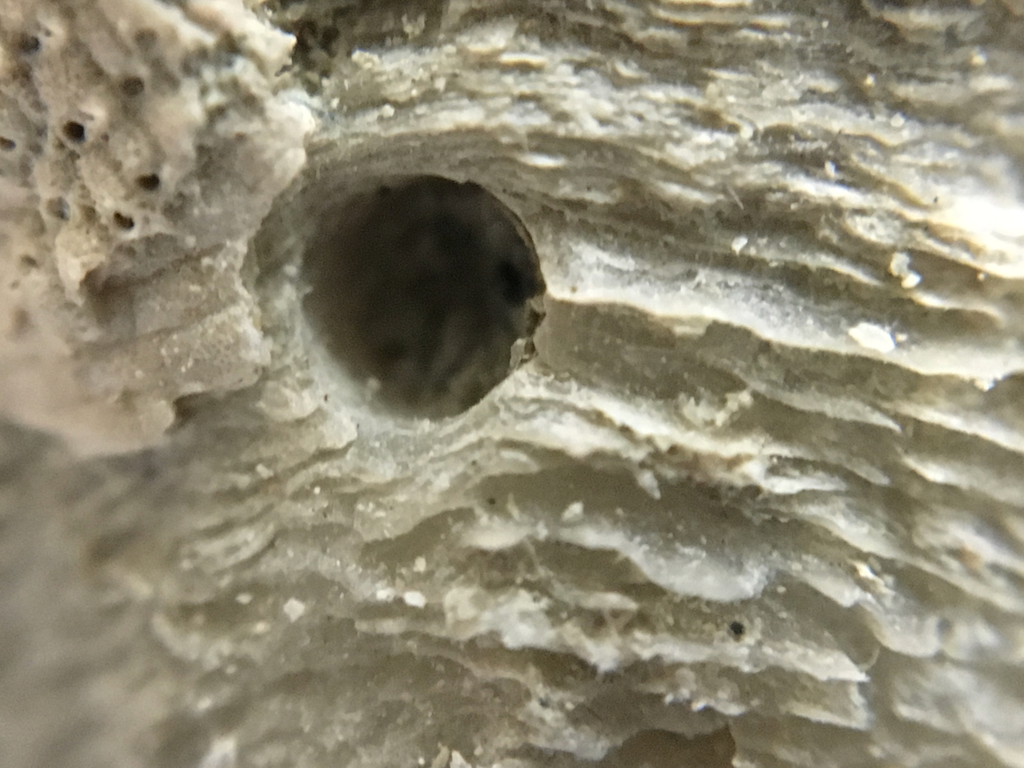
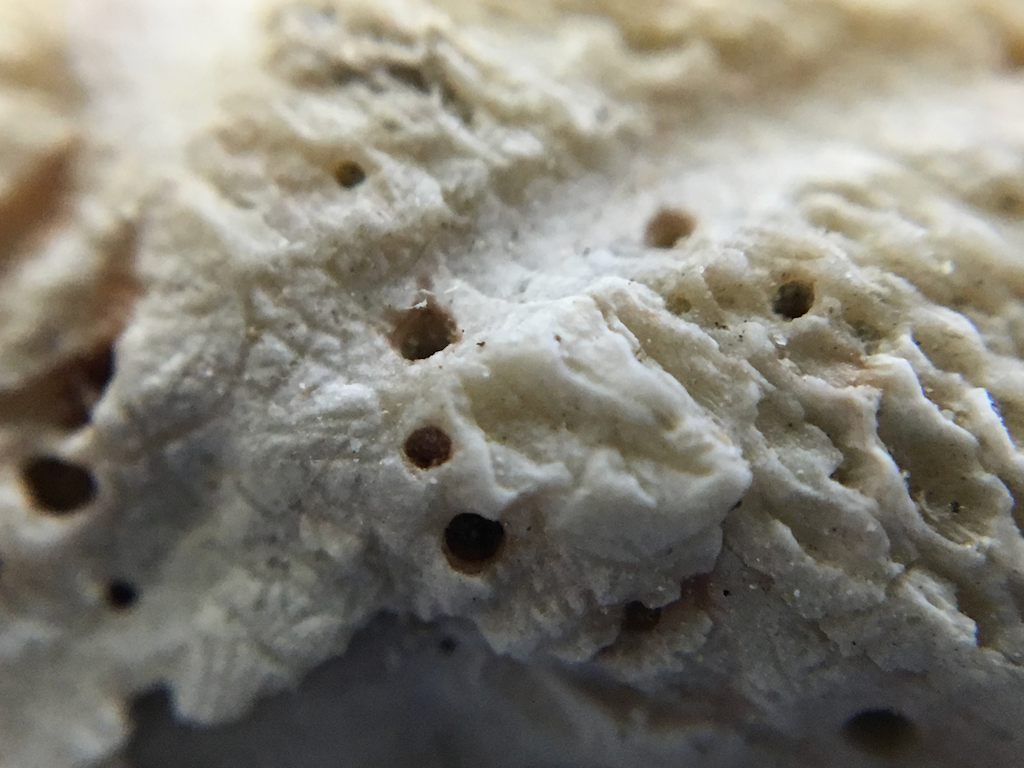 A few of these were probably made by predatory snails that attack other mollusks by drilling into their shells. Others were likely formed by cloned sponges, which chemically dissolve part of the target shell to provide living space.In other areas, parts of the shell have been broadly removed, leaving shallow sculpted depressions:
A few of these were probably made by predatory snails that attack other mollusks by drilling into their shells. Others were likely formed by cloned sponges, which chemically dissolve part of the target shell to provide living space.In other areas, parts of the shell have been broadly removed, leaving shallow sculpted depressions: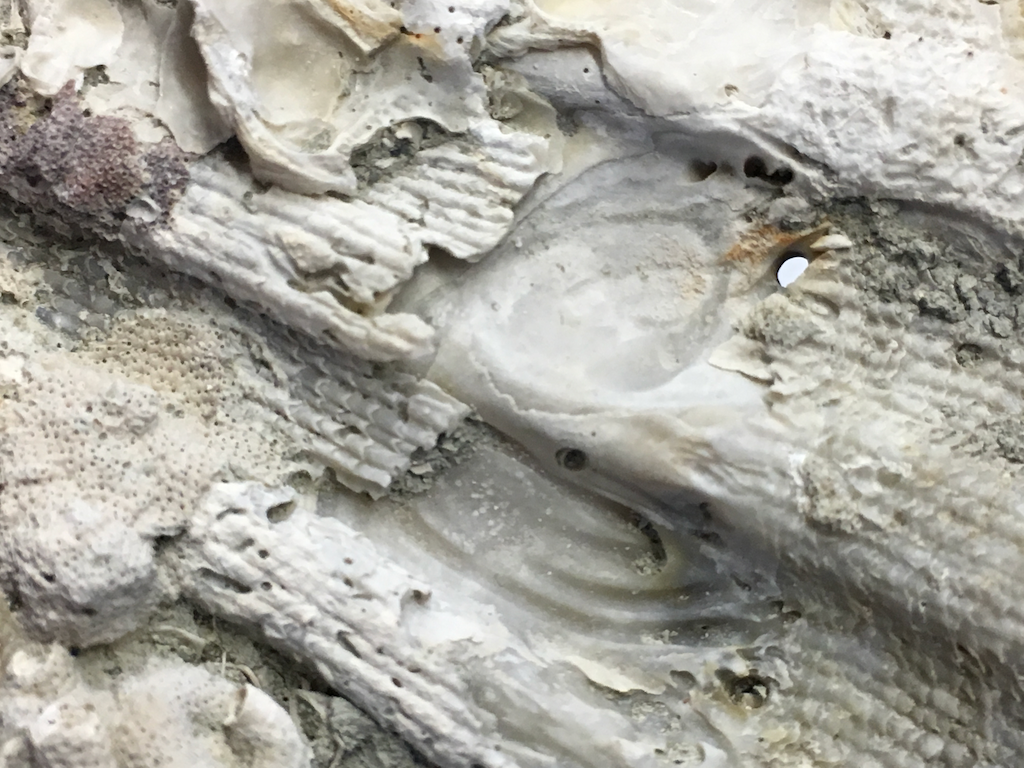 These were likely produced by another mollusk, possibly slipper snails such as Crepidula or boring clams from the family that includes shipworms (which are actually clams). Some were definitely clams of some sort, because one of the shells is still there (although I've not yet been able to identify the species):
These were likely produced by another mollusk, possibly slipper snails such as Crepidula or boring clams from the family that includes shipworms (which are actually clams). Some were definitely clams of some sort, because one of the shells is still there (although I've not yet been able to identify the species):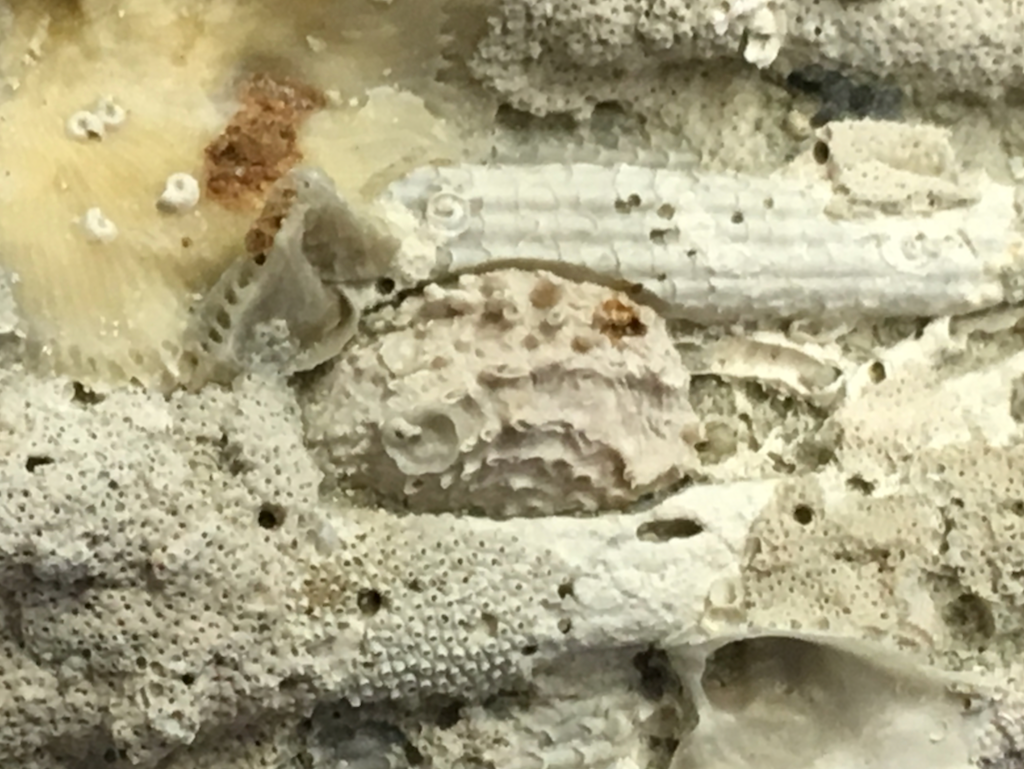 In many cases the colonizing organisms' shells are still present. The most obvious are these volcano-shaped structures:
In many cases the colonizing organisms' shells are still present. The most obvious are these volcano-shaped structures: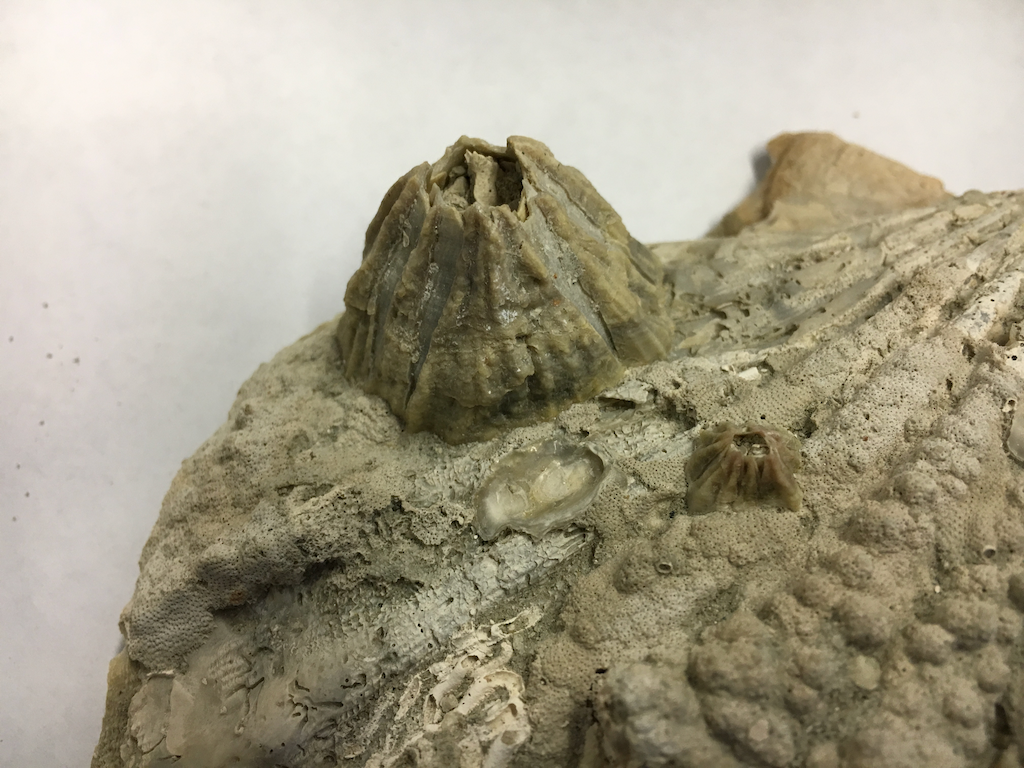 These are barnacles, sessile suspension-feeding crustaceans that are distantly related to shrimp (as a nod to the evolutionary imagination of suspension feeders, they collect food by waving their hairy legs around in the water). Sitting between two barnacles is (I think) an attachment point for an oyster:
These are barnacles, sessile suspension-feeding crustaceans that are distantly related to shrimp (as a nod to the evolutionary imagination of suspension feeders, they collect food by waving their hairy legs around in the water). Sitting between two barnacles is (I think) an attachment point for an oyster: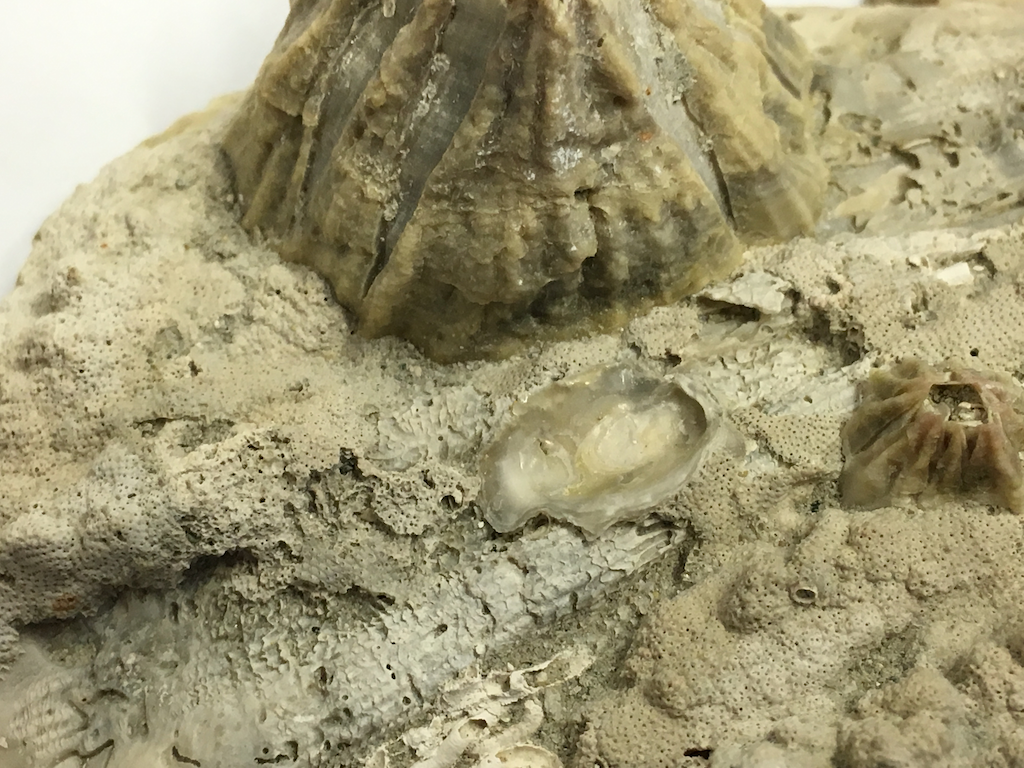 Nearby are small carbonate tubes. I believe these are tubes from polychaete worms (there are also clams that build carbonate tubes, but I'm pretty sure these are from worms):
Nearby are small carbonate tubes. I believe these are tubes from polychaete worms (there are also clams that build carbonate tubes, but I'm pretty sure these are from worms):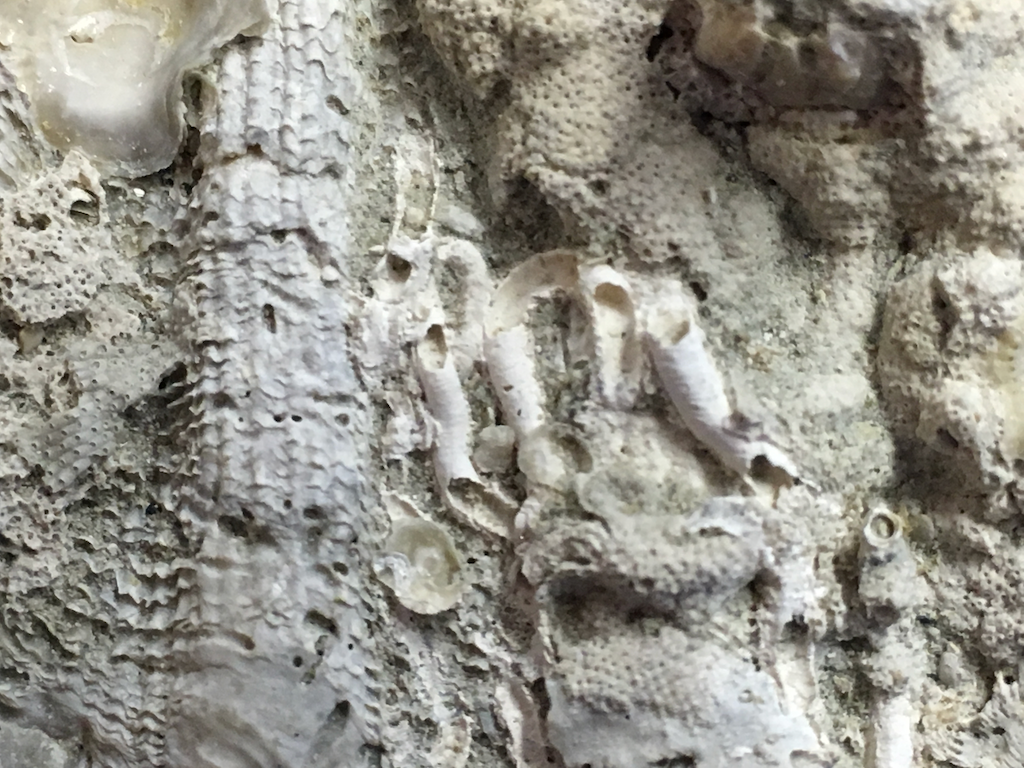 In terms of coverage area, the most extensive colonizers on this shell are bryozoans, or moss animals. These are colonial animals that are placed in their own phylum. Here's one of the larger colonies on this shell:
In terms of coverage area, the most extensive colonizers on this shell are bryozoans, or moss animals. These are colonial animals that are placed in their own phylum. Here's one of the larger colonies on this shell: Zooming in close, we can see the individual animals ("zooids") in the colony; each hole contained a zooid:
Zooming in close, we can see the individual animals ("zooids") in the colony; each hole contained a zooid: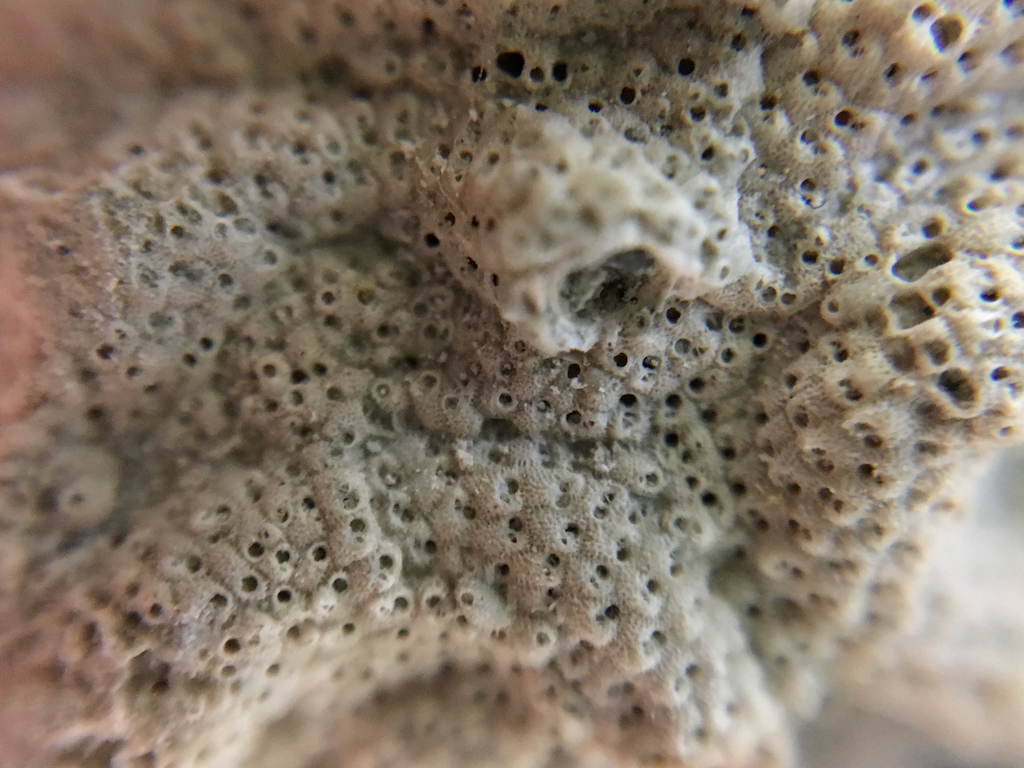 It seems that this shell was colonized by at least two species of bryozoans, because there's another area where the zooids look rather different:
It seems that this shell was colonized by at least two species of bryozoans, because there's another area where the zooids look rather different: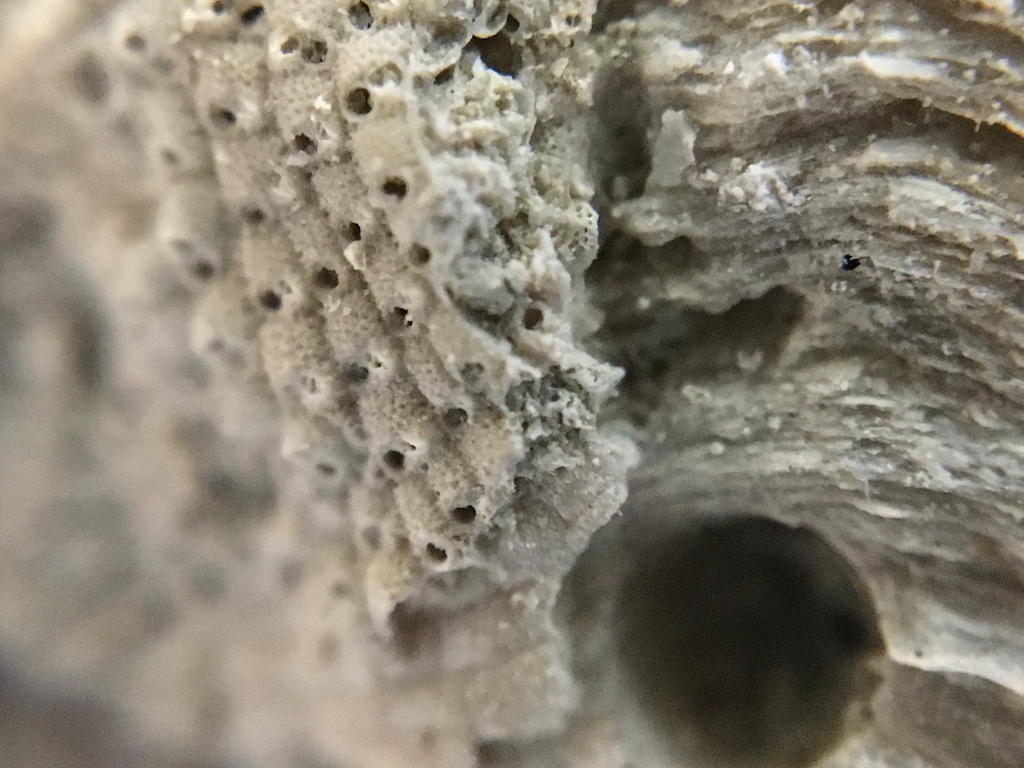 Finally, there's one I'm really uncertain about. There's one patch (the yellowish area at the center of the shell in the top image) where a barnacle attached itself on top of the bryozoan colony, and then fell off (the yellow area is the base of the barnacle). But, on top of that, there are a handful of tiny spiral shells, the largest of which is just under 1 mm in diameter:
Finally, there's one I'm really uncertain about. There's one patch (the yellowish area at the center of the shell in the top image) where a barnacle attached itself on top of the bryozoan colony, and then fell off (the yellow area is the base of the barnacle). But, on top of that, there are a handful of tiny spiral shells, the largest of which is just under 1 mm in diameter: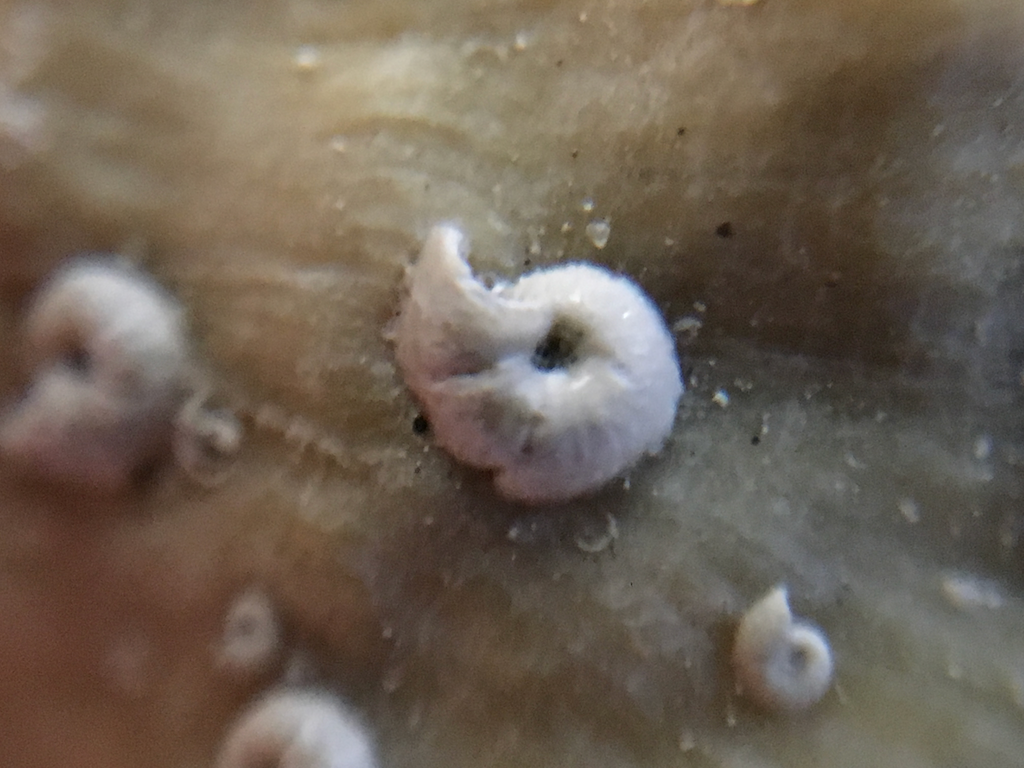 I'm not completely sure of my identification here, but I think these are benthic foraminifera. Foraminifera are amoeba-like, single-celled protists that secrete a calcium carbonate shell (in most species). There are perhaps a dozen of these visible, in addition to places where they were clearly present at one time and later removed.So, assuming all my identifications are correct, and counting everything up, this single Chesapecten shell supported:
I'm not completely sure of my identification here, but I think these are benthic foraminifera. Foraminifera are amoeba-like, single-celled protists that secrete a calcium carbonate shell (in most species). There are perhaps a dozen of these visible, in addition to places where they were clearly present at one time and later removed.So, assuming all my identifications are correct, and counting everything up, this single Chesapecten shell supported:
- A sponge
- At least a half-dozen bivalves, from at least two species
- At least 10 barnacles
- At least a dozen polychaete worms
- At least two bryozoan species each with several hundred individuals
- At least a dozen foraminifera
Not bad for a single seashell!
Fossil Friday - dinosaur jacket
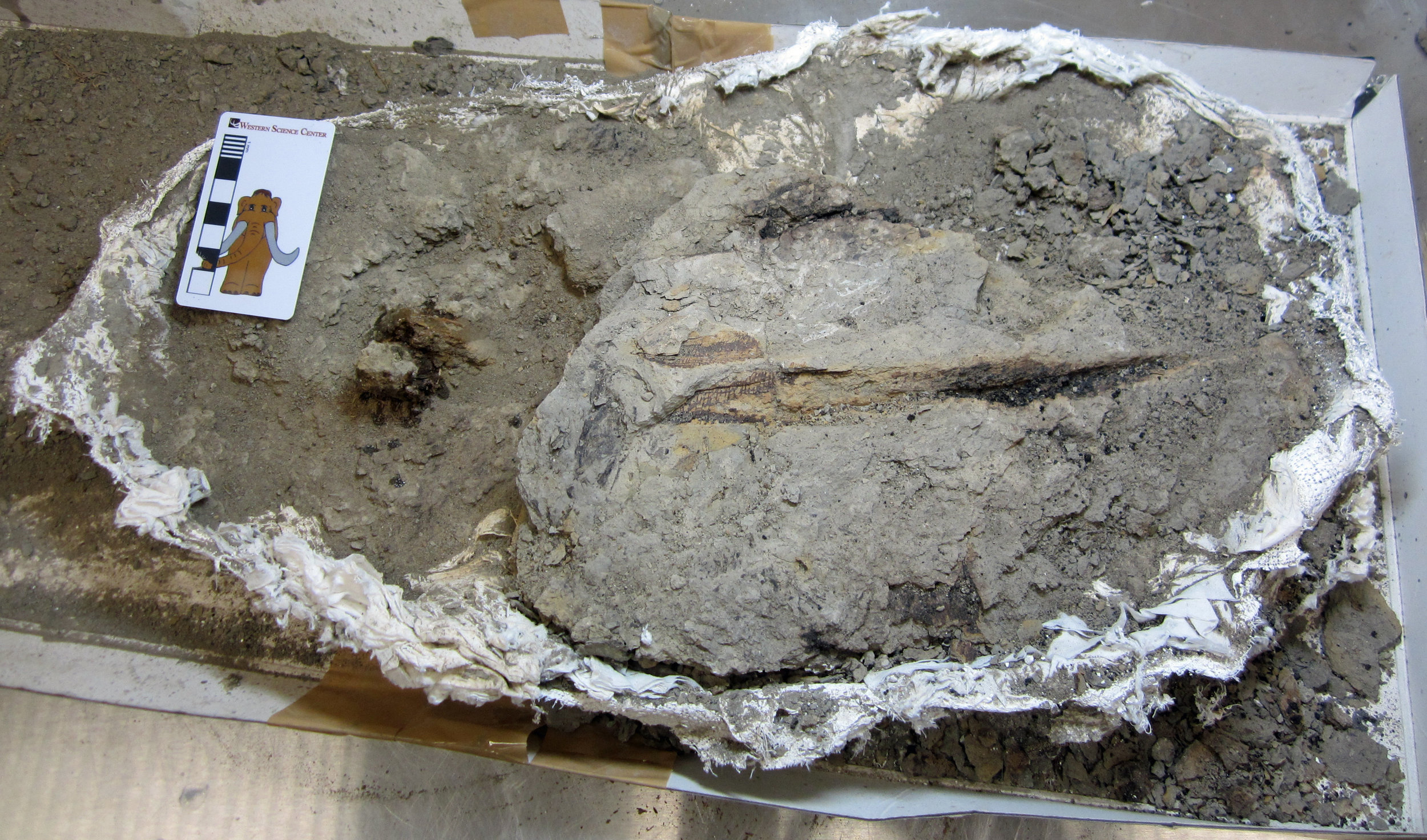 The fossil prep lab at Western Science Center is abuzz these days (literally, when the air scribes are blasting away). WSC staff and volunteers are working their way through the half-ton of fossils we brought back to the museum last summer from the Upper Cretaceous Menefee Formation of New Mexico.Much of our recent prep effort has focused on the hadrosaur skeleton I posted about back in September and October. We're now moving on to some of the smaller items we brought back.One of the new sites we documented and collected during the 2018 field season is a scatter of at least half a dozen dinosaur bones, discovered by WSC volunteer John DeLeon. Although the bones are highly weathered, we collected them all and got them safely back to the museum. Given their close association at the field site and the absence of any other fossil organisms, these bones probably all belong to the same individual dinosaur. John opened up the largest plaster jacket from the site yesterday. There is a little knob of bone exposed to the left in the image; the rest of the bone is underneath the fossilized tree branch to the right. We don't know what type of dinosaur is represented by these bones, but hopefully the answer will emerge as John continues his work.This specimen and all the Menefee fossils were collected by staff and volunteers from the Western Science Center, Zuni Dinosaur Institute for Geosciences, and Southwest Paleontological Society.Post by Curator Dr. Andrew McDonald
The fossil prep lab at Western Science Center is abuzz these days (literally, when the air scribes are blasting away). WSC staff and volunteers are working their way through the half-ton of fossils we brought back to the museum last summer from the Upper Cretaceous Menefee Formation of New Mexico.Much of our recent prep effort has focused on the hadrosaur skeleton I posted about back in September and October. We're now moving on to some of the smaller items we brought back.One of the new sites we documented and collected during the 2018 field season is a scatter of at least half a dozen dinosaur bones, discovered by WSC volunteer John DeLeon. Although the bones are highly weathered, we collected them all and got them safely back to the museum. Given their close association at the field site and the absence of any other fossil organisms, these bones probably all belong to the same individual dinosaur. John opened up the largest plaster jacket from the site yesterday. There is a little knob of bone exposed to the left in the image; the rest of the bone is underneath the fossilized tree branch to the right. We don't know what type of dinosaur is represented by these bones, but hopefully the answer will emerge as John continues his work.This specimen and all the Menefee fossils were collected by staff and volunteers from the Western Science Center, Zuni Dinosaur Institute for Geosciences, and Southwest Paleontological Society.Post by Curator Dr. Andrew McDonald
Fossil Friday - Squalodon whitmorei
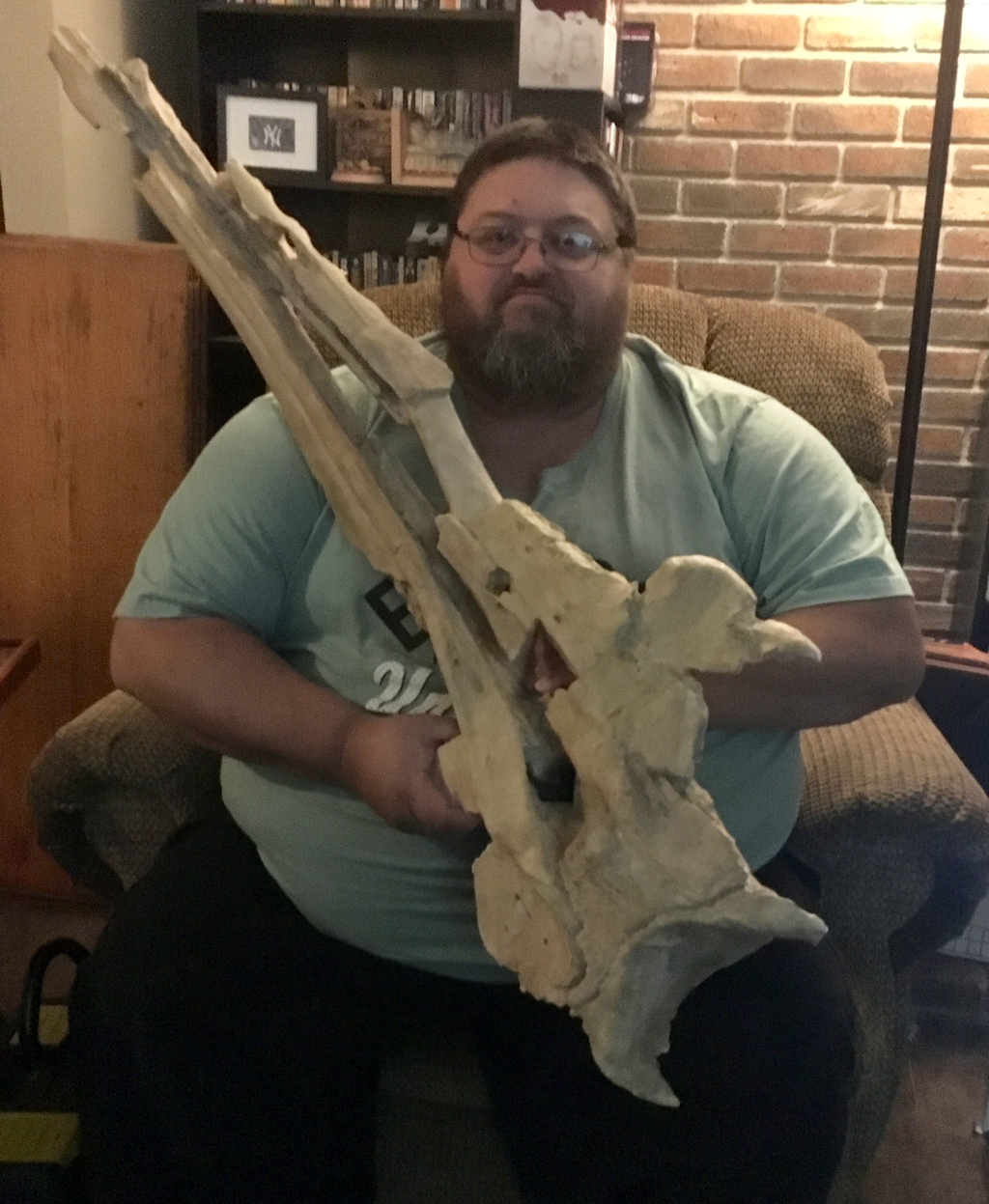 Usually we use our Fossil Friday posts to talk about specimens that are housed in the WSC collections. But today I'm going to talk about our newest 3D print, the skull of the primitive toothed whale Squalodon whitmorei.Squalodonts are a family of toothed whales that lived in the Oligocene and the first half of the Miocene. At one time it was thought they might be close to the transition between Eocene archaeocete whales and modern dolphins and other toothed cetaceans. It turns out they were their own specialized branch of toothed whales, members of a once widespread group called the platanistoids that has since been mostly supplanted by the delphinoids. They have a somewhat primitive look largely because of their extremely heterodont teeth, including serrated, triangular back teeth (hence the name Squalodon, which literally means "shark tooth"). They were among the last groups of cetaceans (maybe THE last group) to retain these triangular, double-rooted back teeth. They are best known from Europe and eastern North America, but examples have been found all over the world.This specimen holds a special place for me, because it was the first fossil vertebrate I ever had the chance to work on. In 1989 I traveled to the Smithsonian's National Museum of Natural History to talk about possible research topics for my senior thesis at Carleton College. I met paleontologists Clayton Ray, Frank Whitmore, and Dave Bohaska while I was there, and after a day of looking at fossils they suggested that if I wanted to I could come back next summer and work on squalodont whales for my thesis (a group I had never heard of before).The next summer, after securing free housing from a Carleton alumnus, Frank turned over to me several boxes of bone fragments that had been collected by a boy scout troop in Virginia in the 1970s. I spent the next 2 months learning techniques for cleaning and repairing fossils, while Frank tutored my on cetacean anatomy. By the end of the summer I had put together one of the most complete known skeletons of Squalodon, the largest example of the genus ever found:
Usually we use our Fossil Friday posts to talk about specimens that are housed in the WSC collections. But today I'm going to talk about our newest 3D print, the skull of the primitive toothed whale Squalodon whitmorei.Squalodonts are a family of toothed whales that lived in the Oligocene and the first half of the Miocene. At one time it was thought they might be close to the transition between Eocene archaeocete whales and modern dolphins and other toothed cetaceans. It turns out they were their own specialized branch of toothed whales, members of a once widespread group called the platanistoids that has since been mostly supplanted by the delphinoids. They have a somewhat primitive look largely because of their extremely heterodont teeth, including serrated, triangular back teeth (hence the name Squalodon, which literally means "shark tooth"). They were among the last groups of cetaceans (maybe THE last group) to retain these triangular, double-rooted back teeth. They are best known from Europe and eastern North America, but examples have been found all over the world.This specimen holds a special place for me, because it was the first fossil vertebrate I ever had the chance to work on. In 1989 I traveled to the Smithsonian's National Museum of Natural History to talk about possible research topics for my senior thesis at Carleton College. I met paleontologists Clayton Ray, Frank Whitmore, and Dave Bohaska while I was there, and after a day of looking at fossils they suggested that if I wanted to I could come back next summer and work on squalodont whales for my thesis (a group I had never heard of before).The next summer, after securing free housing from a Carleton alumnus, Frank turned over to me several boxes of bone fragments that had been collected by a boy scout troop in Virginia in the 1970s. I spent the next 2 months learning techniques for cleaning and repairing fossils, while Frank tutored my on cetacean anatomy. By the end of the summer I had put together one of the most complete known skeletons of Squalodon, the largest example of the genus ever found:
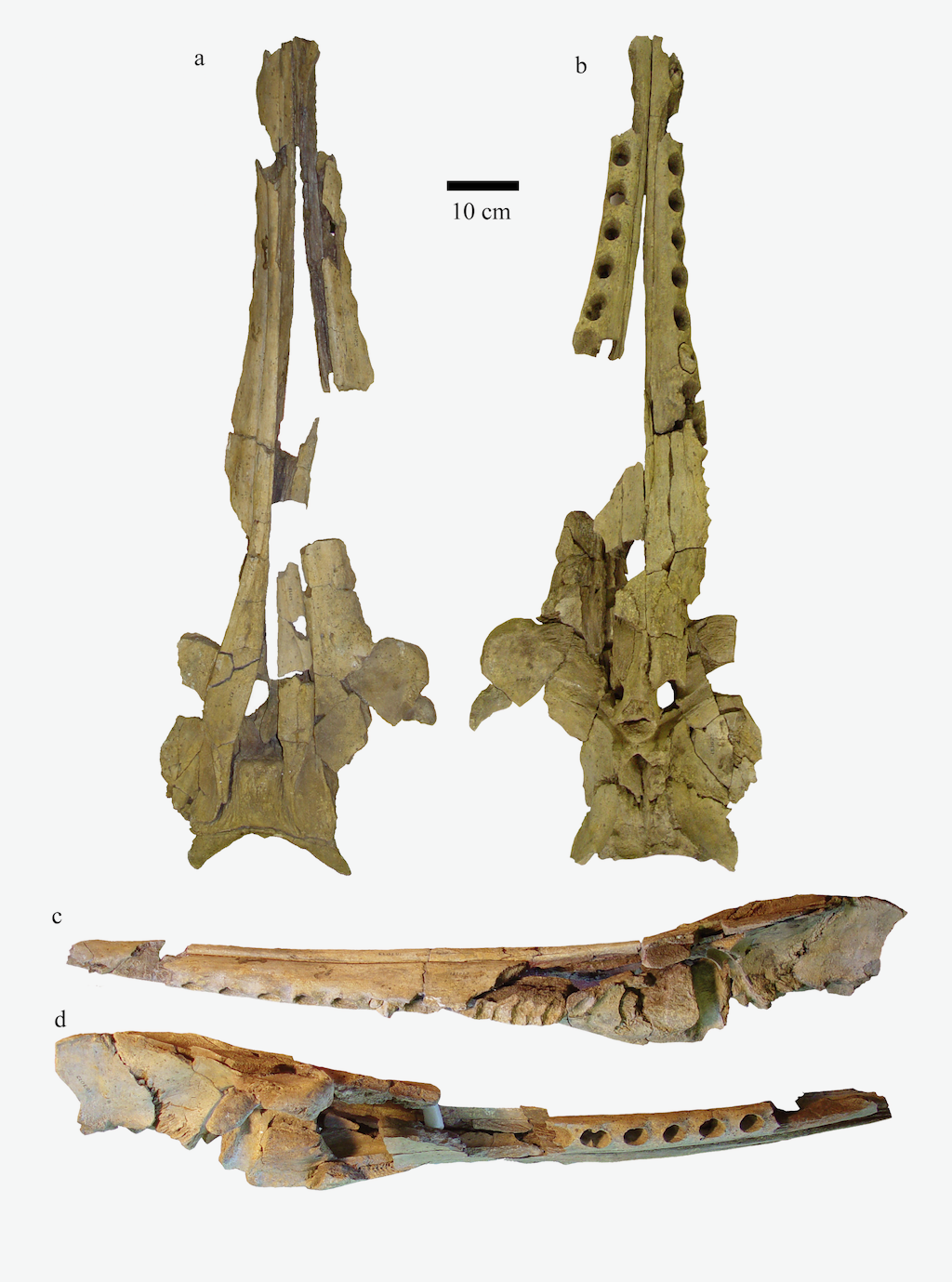 After successfully defending my undergraduate thesis, I enrolled in graduate school at LSU, and continued my work on squalodonts. This skeleton, along with an additional skull discovered in Virginia in the 1990's, became the main subjects in Chapter 4 of my doctoral dissertation.After completing my doctorate I accepted a position at VMNH, and spent some of my time finishing up projects I had started in graduate school. Finally, in 2005 I formally published "A new species of Squalodon (Mammalia, Cetacea) from the Middle Miocene of eastern North America". That paper established the new species Squalodon whitmorei (named in honor of Frank Whitmore), with this specimen as the holotype.As it turns out, in 2019 and 2020 Western Science Center will be opening two exhibits for which Squalodon whitmorei would be a perfect match. WSC is a Smithsonian Affiliate, so I put in a request through the Affiliates Program to get 3D scans of the skeleton. With their help we arranged to have Bernard Means, a Valley of the Mastodons alum and director of the Virtual Curation Lab at Virginia Commonwealth University visit the Smithsonian and begin scanning the skeleton. While there are still more bones to scan, the cranium has been completed and printed (in six parts) on our Lulzbot printers. Last night I finished painting the printed cranium, which is what I'm holding in the image at the top.We'll be using the printed skull in various education programs at WSC until it goes on exhibit next year.
After successfully defending my undergraduate thesis, I enrolled in graduate school at LSU, and continued my work on squalodonts. This skeleton, along with an additional skull discovered in Virginia in the 1990's, became the main subjects in Chapter 4 of my doctoral dissertation.After completing my doctorate I accepted a position at VMNH, and spent some of my time finishing up projects I had started in graduate school. Finally, in 2005 I formally published "A new species of Squalodon (Mammalia, Cetacea) from the Middle Miocene of eastern North America". That paper established the new species Squalodon whitmorei (named in honor of Frank Whitmore), with this specimen as the holotype.As it turns out, in 2019 and 2020 Western Science Center will be opening two exhibits for which Squalodon whitmorei would be a perfect match. WSC is a Smithsonian Affiliate, so I put in a request through the Affiliates Program to get 3D scans of the skeleton. With their help we arranged to have Bernard Means, a Valley of the Mastodons alum and director of the Virtual Curation Lab at Virginia Commonwealth University visit the Smithsonian and begin scanning the skeleton. While there are still more bones to scan, the cranium has been completed and printed (in six parts) on our Lulzbot printers. Last night I finished painting the printed cranium, which is what I'm holding in the image at the top.We'll be using the printed skull in various education programs at WSC until it goes on exhibit next year.
Fossil Friday - ground sloths & therizinosaurs
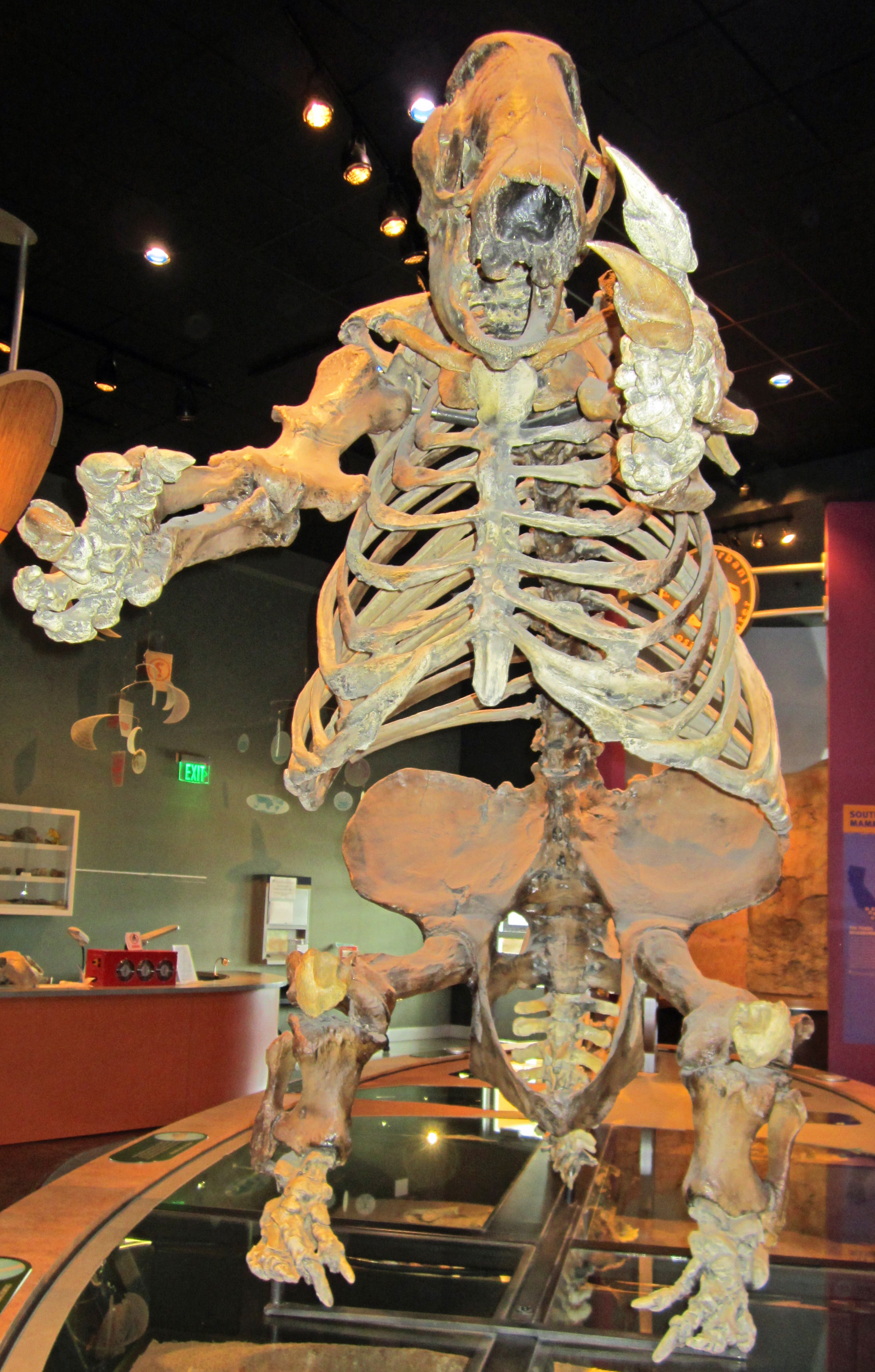 In many ways, dinosaurs and mammals are very different types of animal. And yet, there are some amazing cases of convergent evolution among them. One of the most bizarre is that of giant ground sloths and therizinosaurs. Like the little slow-moving, tree-dwelling sloths of today, giant ground sloths, like this Paramylodon mounted at Western Science Center, were herbivorous. As a group, sloths are related to armadillos and anteaters. Therizinosaurs, like this Nothronychus mounted at the Natural History Museum of Utah in Salt Lake City, are part of Maniraptora, a group of theropod dinosaurs that also includes predators like Velociraptor and our living dinosaurs, the birds. However, therizinosaurs evolved into big feathery herbivores.
In many ways, dinosaurs and mammals are very different types of animal. And yet, there are some amazing cases of convergent evolution among them. One of the most bizarre is that of giant ground sloths and therizinosaurs. Like the little slow-moving, tree-dwelling sloths of today, giant ground sloths, like this Paramylodon mounted at Western Science Center, were herbivorous. As a group, sloths are related to armadillos and anteaters. Therizinosaurs, like this Nothronychus mounted at the Natural History Museum of Utah in Salt Lake City, are part of Maniraptora, a group of theropod dinosaurs that also includes predators like Velociraptor and our living dinosaurs, the birds. However, therizinosaurs evolved into big feathery herbivores. 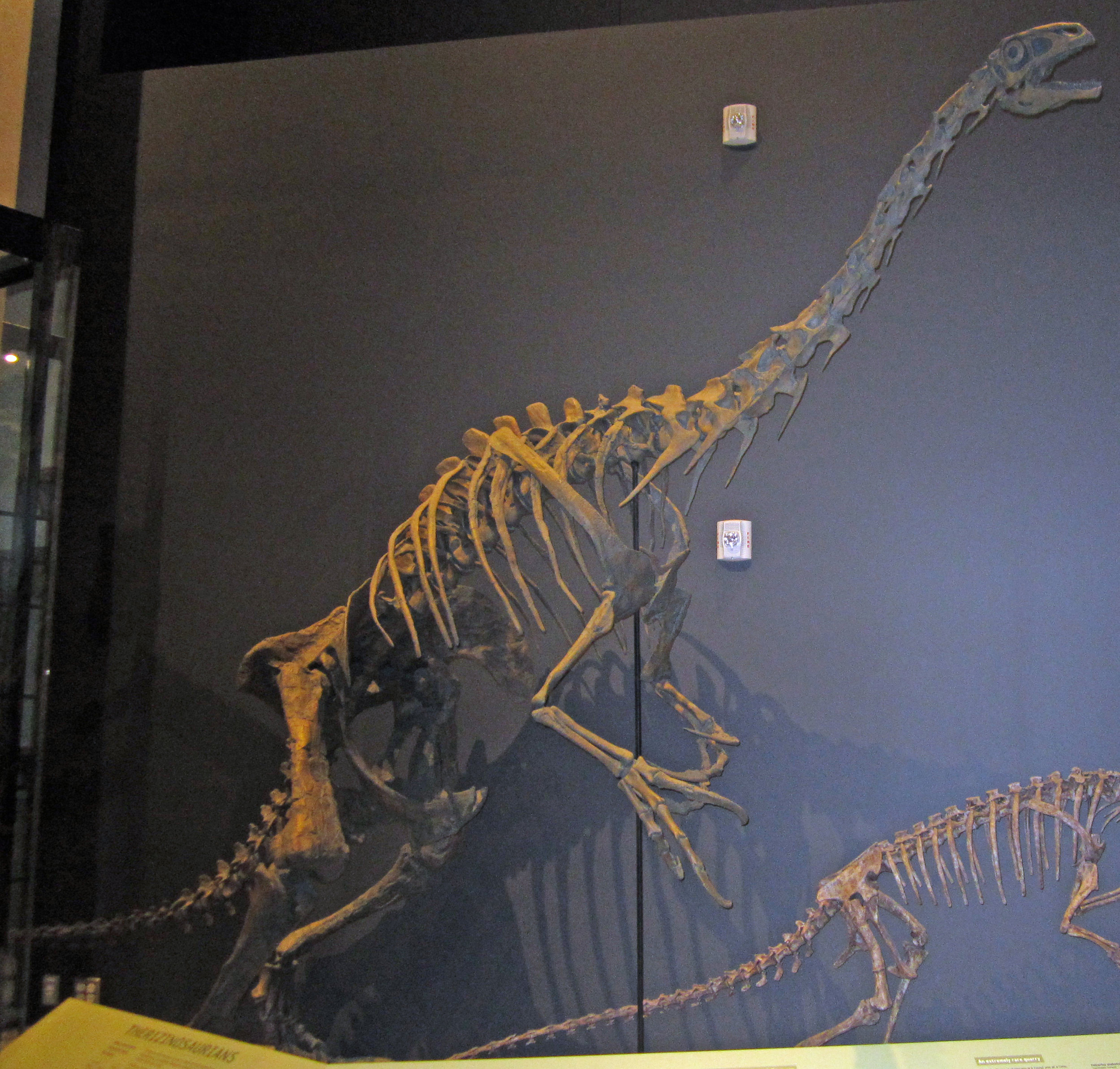 Despite their very different evolutionary origins, giant grounds sloths and therizinosaurs share some remarkable similarities: long arms ending in huge claws, wide bodies to accommodate a long digestive tract for processing plant matter, short robust legs, and short tails. Both groups evolved into large-bodied bipedal plant-eaters. Nothronychus was named in 2001 by my colleagues Jim Kirkland (Utah Geological Survey) and Doug Wolfe (Zuni Dinosaur Institute for Geosciences) - the name means "sloth claw".Another similarity is that both giant ground sloths and therizinosaurs represent migrations into North America from other places. Giant ground sloths evolved in South America and reached North America around nine million years ago. Until the discovery of 90-million-year-old Nothronychus in New Mexico, therizinosaurs were known only from fossils found in Asia. Nothronychus is closely related to the large Asian therizinosaurs and probably represents a migration event into western North America.Post by Curator Dr. Andrew McDonald
Despite their very different evolutionary origins, giant grounds sloths and therizinosaurs share some remarkable similarities: long arms ending in huge claws, wide bodies to accommodate a long digestive tract for processing plant matter, short robust legs, and short tails. Both groups evolved into large-bodied bipedal plant-eaters. Nothronychus was named in 2001 by my colleagues Jim Kirkland (Utah Geological Survey) and Doug Wolfe (Zuni Dinosaur Institute for Geosciences) - the name means "sloth claw".Another similarity is that both giant ground sloths and therizinosaurs represent migrations into North America from other places. Giant ground sloths evolved in South America and reached North America around nine million years ago. Until the discovery of 90-million-year-old Nothronychus in New Mexico, therizinosaurs were known only from fossils found in Asia. Nothronychus is closely related to the large Asian therizinosaurs and probably represents a migration event into western North America.Post by Curator Dr. Andrew McDonald
Fossil Friday - creodont skull
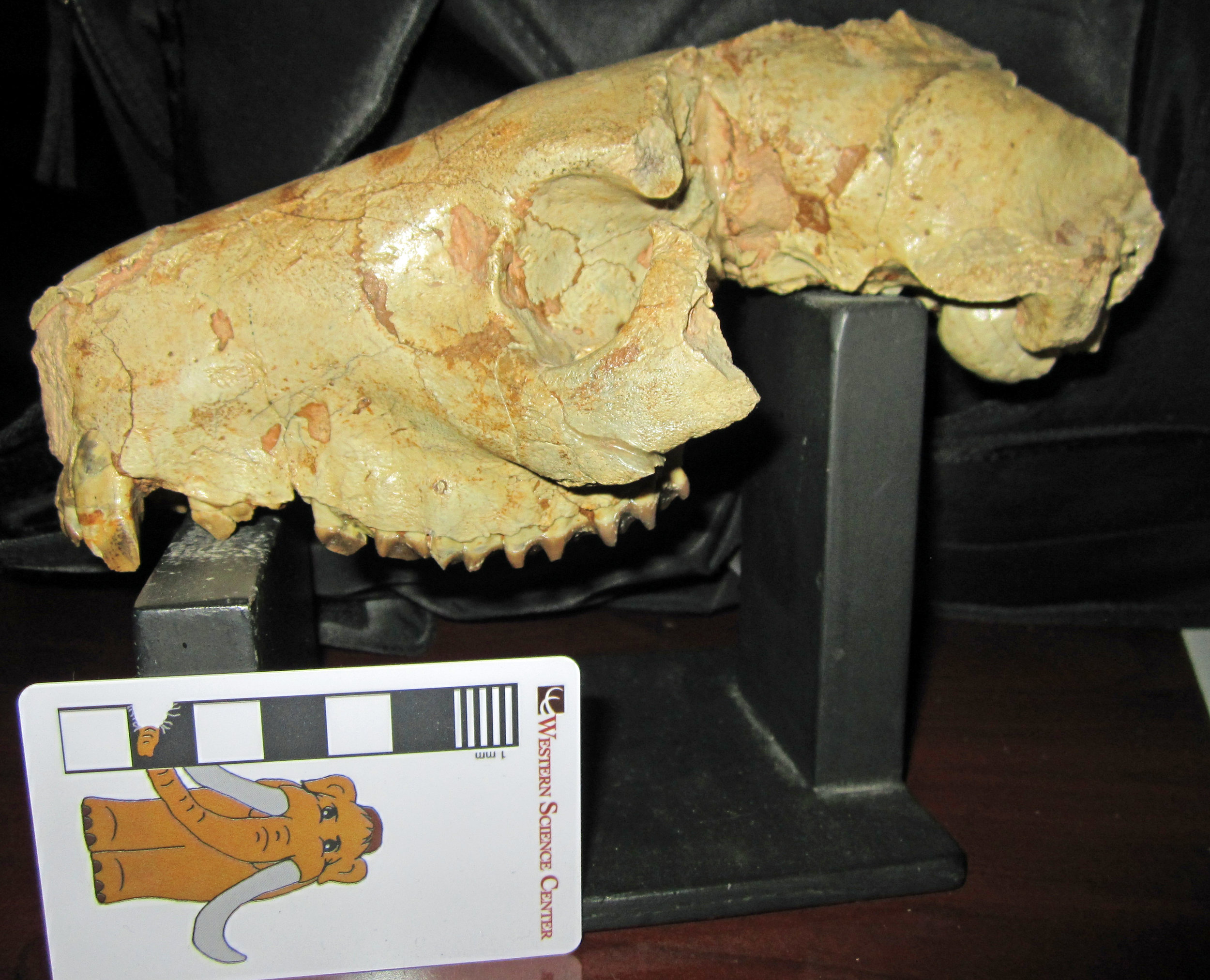 Most of the extinct mammals in the Western Science Center's collection are Pleistocene Ice Age creatures, such as mastodons, Columbian mammoths, bison, camels, horses, and giant ground sloths, dating to between 50,000 and 14,000 years ago. Today's Fossil Friday is a much older extinct mammal, dating back to around 30 million years ago, a slice of geological time known as the Oligocene. This is the skull of an oreodont, a totally extinct group of even-toed ungulates (Artiodactyla) related to camels.This particular skull was discovered in 1963 in South Dakota by renowned local fossil hunter Harley Garbani and donated to the Western Science Center by his wife, Mary. Oreodonts were extremely abundant and diverse plant-eaters in the Oligocene of North America. This skull belongs to an oreodont called Merycoidodon, which was extremely common in South Dakota at this time.
Most of the extinct mammals in the Western Science Center's collection are Pleistocene Ice Age creatures, such as mastodons, Columbian mammoths, bison, camels, horses, and giant ground sloths, dating to between 50,000 and 14,000 years ago. Today's Fossil Friday is a much older extinct mammal, dating back to around 30 million years ago, a slice of geological time known as the Oligocene. This is the skull of an oreodont, a totally extinct group of even-toed ungulates (Artiodactyla) related to camels.This particular skull was discovered in 1963 in South Dakota by renowned local fossil hunter Harley Garbani and donated to the Western Science Center by his wife, Mary. Oreodonts were extremely abundant and diverse plant-eaters in the Oligocene of North America. This skull belongs to an oreodont called Merycoidodon, which was extremely common in South Dakota at this time.
Fossil Friday - juvenile hadrosaur jaw
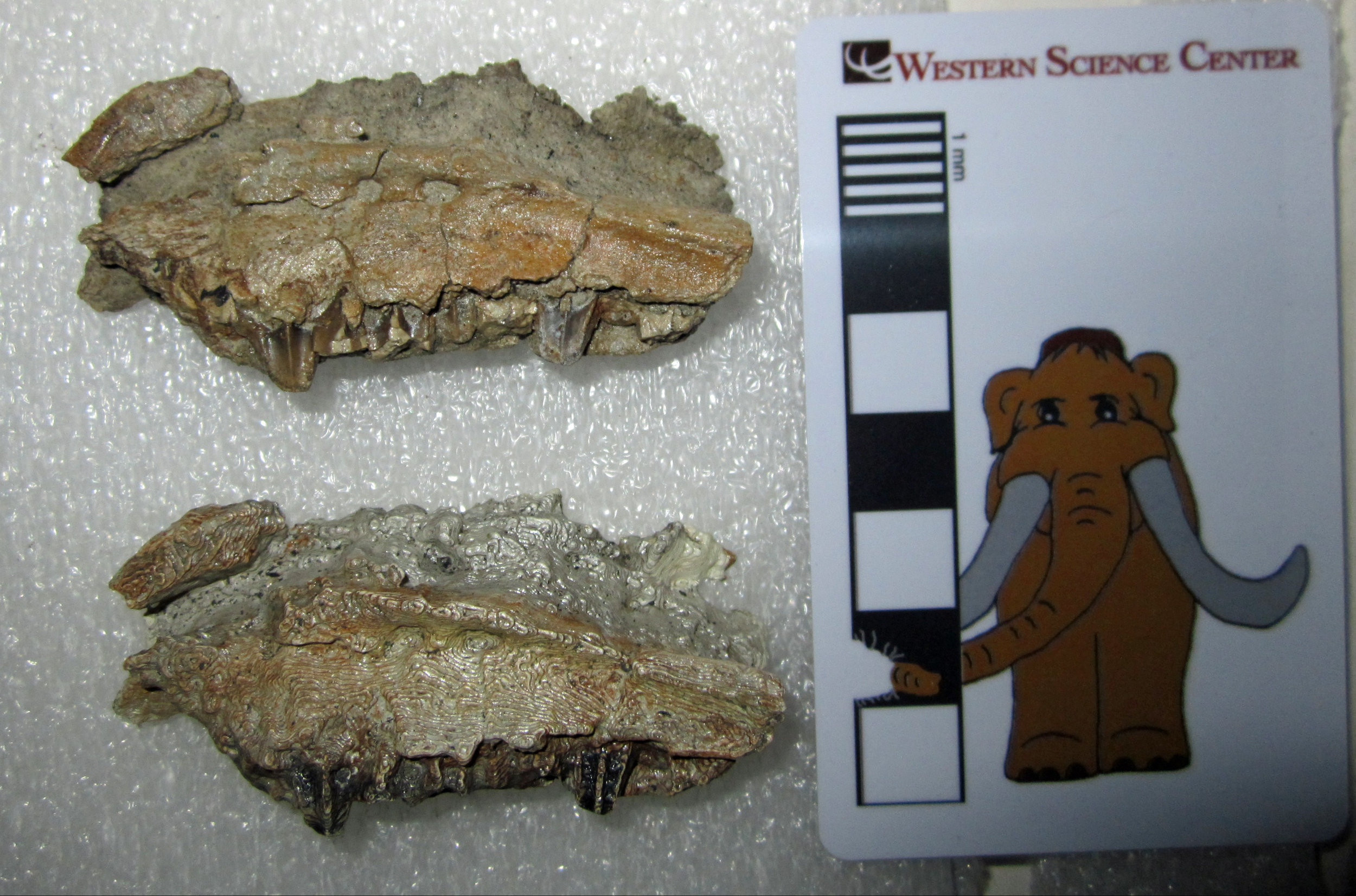 Last week, five staff members from the Western Science Center, including yours truly, traveled to Albuquerque to attend the 2018 Society of Vertebrate Paleontology conference. We presented six posters on the research, outreach, and educational activities taking place at the museum. Three of the posters dealt with fossils discovered in the Menefee Formation of New Mexico, including the new dinosaurs Invictarx (https://valleyofthemastodon.wordpress.com/2018/08/24/fossil-friday-invictarx-zephyri/) and Dynamoterror (https://valleyofthemastodon.wordpress.com/2018/10/12/fossil-friday-dynamoterror-dynastes/). We presented this research with our colleagues from Zuni Dinosaur Institute for Geosciences and Southwest Paleontological Society.This beautiful little bone was the subject of a poster led by Kara Kelley, who has been participating in Menefee expeditions since 2012 and is now an undergraduate at the University of Arizona - Tucson. It's the left maxilla (upper jaw bone) from a very young, very small hadrosaur, which Kara discovered in 2016. Bones of baby dinosaurs are often rare, and this remains the only such bone we have collected in the Menefee Formation so far. In the image, the outer surface of the bone is shown, with a row of tiny teeth along the bottom. The animal's snout would be towards the left of the image, and the back of the skull towards the right. We can't yet tell exactly what kind of hadrosaur this little maxilla belongs to, but it does provide information on the anatomy of a young hadrosaur that lived 80 million years ago.And lest you think that we have two tiny hadrosaur maxillae, the bottom one is actually a painted 3D-print that we created here at Western Science Center through photogrammetry. Now we have a replica of the maxilla that we can take to events and conferences to show people and highlight just one of the many research projects unfolding here at the museum.Andrew McDonald
Last week, five staff members from the Western Science Center, including yours truly, traveled to Albuquerque to attend the 2018 Society of Vertebrate Paleontology conference. We presented six posters on the research, outreach, and educational activities taking place at the museum. Three of the posters dealt with fossils discovered in the Menefee Formation of New Mexico, including the new dinosaurs Invictarx (https://valleyofthemastodon.wordpress.com/2018/08/24/fossil-friday-invictarx-zephyri/) and Dynamoterror (https://valleyofthemastodon.wordpress.com/2018/10/12/fossil-friday-dynamoterror-dynastes/). We presented this research with our colleagues from Zuni Dinosaur Institute for Geosciences and Southwest Paleontological Society.This beautiful little bone was the subject of a poster led by Kara Kelley, who has been participating in Menefee expeditions since 2012 and is now an undergraduate at the University of Arizona - Tucson. It's the left maxilla (upper jaw bone) from a very young, very small hadrosaur, which Kara discovered in 2016. Bones of baby dinosaurs are often rare, and this remains the only such bone we have collected in the Menefee Formation so far. In the image, the outer surface of the bone is shown, with a row of tiny teeth along the bottom. The animal's snout would be towards the left of the image, and the back of the skull towards the right. We can't yet tell exactly what kind of hadrosaur this little maxilla belongs to, but it does provide information on the anatomy of a young hadrosaur that lived 80 million years ago.And lest you think that we have two tiny hadrosaur maxillae, the bottom one is actually a painted 3D-print that we created here at Western Science Center through photogrammetry. Now we have a replica of the maxilla that we can take to events and conferences to show people and highlight just one of the many research projects unfolding here at the museum.Andrew McDonald
Fossil Friday - Dynamoterror dynastes
Welcome Dynamoterror dynastes!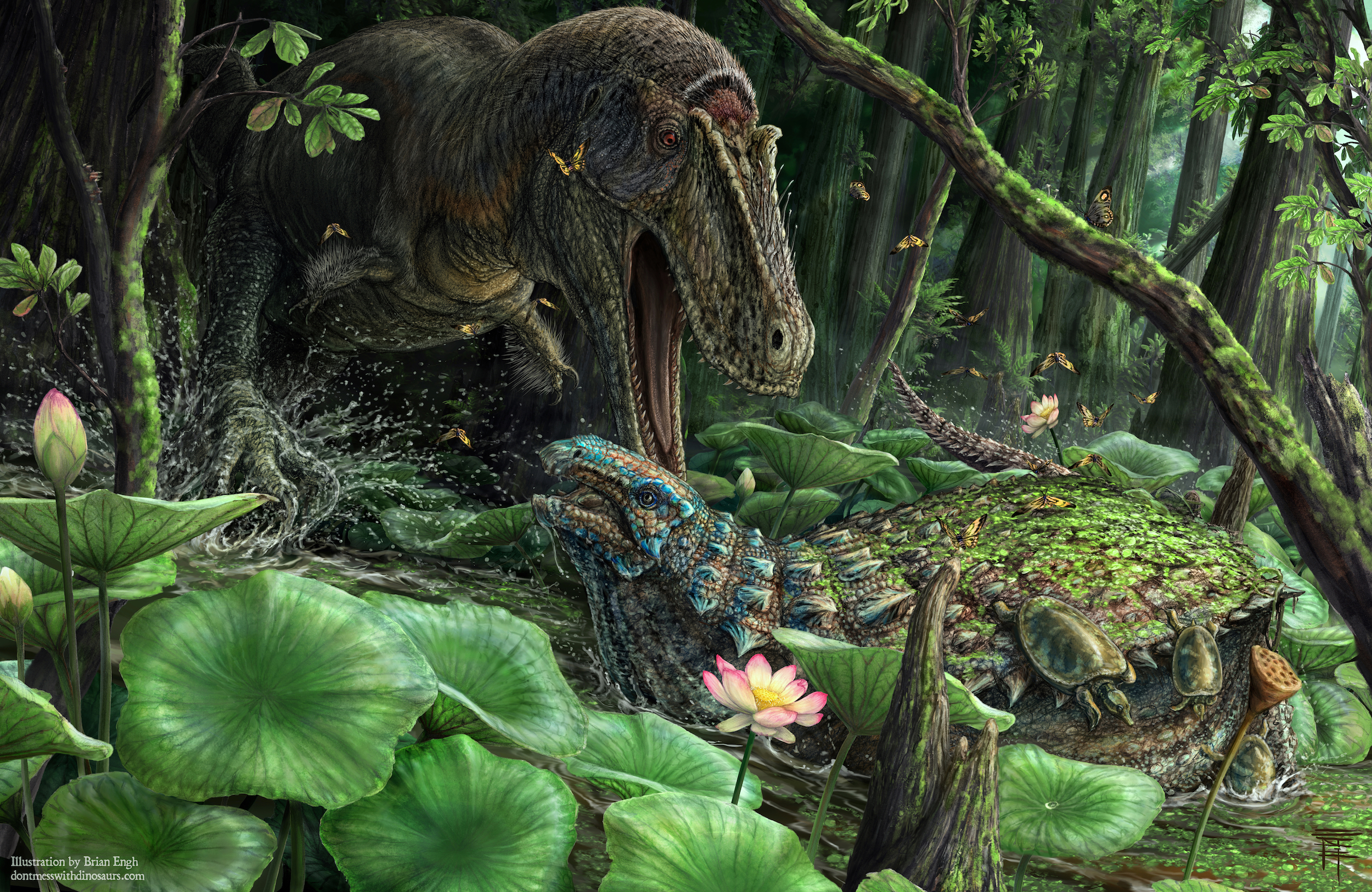 This is another very special Fossil Friday for Western Science Center and our colleagues at Zuni Dinosaur Institute for Geosciences and Southwest Paleontological Society. Hot on the heels of our new armored herbivorous dinosaur, Invictarx zephyri comes this new tyrannosaur. Like Invictarx, Dynamoterror lived 80 million years ago in what is now New Mexico and is published in the online open-access journal PeerJ. Dynamoterror is known from an incomplete skeleton that includes bones from the skull, hand, foot, and many other fragments.
This is another very special Fossil Friday for Western Science Center and our colleagues at Zuni Dinosaur Institute for Geosciences and Southwest Paleontological Society. Hot on the heels of our new armored herbivorous dinosaur, Invictarx zephyri comes this new tyrannosaur. Like Invictarx, Dynamoterror lived 80 million years ago in what is now New Mexico and is published in the online open-access journal PeerJ. Dynamoterror is known from an incomplete skeleton that includes bones from the skull, hand, foot, and many other fragments.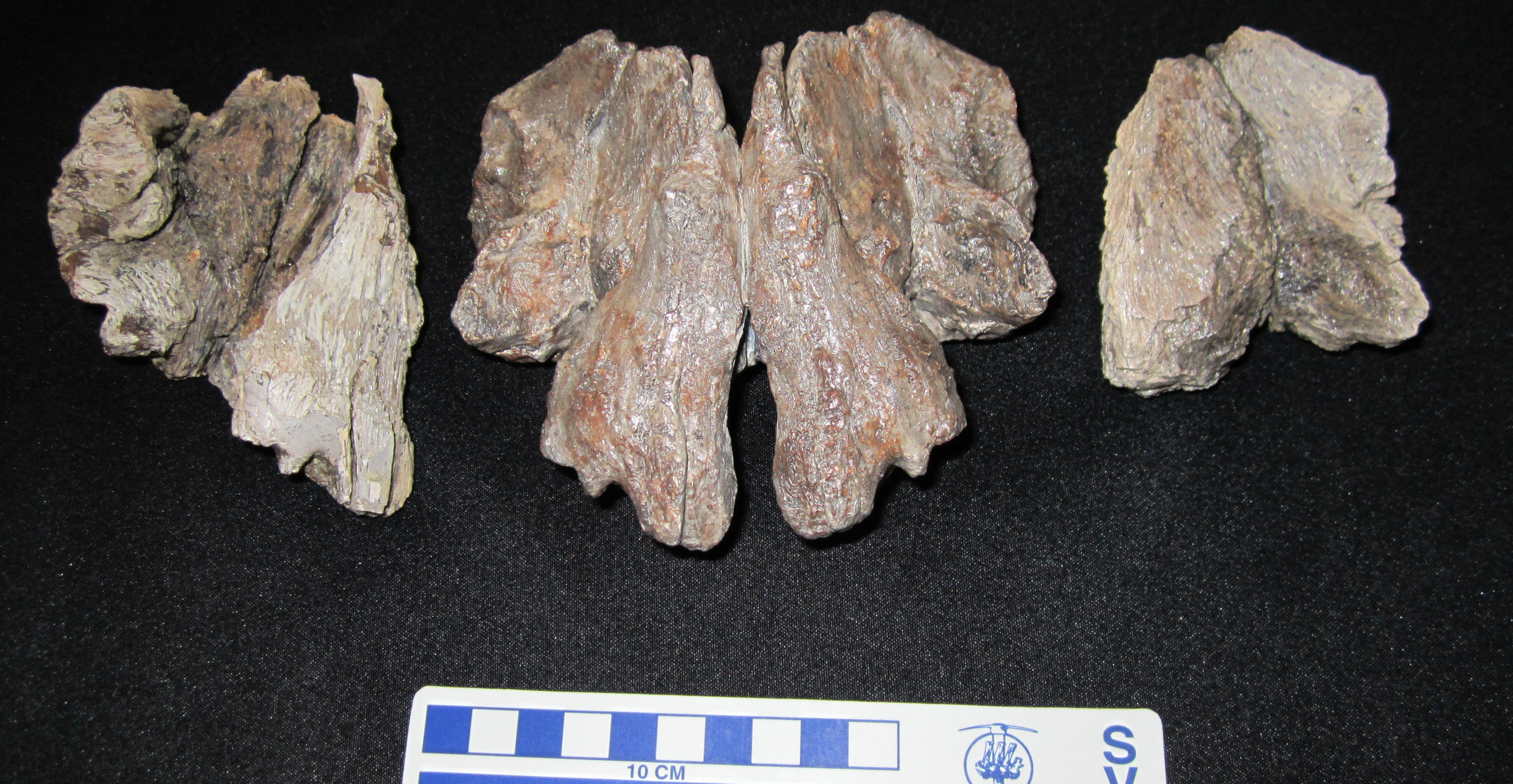 The first image shows the two frontal bones from the top of the skull of Dynamoterror (left and right) and the 3D-print of the composite frontals created at Western Science Center (center). We made the 3D-print by laser-scanning the actual fossils, building 3D digital models of them, and then mirroring and combining the models based upon overlapping anatomical features preserved on both frontals. This 3D-print helped us refine our interpretation of the anatomy in this region of the skull and is a nifty item to share at public events!Dynamoterror lived at the same time and place as Invictarx and the hadrosaur I have posted for Fossil Friday the last three weeks, and probably was quite a threat to them. Paleoartist Brian Engh has depicted a less than friendly encounter between Dynamoterror and Invictarx in a spectacular piece of artwork.Post by Curator Dr. Andrew T. McDonald.
The first image shows the two frontal bones from the top of the skull of Dynamoterror (left and right) and the 3D-print of the composite frontals created at Western Science Center (center). We made the 3D-print by laser-scanning the actual fossils, building 3D digital models of them, and then mirroring and combining the models based upon overlapping anatomical features preserved on both frontals. This 3D-print helped us refine our interpretation of the anatomy in this region of the skull and is a nifty item to share at public events!Dynamoterror lived at the same time and place as Invictarx and the hadrosaur I have posted for Fossil Friday the last three weeks, and probably was quite a threat to them. Paleoartist Brian Engh has depicted a less than friendly encounter between Dynamoterror and Invictarx in a spectacular piece of artwork.Post by Curator Dr. Andrew T. McDonald.

